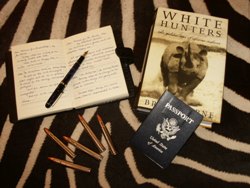

 The Accurate Reloading Forums
The Accurate Reloading Forums  THE ACCURATE RELOADING.COM FORUMS
THE ACCURATE RELOADING.COM FORUMS  Hunting
Hunting  Hunting Reports - Africa
Hunting Reports - Africa  Zimbabwe 2010 - 2 Charges, Elephant, Croc & LOTS of Pictures
Zimbabwe 2010 - 2 Charges, Elephant, Croc & LOTS of PicturesGo  | New  | Find  | Notify  | Tools  | Reply  |  |
| one of us |
HUNT SUMMARY Trip Dates: May 16 – May 27, 2010 + Travel Location of Hunt: Omay North Communal Hunting Concession, Zimbabwe Animals Shot: Elephant Bull Crocodile Elephant Cow Hippo Outfitter/PH: Martin Pieters Safaris Email: martin@bulembisafaris.co.zw Landline Phone (from US): 011-263-9-67792 or 011-263-9-245783 Website: http://www.martinpieterssafaris.com/ Cameramen Roy Aylward Travel Summary: Airlines: South African Airlines Itinerary: Dulles (Wash DC) to Johannesburg to Bulawayo EQUIPMENT SUMMARY Heavy Rifle: Ruger Mark II .458 Lott Heavy Rifle Ammunition: Hand-loaded .450gr Barnes Flat Point & .500gr Woodleigh Solids Light Rifle: Whitworth .375 H&H w/Leupold 2.5-8 x 32mm Scope Light Rifle Ammunition: Hand-loaded .270gr Barnes TSX Softpoints & Norma Factory 350gr Woodleigh Solids (.375) Boots: Lowa Zephyr GTX Socks: Smartwool Light Hikers Shorts: Columbia Sportswear Cascade Creek Water Shorts Shirts: Under Armor Tactical & HeatGear Shortsleeve T’s (Marine Green) Compact Camera: Olympus Stylus Tough 6000 Satellite Phone: Iridium (rented from Outfitter Satellite) DISCLAIMER I love Africa - the animals, the people and the land, I always have. Please consider when reading this report that this was my 13th trip to Africa, and that my experiences and perspectives may very likely differ from yours. I will attempt to provide honest and sincere insight and information, current at this point in time but subject to change, as well as opinions and suggestions that not everybody is going to agree with. Heck, I have come full-circle on enough topics to know that in a few years I likely will not agree with everything that I write here! As with all my postings on AR, I try to not “preach” but support my positions with experiences, explaining how and why I have come to a certain opinion. While perhaps not lacking in confidence, I am far from arrogant and in fact have a difficult time talking about myself and accomplishments even to close friends. I do enjoy writing though. I hope nothing in this report comes across as pompous or self-righteous, as it is absolutely not my intention nor style. Now ask me about my kids, and then you will get an earful! Those who have hunted for some time will be aware that there are different stages that one goes thru over the course of a hunting career. For me I have plenty of trophies on the wall and sitting around the house (just ask my dear wife!) and I am most interested in the experience and adventure of the hunt. I have learned that this can often be considerably more elusive than a 40-inch hard-bossed buffalo or a 55-inch free-range kudu, as it is personal and ever-changing. This being said, I will never turn down a “trophy of a lifetime” if one should present itself. Lastly, I am not a booking agent nor involved in the hunting industry in any way. Like most, I am a paying client with a finite budget and limited time, making sacrifices in other areas of my life so that I am able to do what I enjoy most – sharing the experience if at all possible with those that I love. Please feel free to contact me via pm with any particular questions, and I will be happy to help. TRIP BACKGROUND I had a very successful elephant with Martin Pieters in March 2009, and after looking at a couple of options, I decided to return with Mart in 2010 and build a hunt around a crocodile. Link to Last Year’s Report: http://forums.accuratereloadin...6321043/m/2731047601 A bit of background on Martin: Licensed in 1993, Mart has been hunting professionally for ~17 years. Much of his experience was in Botswana, hunting big-bodied tuskers on big-dollar hunts in some of the finest elephant hunting concessions in the world (some of which are now closed to hunting). Martin is active in the hunting community, and currently serving on the board of the Zimbabwe Professional Hunters Association (ZPHA), and is a member of the National Parks committee that evaluates and licenses new professional (“appy”) hunters. Several years ago I had an opportunity to shoot a croc while on a lion hunt in the Lower Lupande concession of Zambia, which borders the Luangwa River. While there are a lot of croc’s in the river, and the trophy fee at the time was pretty cheap ($1200 as I recall), the expectations were for a 10 foot croc, and I just had a hard time getting excited about “baiting-and-waiting”. My PH was not an avid croc hunter, considering them vermin, so we hunted a second buffalo instead. Fast-forward 5 years, and I found myself reconsidering my impression of croc hunting. There has been some massive croc’s posted on AR, mostly from Mozambique, and the idea of an old croc for the trophy room started sound pretty good to me and my two sons. My wife even thought it would be cool, which was all the convincing I needed! In talking with Mart, we would have several hunting options available including baiting, and spot/stalking via foot and boat around Lake Kariba and the Ume River. This was good as I worried about my ability to stay-put in a blind for any length of time. Initial plans were to backpack and spike camp for 3-4 days into the hills along the boundary with the Matusadona National Park in search of sable and buffalo, but a buggered hip forced me to abandon this and instead add a tuskless elephant and whatever else we came across assuming Martin had available quota. Throw in some fishing in Kariba and maybe some site-seeing after the hunting, and we had a full agenda. The highlight of the trip for me would be having my youngest son along. Both boys are now in college and busy getting on with their own lives which is wonderful, and we don’t get to spend the time together that we used to. Bill Jr and I hunted Makuti in 2008, so it was Brett’s turn for this safari. I scheduled the hunt for the week after his freshman year at Penn State ended and before the World Cup Soccer frenzy in June. This would be Brett’s 4th trip to Africa, and 3rd to Zimbabwe. People have said how lucky the boys are, and this is true, but I feel that I am the most fortunate one having an opportunity to spend quality time with my two sons in the bush, far away from distractions and in a neutral environment where we are all a little bit out of our element. We strive to seek the adventure and focus on the experience, keeping busy and moving during the entire trip. It is amazing how much one can pack into 12 or 14 days. It has been great for our relationship, and their upbringing in ways which I will not go into but are significant and meaningful. And who knows, maybe one day they will return the favor! PHYSICAL CONDITIONING & RELATED CONSIDERATIONS Last year it was a bit difficult to get into proper shape for my early-season March hunt, but with two extra months of good weather, it was easier this time. I stay active year round, but turn it up a few notches in the 3-4 months prior to a trip. It is wonderful motivation to stay in decent condition, otherwise I think it would be easy to let things slide to a point that getting back into shape would be a real chore. This being said, a hectic schedule at the office and a nagging hip made it a bit of a challenge to find the time to train. I cut back on the hiking, did a lot more stretching, and rode my bike all winter long, averaging (2) times a week, but kept the rides to 1.5-2hrs tops while focusing on hills. This, plus upper-body weightlifting (5) times a week rounded out my approach, and I arrived in pretty good condition. One does not need to be triathlete to hunt Africa, which is one of the great things about a safari. Excluding ranch hunts perhaps, chances are 95% plus that YOU, the hunter, will be the limiting factor on YOUR hunt. A good PH will be fit and keep going no matter what, and you will not out walk the trackers. You/me will pretty much determine how much ground is covered and how many hours are spent in the field. The more walks one can do, the more mornings one can get out of camp before sunrise, typically the “luckier” one will be. Generally speaking, hunting in Africa is not “hard”, and it is possible for the trophies to come easy with the majority of hunting done via vehicle. Some areas lend themselves quite well to this hunting method – and in fact this may be the only prudent way to hunt them. But there is also the potential to have a very physical hunt, and in my experience an elephant tracking hunt with a walking PH during certain times of the year can be every bit as difficult as a typical North American mountain hunt. Ditto with buffalo hunts, I’ve had easy ones, and I had a few that were a struggle given the condition that I was in at the time. Too, time zone differences, new foods, anti-malaria meds, lack of sleep, the heat, and hunting at somebody else’s pace (which is different than a DIY hunt) all conspire to zap the energy of even the most fit and prepared hunters, regardless of age or conditioning. The note is to make sure that you consider the physicality of the hunt when selecting a Professional Hunter, country and specific area, and to a lesser extent the time of the year and the impact it has on the field conditions and game. This way you will have the most satisfying experience possible and not be disappointed that your PH is a diesel stalker when you wanted to be on foot, or conversely be pushed beyond your capabilities. If you have limitations, be honest, make sure this is known upfront, and remind the PH when you get there. Hunting Africa is supposed to be enjoyable, and it is no fun suffering needlessly. I say all this because every trip I hear stories and witness situations that could have been avoided if a little more thought would have been put into this aspect of the trip, by the hunter and/or the booking agent. TRAVEL TO BULAWAYO From Pennsylvania, we drove to Dulles International Airport. Originally we were to fly an Airbus A340-600, but when we arrived at the SAA ticket counter in Dulles we were advised that the plane had been downsized, and that my handpicked seats reserved months in advance were going to be reassigned. Fortunately we were early for check-in, and I was able to get two seats right around the wing, as otherwise my son and I get quite green over the course of the flight. The flight was 1.5hrs late in departing due to regional thunderstorms, which likely caused a problem for anybody making tight connections in Johannesburg, but was not an issue for us other than prolonging the total seat time. The crew was very polite, the selection of movies good, and the food not all that bad. As soon as I get on the plane, I adjust the time on my watch to the final destination, in this case +6 hours EST. The plan was to stay awake for the first leg of the trip, and try to sleep after the stop in Dakar. With the help of some Ambien, this worked pretty well and we arrived at OR Tambo International Airport around 6pm on the 13th. The airport has changed quite a bit over the past few years, and they have obviously expanded the capacity in preparation of the World Cup as there was plenty of agents on hand to process our plane. One first clears Immigration, noting that no Customs Form was required upon entry, typically a form is handed out on the plane that must be completed, not a huge deal but after 18hrs plus of travel any reduction to the paperwork is appreciated. Next you pick up your luggage, and thankfully all ours arrived. I plan for the worst here, and pack everything I absolutely need, plus anything of value in a carry-on backpack, so that if my bags do not make it, I have what I need to proceed with the hunt. As my son was along, I had extra baggage allowance, and distributed our clothes and other items between two cases to lessen the impact if one went missing. It got a bit confusing here, as although the baggage claim area is relatively new and very open, there was no signage advising where one is to retrieve the gun cases. There were quite a few hunters on our plane, so eventually we worked it out. The rifle and bow cases were collected by an agent as they came off the conveyor, and staged until everything was offloaded. They were then transported to a SAPS holding area within the baggage claim area, where we were to point to our case so that it could be moved off to the side. We then had to line-up and provide information to another agent who completed a log book, at which point we could exit the baggage claim area and proceed to Customs. We were advised to follow the “Green” line (nothing to declare), at which point you exit the secure area. Here we were met by a representative of the Afton’s House firearms permit service (VIP Gunpermits), and whisked off to the SAPS office located to the right of the main airport area. I had arranged for Annelise to procure our SAPS 520 ahead of time, and this worked out very well. Instead of DHL’ing everything, I was able to scan and email the necessary documentation to Annelise. These documents included: (1) Invitation Letter from my outfitter in Zimbabwe; (2) Authorization letter for VIP to apply for the permit on my behalf; (3) Notarized copy of my passport and US Customs form #4457; (4) Copy of my airlines E-Ticket, and (5) Completed SAPS 520 form as downloaded from the Afton House’s website. As it always seems that things get ultra-busy at the office and home before a trip as I try to get everything lined-up so that things run smoothly, I found this paperwork to be a real hassle. However, I am glad that I did it ahead of time, and it was well worth the ~$100 as we zipped in and out of the SAPS office ahead of the others who were completing their paperwork onsite, noting I counted a total of (20) rifle/bow cases. If anybody is making a connection in Johannesburg, including a domestic flight, I would consider having a service assist with the SAPS 520 “mandatory” as at least two groups of hunters were going to be missing their connecting flights as a result of the flight delay and backlog in obtaining and processing their paperwork. It had been several years since I stayed at the Afton House, as my recent hunts have allowed me to connect the same day to my final destination, typically Harare. There are pros and cons to overnighting in Joburg, the advantages being that there are no concerns regarding flight delays and it allows some additional time for lost baggage to be located noting that if the bags do not make the flight, an overnight is of little benefit as by the time the next flight arrives the following day you will probably have already departed. But one does get to claim the bags, and at least know that they made it across the pond. An overnight in Joburg allows for an additional day to reset the body clock, and breaks the travel up a bit. On the other hand, connecting thru allows one to check bags to the final destination, and get the travel out of the way. As I was flying into Bulawayo to meet and drive to camp with Martin, overnighting was my only option as like Vic Falls there was no evening flight. In the end, it worked out fine and we woke the following day full of energy and ready for the short ~1hr flight to Bulawayo. Annelise Bekker: aftongh@netactive.co.za Website: http://www.aftonguesthouse.com The Afton Guest House, in Johannesburg South Africa 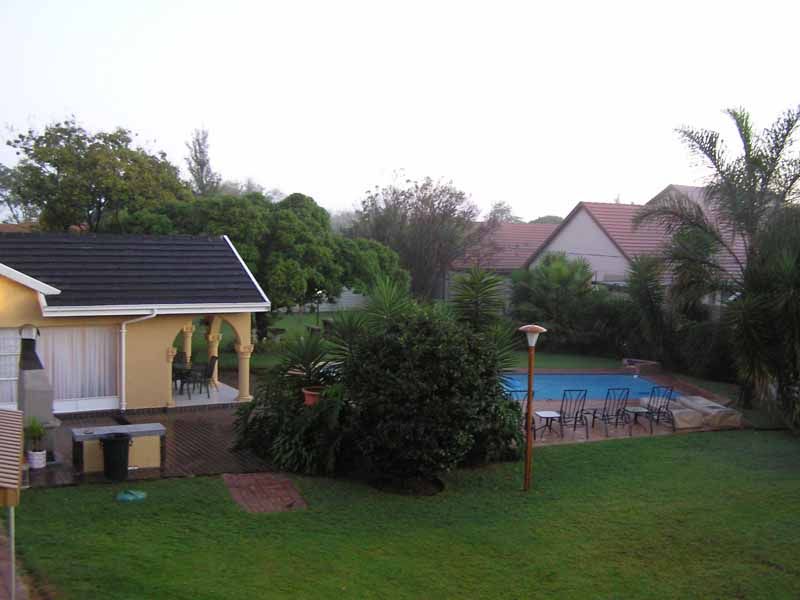 Once again, the Afton House helped everything to run smoothly, and after breakfast we were off to the airport and the “SAA Link” desk (off to the right of the first SAA desk encountered when entering the Departures area) for our 11:40am flight. We got a bit twisted up, as the SAA agent pointed us to a SAPS office which turned out to be for domestic flights only. We then back-tracked and went upstairs to the correct SAPS office and checked the rifle case for the flight. The plane to Bulawayo was a very comfortable British built (they make planes?!?!) plane with plenty of room and very cushy seats. I have been thru Harare and Vic Falls, as well as other airports in Africa, but this was my first trip to Bulawayo. The temporary terminal is an old hanger, as apparently the new terminal has been under construction for some time. Brett asked one of the guys when it was going to be completed, to which he replied “about 2 weeks”. Mart later said that it has been years so far, with no completion date in sight. Despite the usual African chaos, we got our visa’s, collected our luggage, and completed the Firearms Permit paperwork. This was the first time I ever had to count the ammunition upon entry, and I suspect it was because of “enhanced security” surrounding the World Cup. Mart was not allowed to enter the area, but he stuck his head in the door and once I saw his big grin I knew I was on the home stretch. Link to the Zimbabwe Firearms Permit - Download and complete 3 copies, do not sign until in front of the agent: [missing link] One note is that technically the operators are to provide a “Tourist Form” (NP11?) form upon entry to Zimbabwe. This is tricky, as most often they are not at the airport of arrival, and even if they are they are not permitted to enter the secure area, so what Mart did was to have it delivered by one of the airport porters. This is as probably a good a time as any to describe what my approach and philosophy is on “tipping” while traveling. I know some guys are morally against handing out tips for what they consider tasks related to doing ones job. I cannot argue with this and would never try to convince anybody otherwise. I avoid paying “bribes” to people who are obviously scamming travelers, such as those officials responsible for handling the firearms. I have felt that I had to do this in trips past, and although frustrating, my rifles always made it on the plane. However, I am happy to give a porter, waiter, hotel clerk, etc a few Dollars providing they perform a service, preferably with a smile. Tipping is the African way, and when in Rome… What I do is carry a separate wad of $1’s, $5’s and a few $10’s in my right pants pocket, folded with $1 out, and tip from this. The key is to bring enough small denomination bills, as it seems I never have enough and at some point where I would slip a guy a few bucks for a service provided, I end up giving more (or nothing) because I ran out of smaller bills. The further one gets into the bush, the more a few bucks is appreciated, although with the Dollarization in Zimbabwe, a Dollar does not go as far as it did a few years ago (per my notes, the recommended tip for the Omay North camp staff, per a list supplied by Martin naming all ~25 employees and their position and cut, went up by about $150 as compared to last year, from $250 to $400, noting that individually most received a relatively small amount). BULAWAYO After greeting my long-lost friends, Martin and Dalton, and introducing my “little boy”, we were off for the Bulawayo Club. Immediately I noticed something different from my five previous trips to Zimbabwe – there were cars on the road!!! During the course of the trip, I marveled at how much the economy has improved since even my last visits in 2008/09. Not too long ago, the roads, gas stations and store shelves were all empty. This was not the case now, providing one has US Dollars, there did not seem to be shortages of any staples, and in fact the places where we stopped were well-stocked including meats and baked goods. The downtown section of Bulawayo was bustling with activity, cars and people everywhere. Ditto with the little towns encountered while driving thru Zim, there was movement and action everywhere. There were even road crews out doing maintenance on the roads and cutting grass – this may seem like a simple thing but just a few years ago this would have been totally unheard of. From an economic perspective Zimbabwe still has a long way to go, and the country will likely never return to the glory days of the past. However, the “new Zimbabwe” has the opportunity to be just fine, and from a hunting perspective the continued go-to country for affordable, quality dangerous game hunting. Oddly enough, I somewhat missed the “3rd world feeling” of the previous trips...but we never ran out of Coke Light! We checked-in to the Bulawayo Club, an old Colonial style hotel located in downtown Bulawayo. The Club, originally founded in 1895, is deep in history and tradition. Brett and I enjoyed exploring, and I found the renovated rooms to be clean and comfortable. Cost for a double was $120/night and included a full breakfast. The staff was very courteous and eager to please, and it felt as though they were genuinely happy to have us there, something that is missing elsewhere in the world. Although not a whiskey drinker, this would be the place to spend some time for those who are! The Bulawayo Club: http://www.bulawayoclub.com The Historic Bulawayo Club 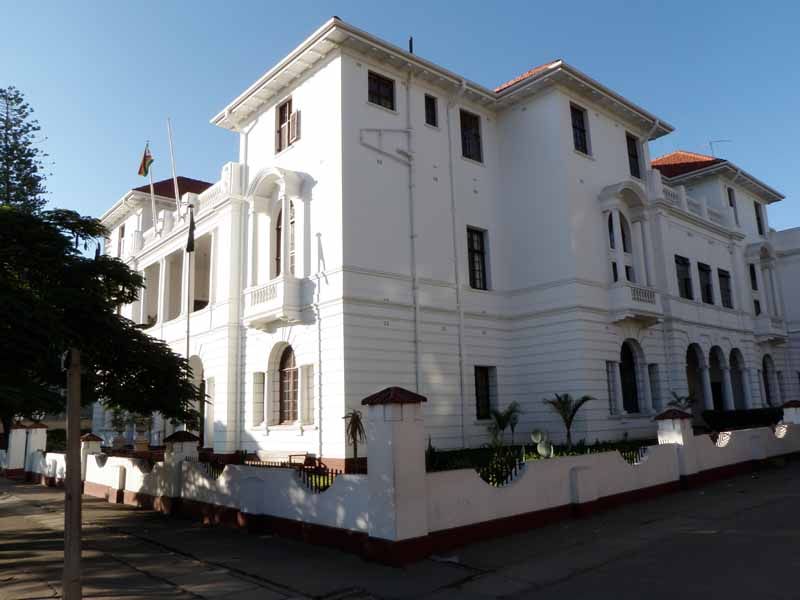 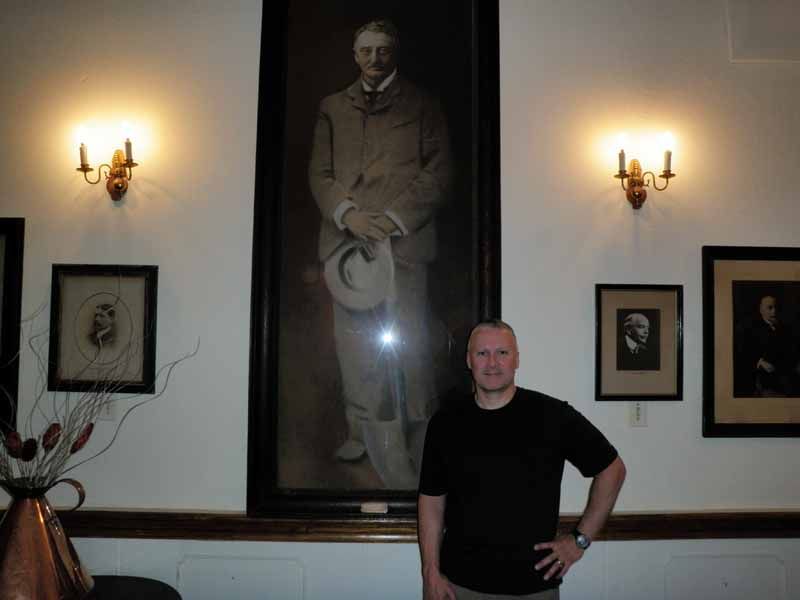 A lousy picture of a cool room 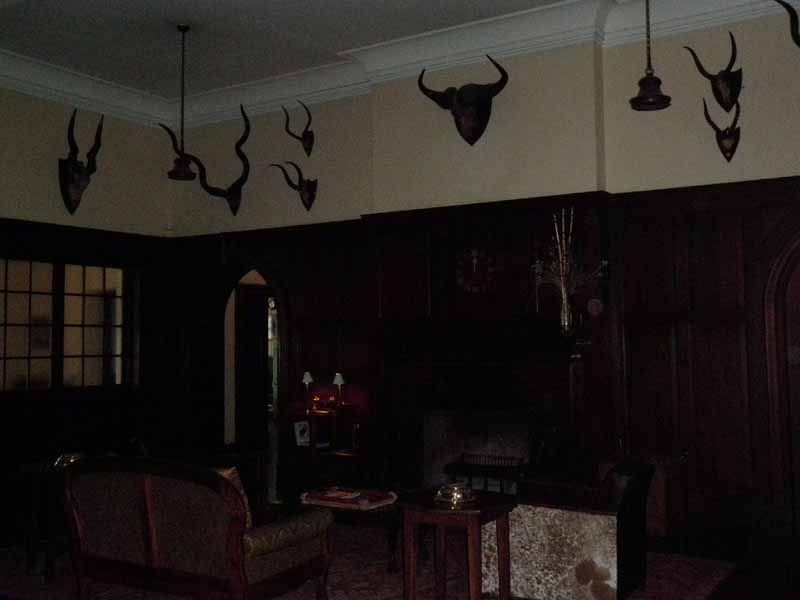 Rather than sit around the hotel, we accompanied Mart to his house to hang out while supplies were gathered, and to meet his two wonderful children who I have heard so much about. Brett and I learned the proper way to throw a rugby ball, and basically had a nice afternoon getting acclimated to everyday life in “sleepy Bulawayo”. We picked up some supplies including most importantly $100 worth of biltong at The Butcher Shop. I regret not taking a picture of this place, it is a meat-lover’s dream come true with racks of prime beef tong, meat sticks and fresh cuts of beef, lamb and pork. Anybody who greets you at the door with a piece of meat, like the owner of the shop Richard Drage did, is alright in my book! That evening Mart and his wife Candy took us out for dinner to a great little spot on the outskirts of town called the Bombela Bike Shack. The meal was fabulous, and I was amazed at the availability of ingredients and spices. Apparently the menu changes every week, and served outside, it is a great place to spend some time when in Bulawayo. The following morning (Saturday), we enjoyed a nice breakfast at the Club before being met by Mart at around 7:30am to begin the long drive to the Omay. I enjoy driving to/from the hunting area, and time permitting have done so on numerous occasions. While a charter flight is quick and usually painless, it does not allow me to get the feel of an area or the people. One goes from airport to airport to camp, and then back home again, without ever really getting to experience everyday life outside of the hunting concession. For some, this is probably best, and often a charter is the only option especially once the season is underway. But if time permits and logistics make sense, and/or your budget is tight, consider driving in with the PH (just don’t complain, too much anyway, and remember that you asked for it!). Hitting the road Saturday morning 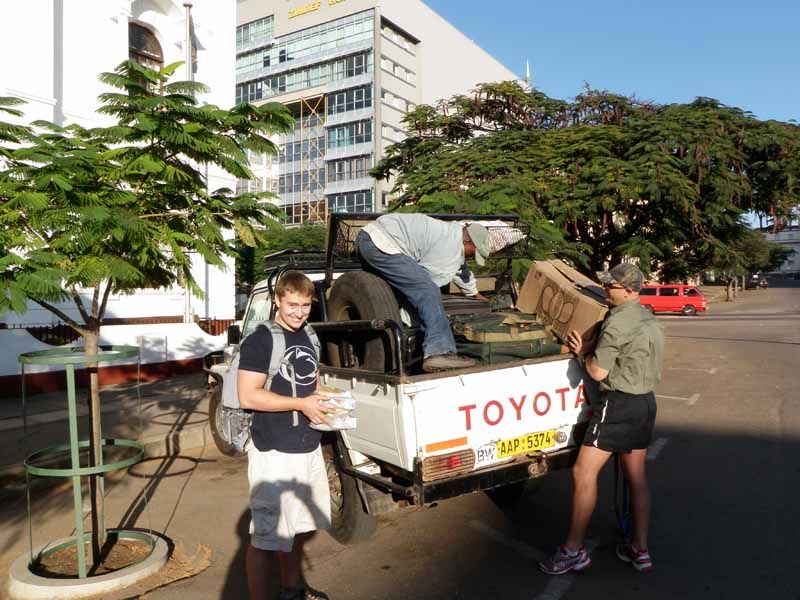 I drove with Mart, and Brett with cameraman Roy, saving Brett from the perils of the high-seat (those who have spent time on the back while cruising on the tarmac know exactly what I mean!), at least on the way into camp! We followed Roy’s Range Rover for a while, just in case it broke down, until I finally could not take the persistent cloud of blue smoke any longer. Too, Mart wanted to get a head-start before we hit the dirt track thru the Omay, where our leaf springs would bounce us along, while Roy and Brett giggled at our misfortune. The sparring between the majority Cruiser owners and the passionate Rover faithful is always fun, and this trip was no different. 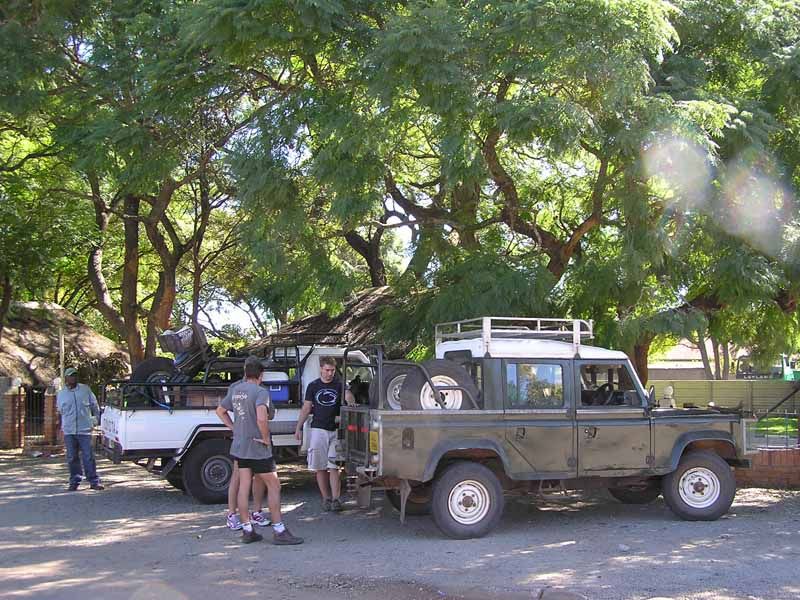 We worked our way thru Gweru, Kwe Kwe, Gokwe, Chitekete and eventually into the Omay South hunting area where the tarmac gave way to a dirt track. A typical open market as encountered along the way (Gweru) 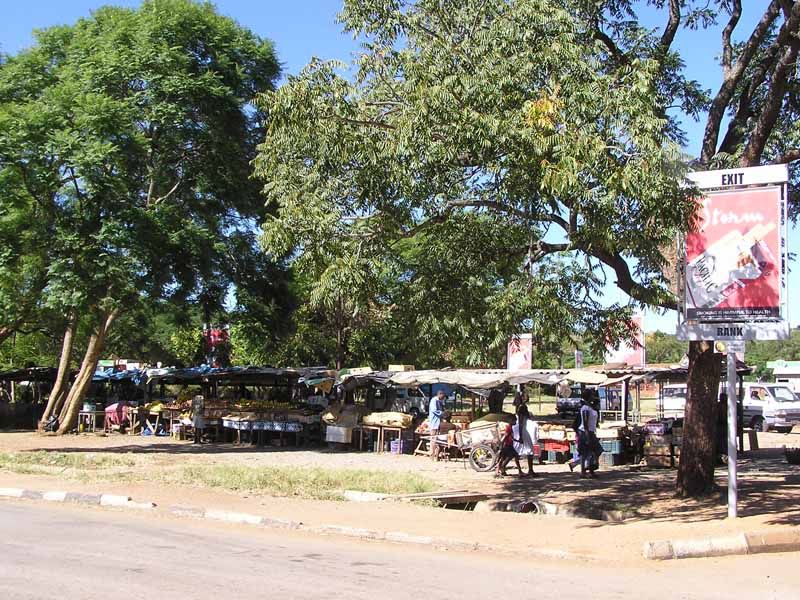 Pit stop for snacks and drinks 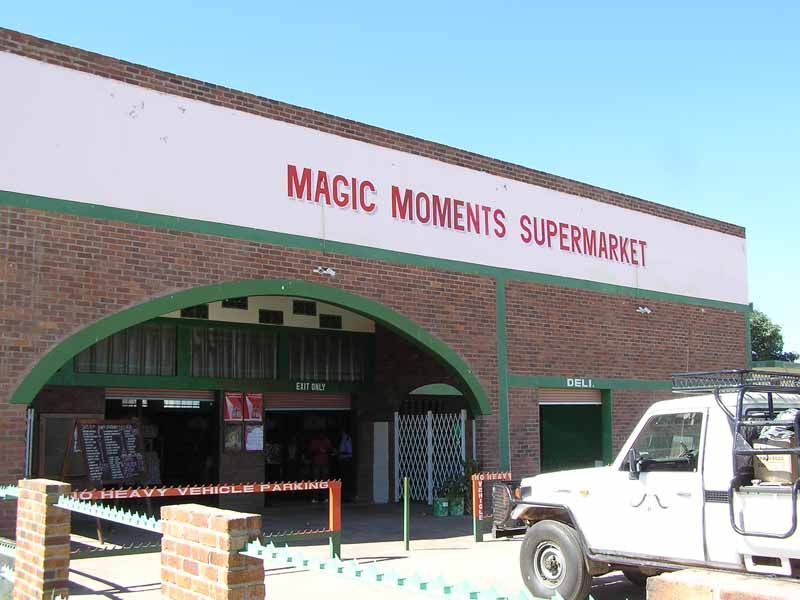 A few years ago this place would not have had a Coke…now they are serving Daily Specials! 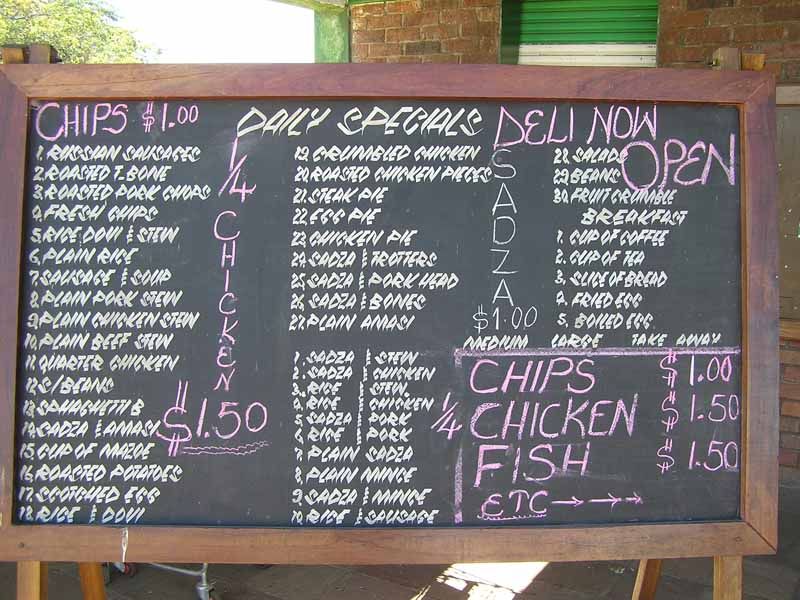 Entering the hunting area, note the “net” to catch any Tse’s looking to hitch a ride in/out  At around 4pm we arrived to pick up our Council Scout. He was not available. What we did find was a pro ZANU-PF rally. The Minister of Public Affairs was speaking to a large gathering of locals, and judging a dance competition where the winner of the men and women groups was awarded a $20 cash prize. There was no security present, and although that night there was sure to be a good party, everyone was calm and peaceful. Hopefully this is a sign of things to come in the new Zim, where good old “politicking” is done without intimidation and oppression. We arrived at camp at/around 6pm, tired and hungry. Dinner was roast impala, nicely prepared. HUNTING CAMP Like last year, we were based out of the Ume River Camp, located along the eastern boarder of the concession adjacent to the Matusadona National Park. This is Martin’s main camp, built by the previous operator in 1992, overlooking the Ume River and Lake Kariba inlet. While a bit dated, it is a pleasant camp with good shade, nice breezes, and great views. My chalet was high on the point and open, and is the one to request if possible. The other two guest chalets are closed-construction. Since last year, Mart has built a new bar area overlooking the water (the structure on the right in the picture below), and put in a small pool, both welcome improvements. Most time is still spent around the fire pit which while being cozy, does not offer any views of the magnificent African night sky. I expect that Martin will continue to make improvements to the camp as budget permits, making it an even more inviting place to stay. To me, it feels like home away from home! View of the Ume River Camp from the water 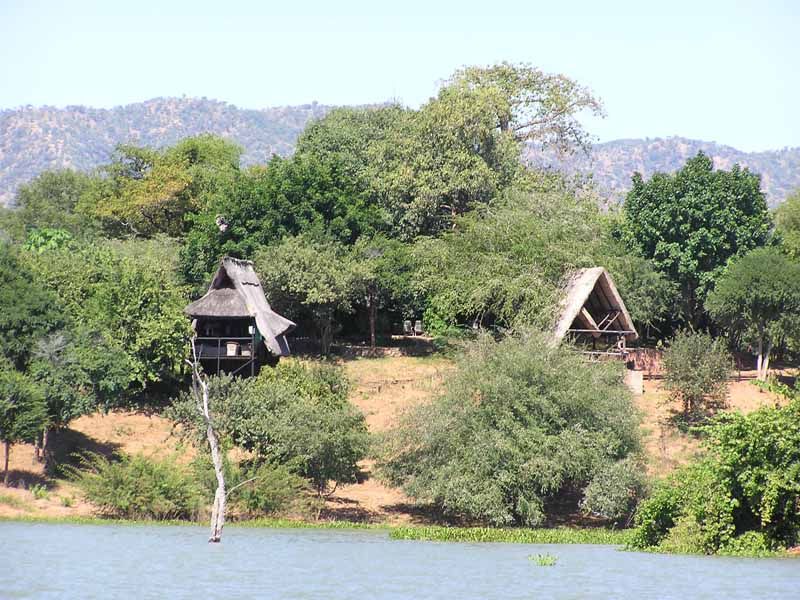 In last year’s report, I included a section about the food. The camp manager at the time, Chris, enjoyed his meals and was largely responsible for the menu. Chris is now working at a photo camp in the Falls. As Mart still has the same cooks as before (Super and Edwell), the food was every bit as good, but some evenings there was not quite enough to go around. Not that the cooks were intentionally skimping, but at times during our stay we had a very full camp, with as many as 12-14 people including at various times hunters (myself + a father/son from California and another father/son from Texas), PH’s, appy’s, and cameramen. I did not request “camp exclusivity” for this hunt, as initially we were going to be backpacking and spike camping for at least half the days. When these plans changed, I did not think to raise this question, and with the season underway and guys trying to get hunts in before the World Cup, I could not have expected Martin to shut down camp for just Brett and me. I don’t drink, am not a big talker, and honestly am probably not too much fun around the campfire. I prefer a small, intimate camp environment and sincere one-on-one conversation, and not about US politics or current events or other topics that take me out of my safari mode. I am in Africa to get away from the 24 hour news channels. I am also sensitive to the fact that while I have been on numerous safaris, the other hunters in camp may be on their first trip, and I don’t want to be “that guy” who drones on and on about all the great things that they have done. The other hunters need to hear the PH’s stories, and it is they who must create that “safari magic” that gets in our blood and keeps calling us back. I worry that with increasing pressures placed on PH’s to work miracles in 5 or 7 days, combined with decreasing spending power and the changing demographics of the professional hunters, this talent is being lost or forgotten. Then again, maybe the majority of sport hunters today just want to “kill something and go home”, I don’t know. It all worked out fine as the PH's in camp were all great guys, and I enjoyed talking with them and the other hunters, both of whom were nice guys and also on father/son hunts. Most nights Brett and I were in our chalet by 9-9:30pm, reading/writing, working out (yes there were weights in camp!), and reliving the day’s events. The few afternoons when we were back in camp, it was empty. Mart’s other camp at Mackenzies Point was busy too, hosting a group of three hunters and their support teams, including PH Shaun Buffee. Shaun and I go back a few years, as he was the cameraman on my first elephant hunt in 2005 in Chewore North. This had been his first dangerous game hunt, and before he departed for his 2x1 bow hunt, we enjoyed catching up. Shaun is good company and by all accounts has become a fine hunter, and I would not hesitate recommending or hunting with him. One of the more quiet dinners 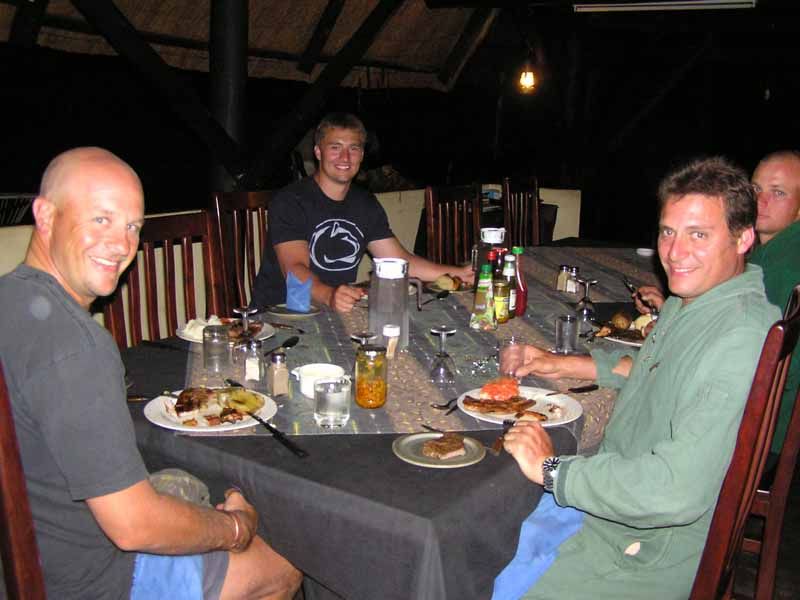 Braii (BBQ)  THE HUNTING CONCESSION Omay North is a one million acre hunting concession located in the middle Zambezi Valley. It is bordered by Lake Kariba on the North, the Ume River and Matusadona National Park to the east, and the Sengwa River on the west. As of 2010, Martin also has the marketing and hunting rights to Omay South, which at another one million acres, offers a huge area of contiguous land in which to hunt.  As a communal hunting concession, the local Council is largely responsible for overseeing the hunting including quotas, and slightly different rules and regulations apply as compared to the safari areas run by National Parks. I will not attempt to differentiate between the three types of hunting areas in Zimbabwe, including private land, but suffice to say that it can be confusing to a visiting sport hunter. Trust in your PH and follow his instructions in regards to the regulations and laws for the particular area that you are hunting. Per my 2009 Hunt Report: “Omay is a Communal Hunting Concession, and part of the CAMPFIRE (Communal Areas Management Program for Indigenous Resources) program. In 1989, the CAMPFIRE program was founded to improve relationships between rural Zimbabweans and their environment to the hopes of creating long-term sustainability of the entire ecosystem. It provides structure and incentives to Zimbabweans to preserve wild animals and utilize them as valuable natural resources, rather than poach and destroy their habitat. Leased by safari operators, CAMPFIRE profits are primarily generated by hunting. Trophy hunting should be considered the ultimate form of ecotourism, as hunters usually travel in small groups, demand few amenities, cause minimal damage to the local ecosystem, yet provide considerable income. The money collected is used for the general community such as building and equipping clinics and schools, constructing fences, drilling boreholes, building and maintaining roads and controlling poaching. In addition, the safari companies operating in the CAMPFIRE areas employ many local villagers as trackers, camp staff, anti-poaching scouts and road crews. Martin has some (75) local people on payroll in one form or another. Not only are they paid for their services, but rations including meat, mealie meal, medical supplies and clothing are provided. Perhaps most importantly, in properly run CAMPFIRE areas, the symbiotic relationship between the people and the safari company is to the benefit of the land and the wildlife. For as they become educated in the value of hunting and tourism, the hope is that they come to understand the concept of stewardship, and that wildlife is of more benefit to them alive then dead. Nobody can stop meat poaching in Africa, but as a community when they police themselves, the impact to an area can be minimized. Omay’s administrative center is the District Council located in the village of Siakobvu. Settlements are centered around four major chiefdoms: Mola, Negande, Nebiri and Msampakaruma. The various villages are organized into Wards, each with a governing body. For being in the middle of nowhere, with little modern conveniences, it all struck me as being amazingly organized. Half of the trophy fee cost goes to the District Council, which is run very much like a corporation. The other half goes to the Ward in which the animal was shot, providing incentive to control poaching and village settlement. Excluding that needed by the safari operators, all meat (“nyama”) is distributed to the villages, and in the case of elephant typically the village closest to the kill.” Cruiser purchased by Martin for Council to use (this was NEW 3-years ago!) 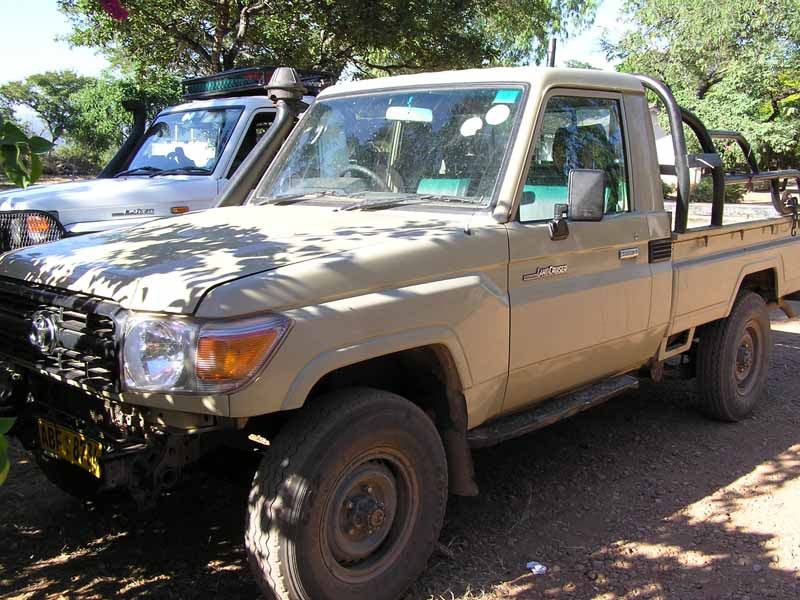 TERRAIN It is virtually impossible to categorize Omay North, as it is as diverse and interesting an area as I have ever hunted. Along the shore of Kariba there are very think patches of jesse (pronounced “jess”) bush, which is thick thorn bush, difficult and often dangerous to hunt especially in the early season, given the limited visibility and unpredictable winds. Following an elephant path thru the jesse bush  Virgin and impenetrable jesse bush 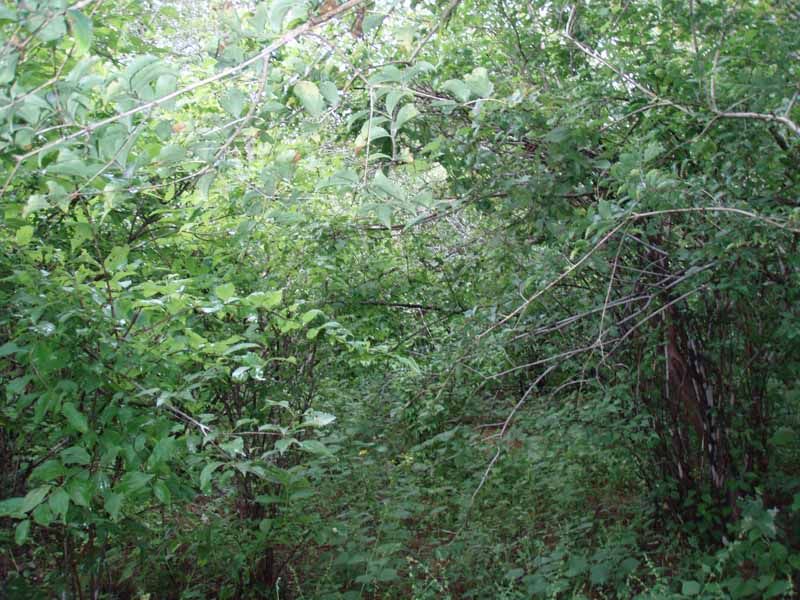 Much of the area is open, covered with Mopane scrub where one is more apt to get a shot on a buffalo or other animal, although in the early season and/or during wet years (such as this year, 2010) this can still be quite thick. Mopane scrub & grassland 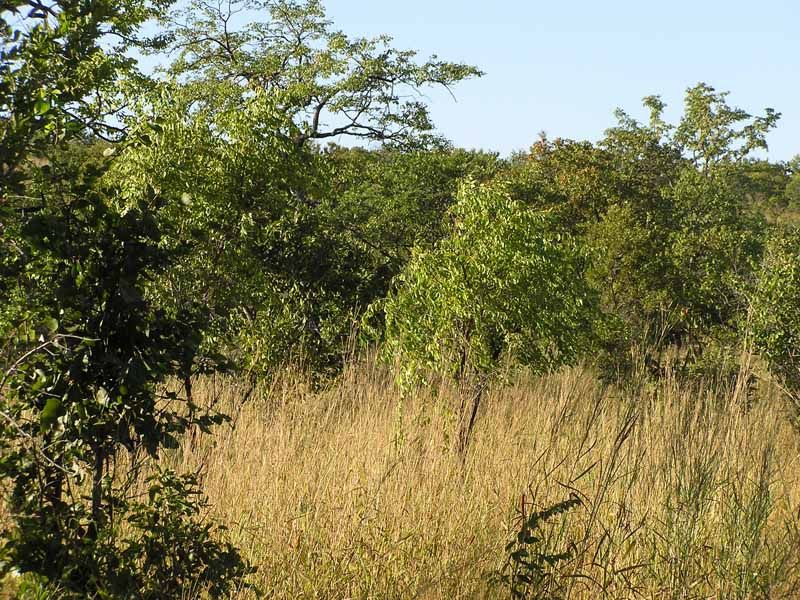 Several mountain ranges run thru the area and along the border with the Matusadona Park, providing hills from which one can glass the picturesque valleys and open scrub areas below. The terrain on the hills is often rocky and covered in tall grass, making walking difficult unless on paths, as each step holds the potential for a twisted ankle. View from atop a hill overlooking Lake Kariba  During the course of a hunt, one is also likely to walk along sandy river beds, and walk or cruise the shoreline and floodplains. HUNTING CONDITIONS I have hunted Africa in every month of the year except January and June. This being said, no two hunts have been exactly the same as conditions in different parts of the continent can vary, and things can change dramatically in the same area from one year to the next depending on the seasonal rains. Too, one part of a country can be flooded, whereas another part is experiencing drought conditions. In a typical year, in most of Zimbabwe, May and June are transitional months when the grass begins to turn brown and the bush starts to open up. However, in a wet year such as 2010, hunting conditions can be difficult and spotting game a challenge. Parts of our area even had rain while were hunting, almost unheard of for the end of May. Lake Kariba was so full that we used a boat to cover land that is usually driven by Cruiser (not “hunting” via boat as this is not permitted, but to get from one area to another), and the floodplain where game can be seen feeding was non-existent. There was water everywhere throughout the concession, pans were full and streams were still flowing. In other years when there is drought and the seasonal rains poor, it can be a completely different story. I enjoy Africa when things are green, to me it is much prettier than the barren, burned landscape found later in the year. However, I believe that most hunters, especially those hunting buffalo and plainsgame, will be safer booking later in the season, July and August onwards (although this year July may even prove a bit challenging). Whereas game is spread-out in the early season, come September-November in particular, the majority of game will be concentrated around the remaining water sources, in Omay this is namely Kariba and the Ume River. This makes hunting easier, although the temperatures will be hotter. MY HUNTING TEAM Steven (Lead Tracker) & Tapera (Council Game Scout)  Dalton – Senior Apprentice Hunter 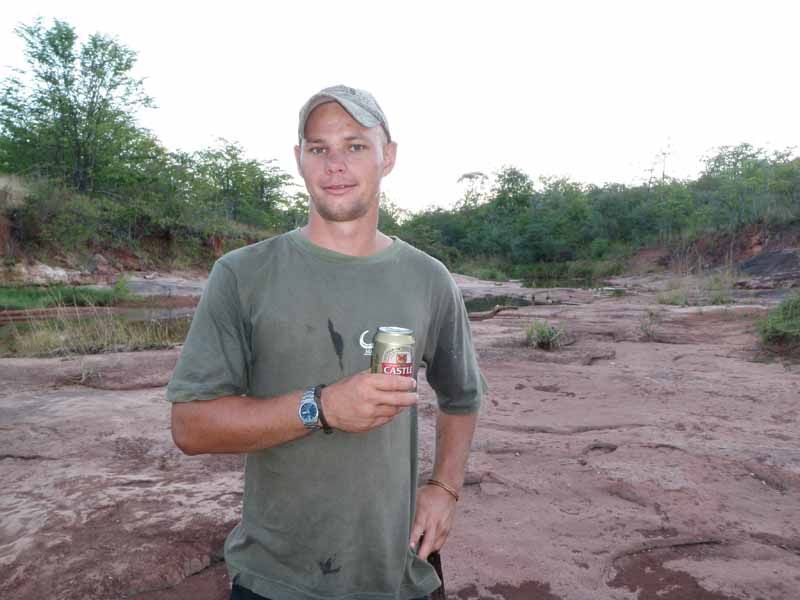 Roy Awlward – Cameraman & All-Around Great Guy 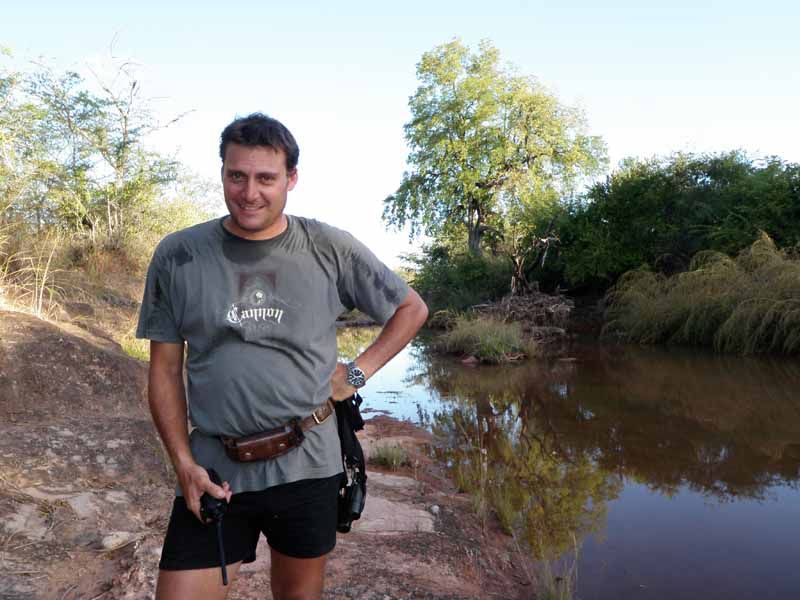 DAY-1 HUNTING – WARM-UP And so began the morning rituals of another safari; up at 4:45, breakfast 5:15, final prep 5:45, out by 6am (at/around sunup). Still needing our Game Scout in order to begin hunting, Mart worked out a perfect plan to make the most of the time. I wanted to visit the Kariba Crocodile Farm with Brett, as it is something to see and calling to the baby crocs pretending to be their Momma and having them respond in unison is just plain cool. More relevant to the hunt, this gave us the perfect opportunity to “study” the big crocs so that I was 100% sure of my target. Wanting to preserve the croc skull, my goal was to take a spine shot. The target is around 1-inch behind the smile, but the end of the smile is not as evident on some crocs as others, and like finding the brain on an elephant, the shot can be a bit tricky at the various angles and elevations likely to be encountered. More than any other single shot, I have been fearing this one, a result of too many videos and stories of crocs propelling themselves back into the water after a failed brain or spine attempt. Close-up pictures of some of the breeder croc’s 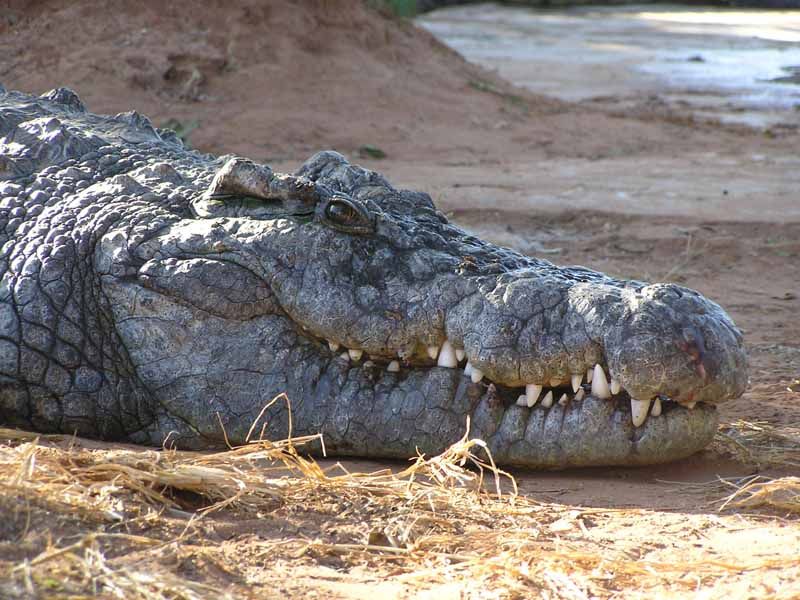 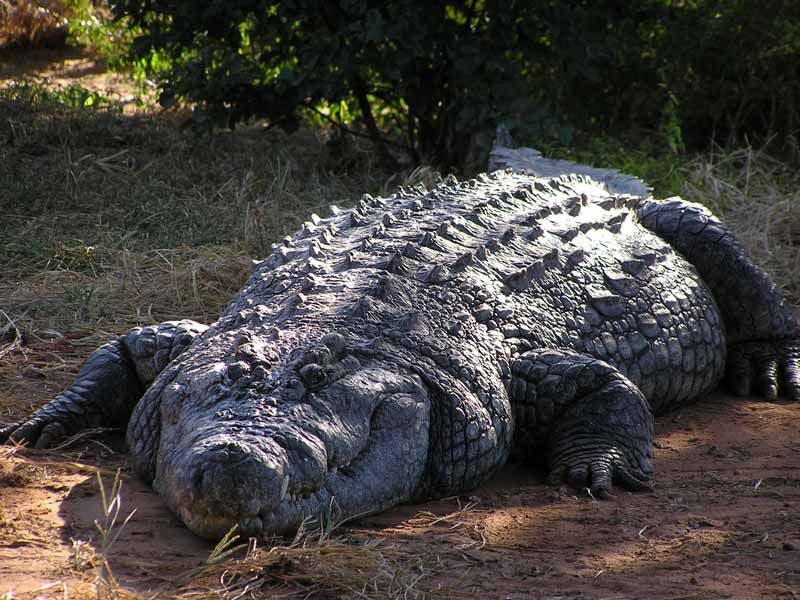 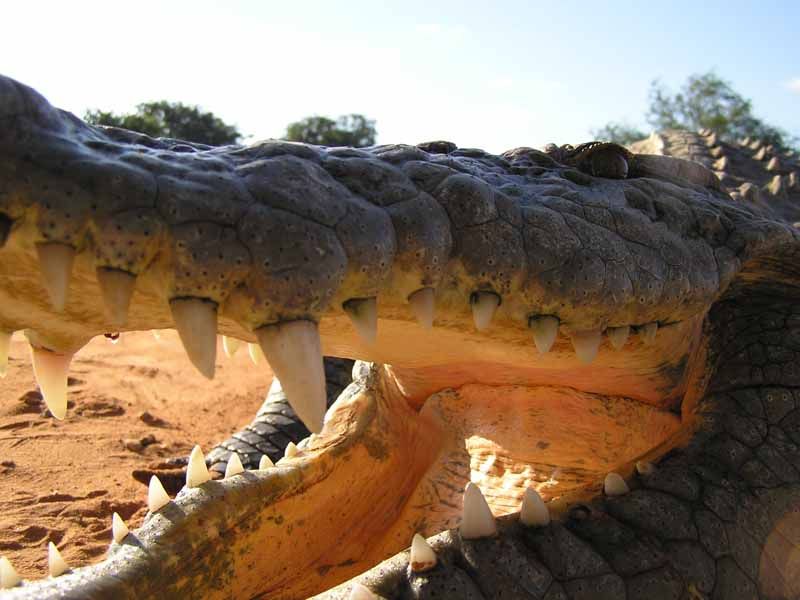 “What, NOOOO, of course we did not go in the enclosure with them Honey, that would be silly” 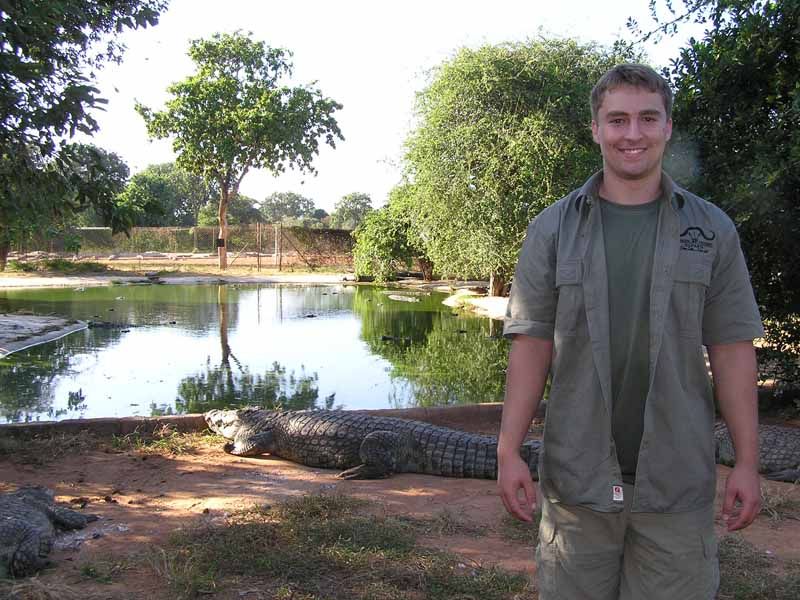 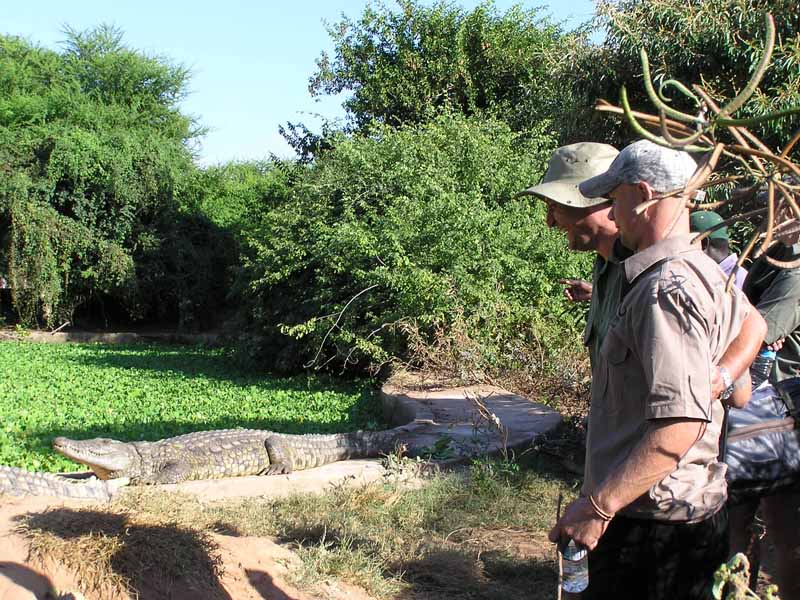 Around 9am, they began the processing of the unlucky crocs selected for that day. The following pictures (excluding some of the more gruesome ones) outline the sequence of events. It starts with the selection of a younger croc, providing a high-quality skin and in particular the underbelly which produces soft and subtle leather. The croc is inspected, measured, and the quality of the skin determined. Electrical shock is used to stun the croc, before it is quickly dispatched by severing the head and spine. The carcass is hung and skinned, with the tail meat removed for resale and human consumption. The skin is cleaned first using water via a high pressure sprayer, and then scraped by hand. The remaining carcass is ground and made into croc food which is then fed to the ~35,000 crocs on the farm. 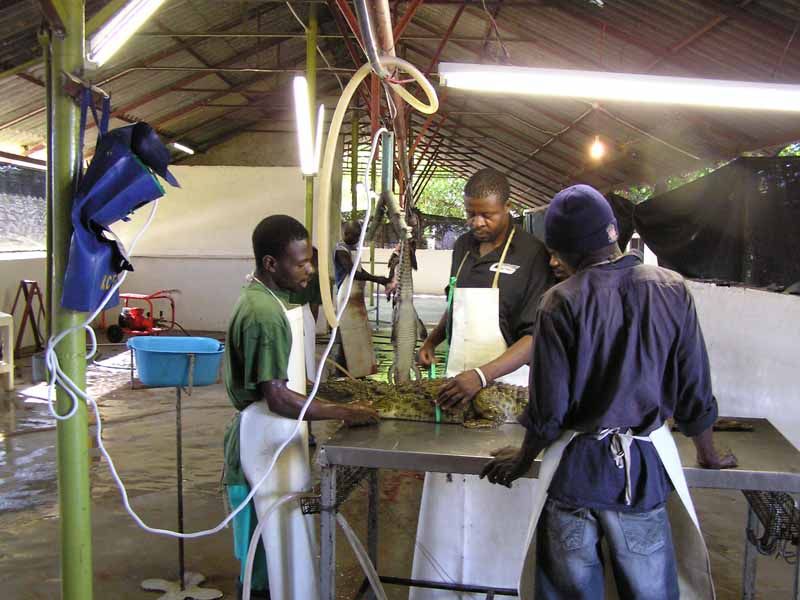 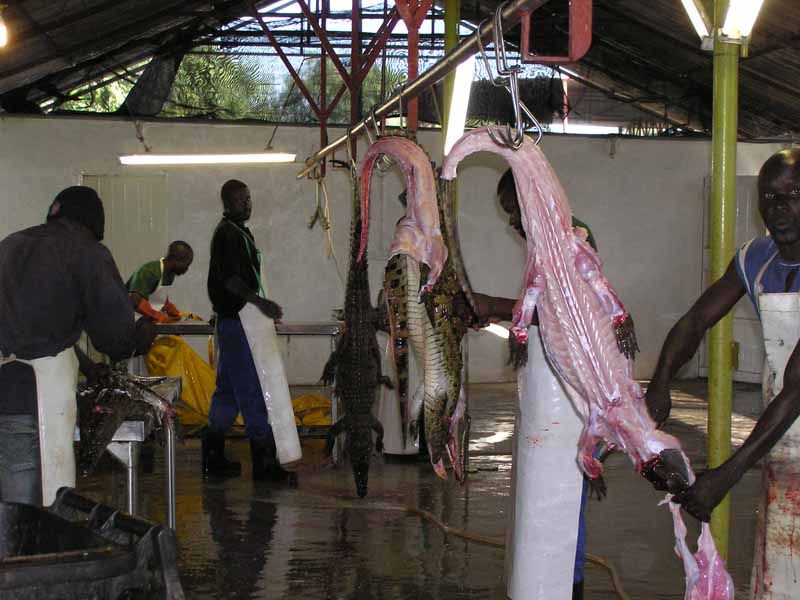 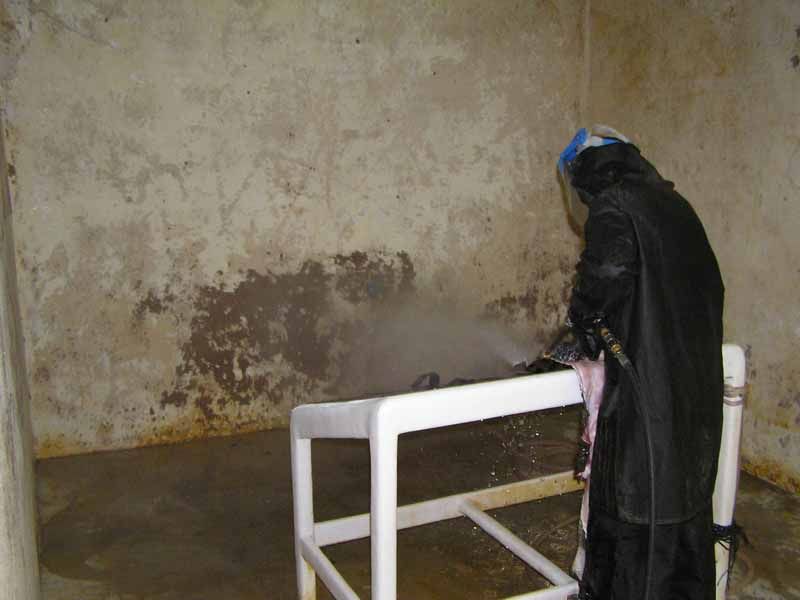 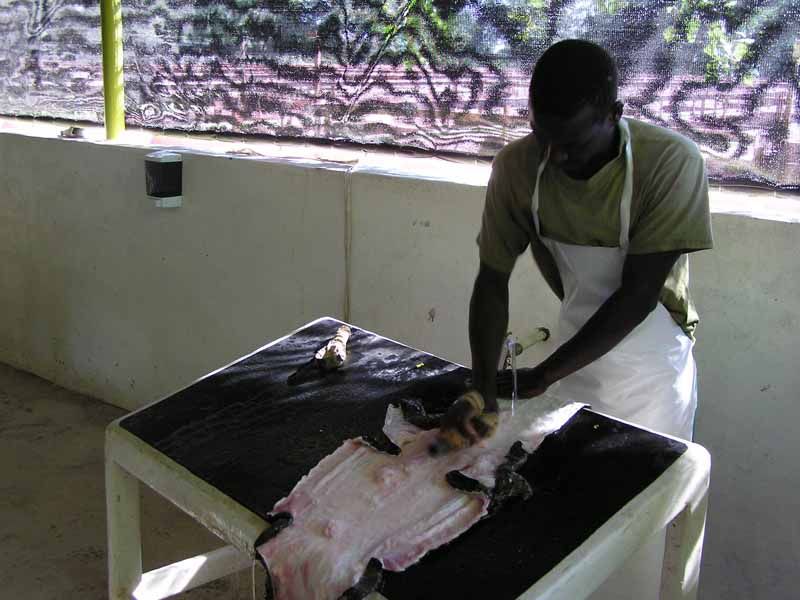 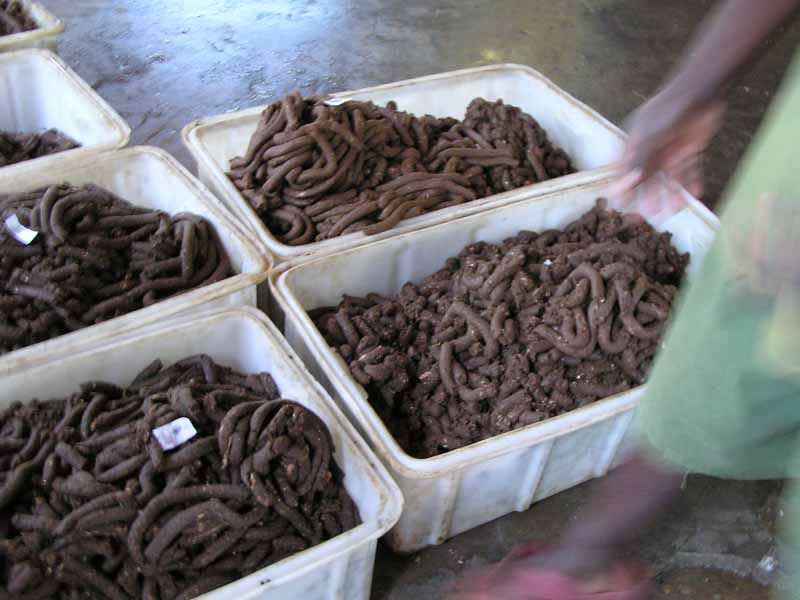 By the end of the morning, I felt that I knew my target pretty well, inside and out! By the way, as part of a mini-series, NatGeo has an excellent documentary outlining the dissection and amazing anatomy of a Nile Crocodile, called “Inside the Croc”. This is a must-see for anybody planning to hunt these amazing creatures. My family and I love NatGeo's nature documentaries, and am very pleased that in addition to their watered-down "National Geographic Channel", they now have one focused on animals called "NatGeo Wild". With our Scout, we drove the short distance to the Tiger Bay Jesse. Those who read my report from last year will know that this block of jesse played a lead role in my hunt, so I will not spend a great amount of time documenting it here. But suffice to say that the Tiger Bay area is the thickest, most exciting and ultimately the most frustrating area that I have ever hunted. The elephants love it, and retreat to it as well as other dense areas during the day and/or when they feel pressured. They have the upper hand here, as the thickness of the bush, especially during the early season, and the flakey winds work to their advantage. Finding tracks leading into the Tiger Bay Jesse is easy…getting onto the elephants is a whole other story! Tiger Bay Jesse during the early season 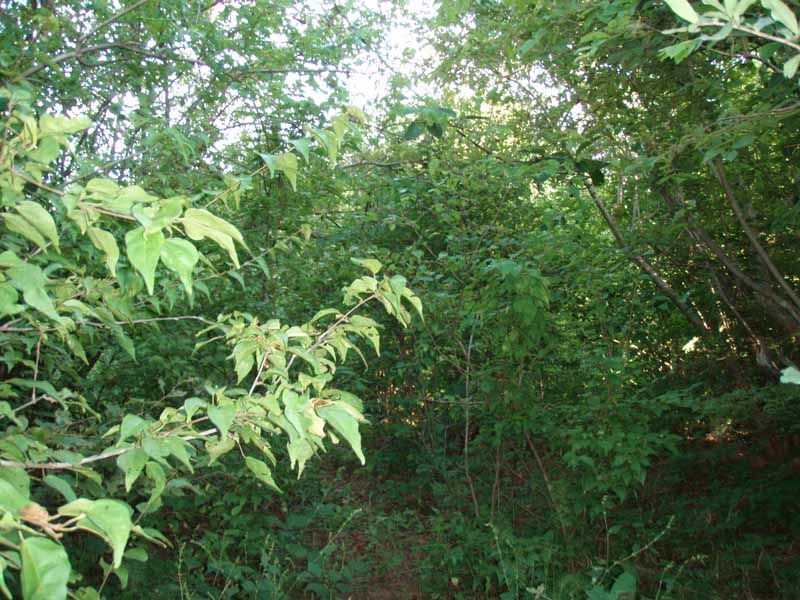 We cut tracks and followed a herd of cows into the jesse. Being slightly less switched on than the females, we got on two bulls who were trailing the herd. Despite being within 30-yards, they never knew we were there, and we left them undisturbed. We got close on several occasions to the cows, never actually seeing them but hearing the breaking of branches and their digestive systems at work. The winds betrayed us, or favored the elephants, depending on how you look at it. We walked to the Lake shore, expecting to see a nice floodplain, but instead were greeted with waves of water lapping up against the edge of the jesse. The historic high-water would be a problem during the course of our hunt, eliminating certain methods of hunting both crocodile and elephant. It is these uncontrollable variables that can make a hunt interesting, especially when one is mostly in it for the experience. But a guy on his first 7-day buffalo and plainsgame hunt may feel quite differently. Dalt left to retrieve the truck, as we spot-stalked thru the bush still hunting elephant. We found some sign, but nothing too fresh, and as the heat of the day increased it would have been pointless following as the swirling winds would have made any approach impossible (as compared to almost-impossible under good conditions!). What we did stumble upon was a very dark and large sleeping hippo bull, about 1km from the Lake. Luckily we saw him before he saw us, and we gave him a wide berth. He knew we were there, and had we pressed the issue, I am certain it would have gotten exciting. However, Martin had sold all his hippo quota for the year, and although we needed meat to bait the crocs with, we left him in peace. We met the truck and enjoyed a nice bush lunch followed by a short power nap (it is amazing how 10-minutes of shuteye can recharge the batteries). Fish Eagles in Lake Kariba, note the very high water 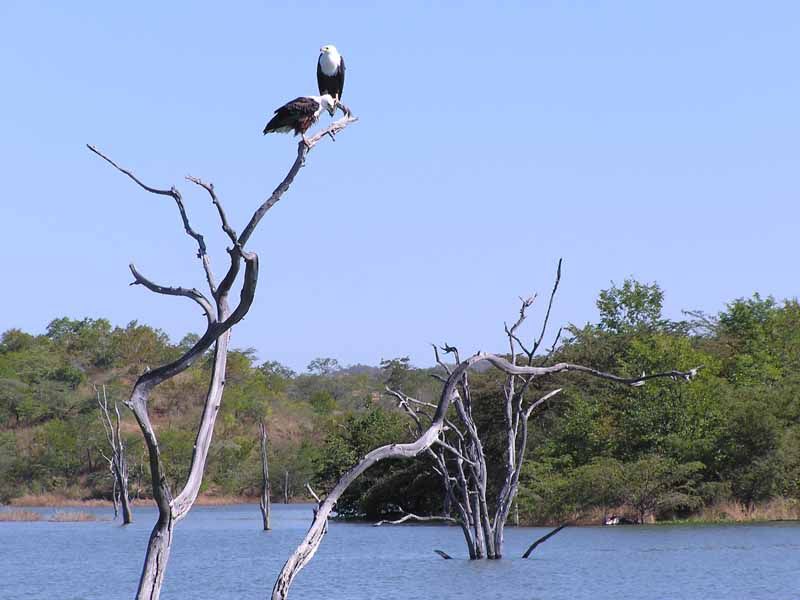 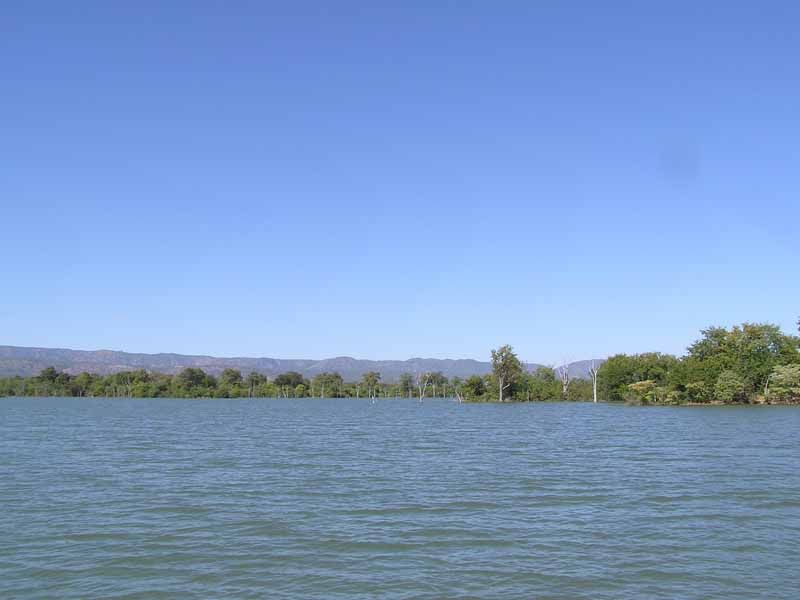 Bush lunch 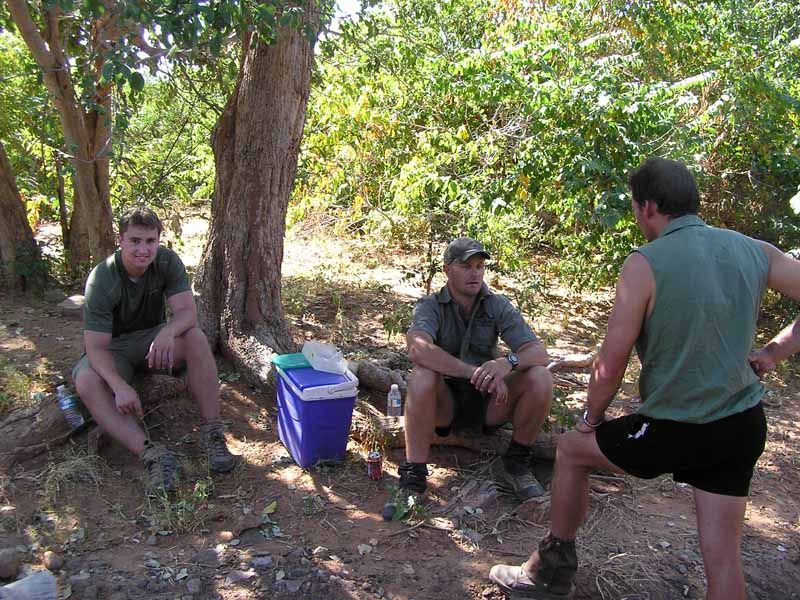 Wanting to ease into the hunt, we started our drive to camp so that we could get out on the boat before it got dark, and see if we could locate sand banks where we could setup bait for the crocs…and maybe get lucky and find a big one on the bank that could be targeted a following day. As often happens, after hours of tracking to no avail, we crossed paths with an elephant cow along the dirt track. This herd contained a tuskless, and the truck became excited. I, however, was not too thrilled about the prospects of shooting a tuskless (a rather one young at that) spotted from the vehicle, especially on day-1. Challenging this though was the fact that while it was my desire to hunt the elephant in a sporting manner, the whole justification behind shooting a tuskless elephant is to remove it from the gene pool…and we needed meat to bait crocs with. Rationalizing that doing an approach would be good for me - after all it had been 14-months since I last walked up on an elephant and I found that I get heavy-legs the first few approaches of a hunt – we decided to follow the herd which had now moved off and see what happens. As we got close, the demeanor of the tusked cow changed drastically. She trailed the group, and repeatedly showed aggressiveness. Mart and I discussed our options, and with the realization that even if we got a shot on the tuskless we would very likely end up shooting the tusked cow too, we called off the stalk. I had yet to shoot an animal in “self defense”, and felt strongly that the responsible thing to do was to not setup a situation where a charge would be likely. Looking back, it is funny how this would play itself out in the days that followed. A cheeky cow elephant, prior to being agitated 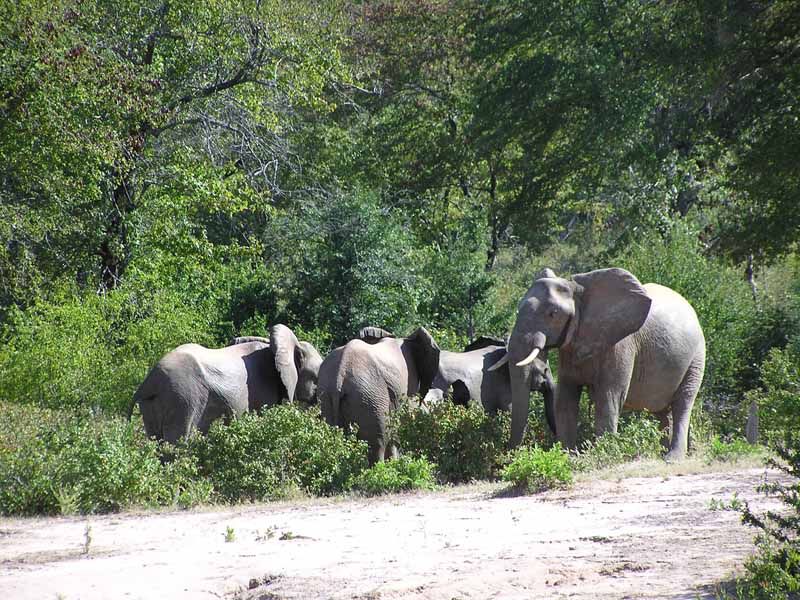 Evening boat ride 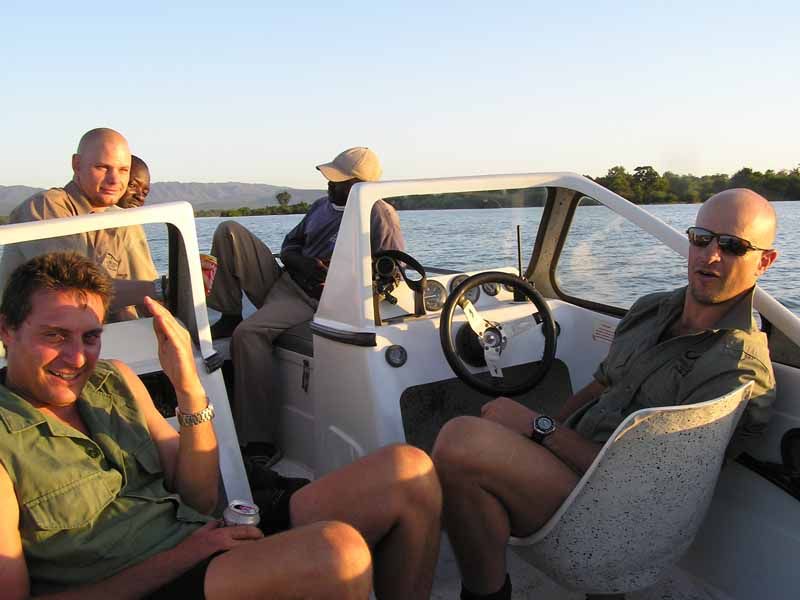  | ||
|
| one of us |
DAY-2 HUNTING – HIKING/TRACKING While the second day of the hunt had perhaps less exciting highlights, we did considerably more actual hunting, putting on quite a few miles over the course of the day. This was the “Lets stretch our legs” portion of the hunt! For some PH’s, this is also the time to reset the clients trophy expectations. We picked up tracks early and began walking at 7am, following a herd of cow elephant. Initially spoor seemed fresh, with warm dung, damp snapped branches and bits of still pliable chewed mopane leaves indicating that the herd was feeding. But as the morning wore on, we seemed to lose ground, as the elephant marched in single file along a path to some pre-determined destination. Later in the hunt I would come to realize that being early season, this was their pattern. Feed at night, and hit the safety and coolness of thick green bush early morning thru the afternoon, before coming out early evening to again feed. This was somewhat opposite of what our plans were, which was to hunt elephant in the cool mornings, and spot/stalk and bait crocs in the afternoon until dark. At around 10am, we ended the walk at an area known as Red Cliffs, for obvious reasons. Dalt radioed camp, and PH’s Shaun and Pierre scurried to meet us via boat. This was really cool and a first for me. Although tired, I could see the longing in the eyes of Shaun and Pierre, who were chomping at the bit for their hunts to begin. This energized me, and after a short ferry we were off again walking an area known to hold a lot of elephant. 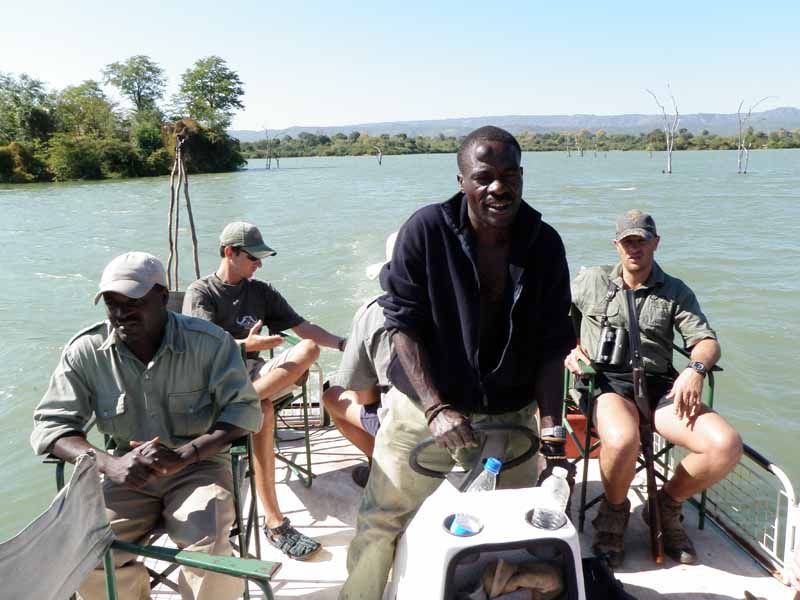 We walked until around 1pm, to a favored area for late-day rides as it holds a lot of game that can be seen from the truck. We jumped some waterbuck cows, which were far too fast for pictures. As typical of an early season hunt, on a whole we did not see a lot of plainsgame. Spoor was everywhere, but the animals are clever and with the bush thick and green, they either see or smell you long before you bump into them. Mart had sent Dalt back for the Cruiser before the boat ride, which now met us at the “hollowed out baobab tree” with our coolbox of packed goodies and cool drinks. While being subtle, this level of coordination demonstrates the level of planning and micro-engineering that takes place over the course of a hunt by an experienced PH. After lunch and a short siesta, we walked another 3.5-4hrs without seeing much. 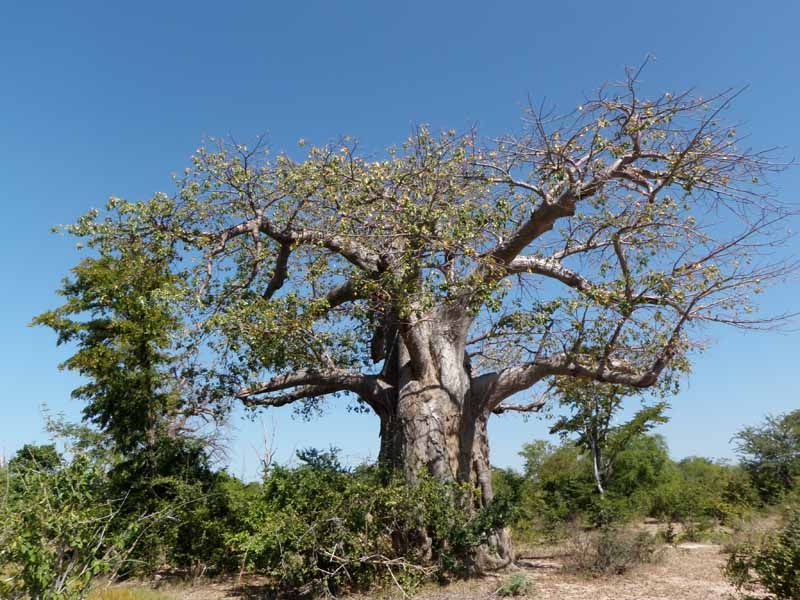 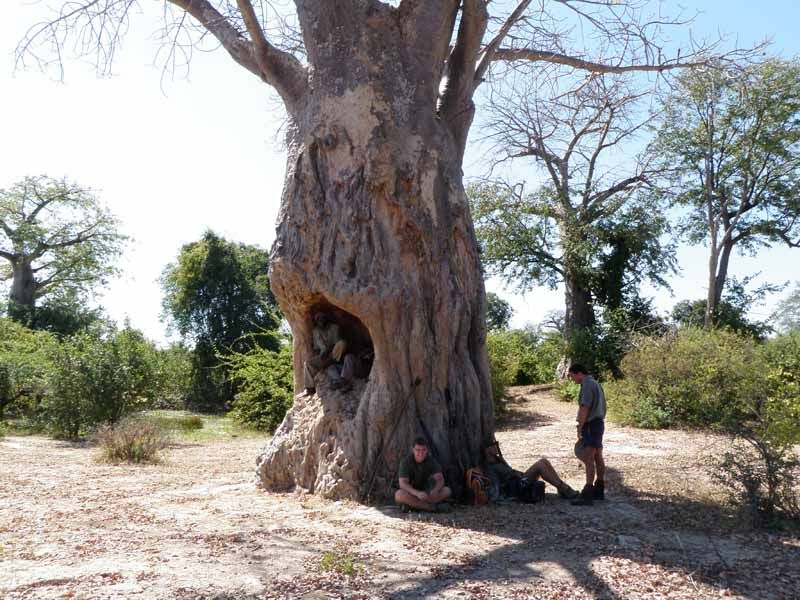 DAY-3 HUNTING – MORE HIKING/TRACKING I slept maybe 5hrs, and woke at 4am a bit groggy. Camp had been very hectic last night, bustling with excitement and activity. We were out by 6:15am, driving towards the Mackenzies camp to walk a pretty valley known to have good numbers of elephant plus other game such as sable. Please note that due to the time of the year and my personal preference, this was not a “drive and stalk” hunt. For us to be successful, we would need to be either on foot tracking elephant, or glassing and walking areas looking for sign. As there was water everywhere, pans and springs that could be hiked to most of the year were not as reliable, and on occasion our walks although enjoyable were unproductive. This applies to buffalo also in the early season, and while it is possible to spot herds via the truck or boat, the most productive way is to tighten up the boot laces and head into the bush. Compared to last year when it was still raining, the sticky black cotton soil and slick fine red mud was dry, and looking at the same sections of trail it was hard to convey to Brett the degree to which we struggled to get around, by vehicle and at times on foot. At least until Dalt pointed out our tire marks and rocks/logs now buried in the tracks from last year! Typical village encountered during our drives around the concession 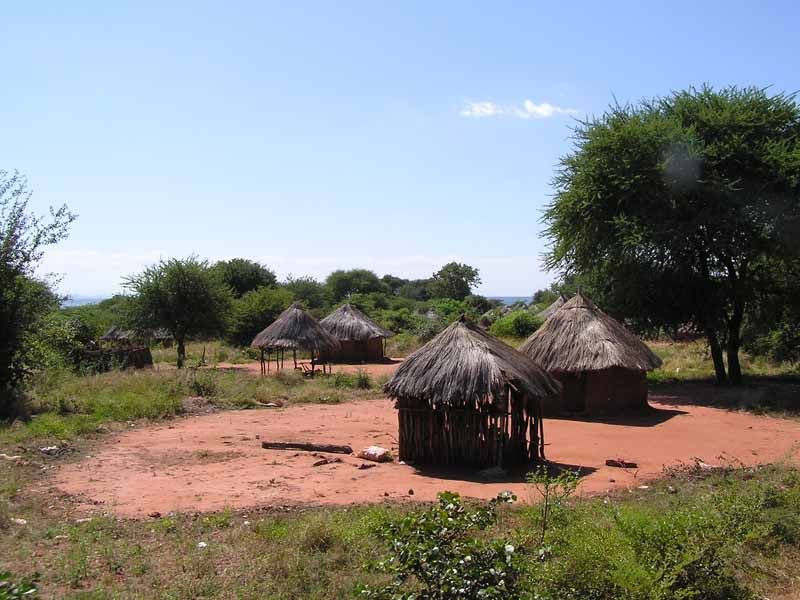 This day proved to be very enjoyable, despite not shooting anything. The valley we walked was pretty, with lots of spoor including buffalo and a few sable bulls which would have been great to happen across as Mart had one license available and I have yet to shoot a sable, which I am saving for a free-range area such as this. We crossed elephant spoor and tracked them to a wooded area where they were feeding. There were no tuskless in the herd, so we left them unaware of our presence. To me this is the ultimate in elephant stalking, to be close enough to shoot, yet to be able to leave them in peace. On a walk-about in search of whatever we might find! 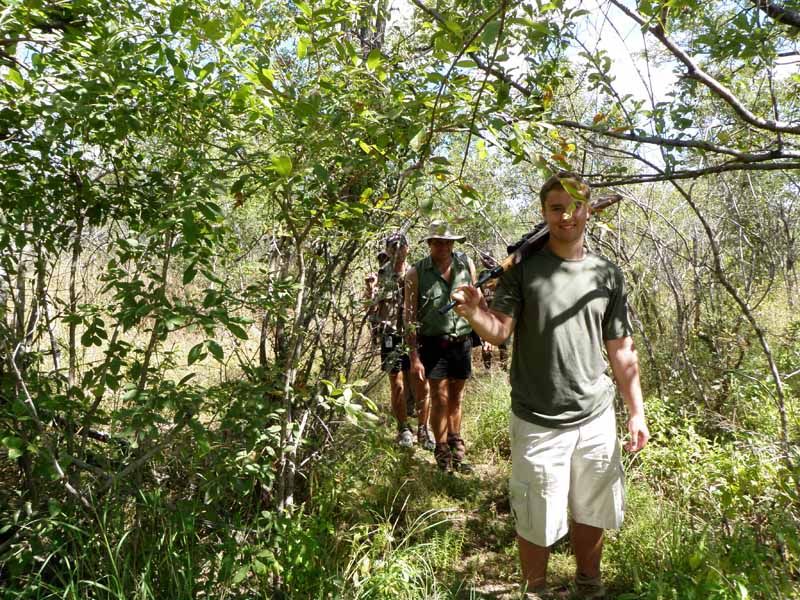  We continued walking towards the rendezvous location with the truck at the other end of the valley, crossing more elephant tracks on the way. We followed this herd into a large patch of jesse, where they got our wind and began playing a potentially deadly game of cat and mouse (not sure who was the cat and who was the mouse!). The herd kept circling, which I suspect was because they were getting whiffs of our scent but as the winds were also circling, they were unable to pinpoint our location. We eventually got downwind, and in one of the more open areas (picture below) we were able look over enough of the herd to determine that there was most likely no tuskless. Rather than burning more time trying to get a look at the few unseen cows, and maybe getting into a dangerous situation as a result of pushing them too hard, we backed out and continued our walk.  At a full pan of water, Steven noticed fresh tracks and wet mud hanging clinging to the leaves, an obvious indication that a group of elephant had just departed. We picked up the trail and in relatively short order caught up to the tail end of the group. Following the satellite bull, we gained ground as they walked at a leisurely pace, snatching bits of mopane leaf as they went. The group of eight elephant turned and one by one we confirmed that there were no tuskless, allowing us once again to back off unnoticed. Water pan where we picked up fresh elephant spoor  At this point I should probably describe my approach to carrying my rifle and assorted gadgets when on foot. I enjoy carrying my own rifle, and for about 80% of this hunt I was able to do so. The only times that I handed the rifle over to Steven were on a couple of marches back to the truck, where we were very unlikely to encounter any elephant. This being said, I think one must approach the hunt intelligently, and realize that we all have only so many steps in us. For me, abusing my hip for no reason meant that I might need to go slower the next day, when perhaps it would matter. As time marches on, I realize that having somebody carry my rifle will be the prudent thing to do, but for now, I was happy to carry it. And there is something that just feels right in the world with the Lott over the shoulder. Sort of like good biltong, a mopane campfire or the sound of hippos a night, not imperative, but I would miss it. I also wear a “culling belt” with approximately 10 rounds of solids. Other than this and a bottle of rewetting drops for my contacts, I am empty except the times when the compact camera is in the pocket for shots while on the hoof (which is how many in this report were taken, and why they are not always lined up properly). Carried by one of the trackers or sometimes the Scout, in a backpack which I would supply if need be, I always make sure we have the following: (1) Plenty of water, and this I verify throughout the hunt specifically when everybody is gearing up at the truck, as the time that you leave dry is the afternoon you’ll be walking for 5 hours in the heat...I speak from experience here. Make sure there is more than you need, as all PH underestimate the quantity of water a visiting sports hunter needs, especially during the first few days of the hunt and for those of us who are not from warm climates. Before you leave the truck, chug a bottle of water, regardless of time of day or expected length of walk. At night and at breakfast, drink water, within reason of course. My rule of thumb is if I am not peeing, and/or it is bright yellow, I am not drinking enough. Brett and I had no problems this trip. (2) NUUN hydration tablets in a very convenient plastic tube. They are simply wonderful, much easier than powder and a refreshing treat when walking. Simply drop one in a water bottle, wait a few minutes, and enjoy. (3) A compact Olympus shock/weatherproof camera in a case with spare memory card and fresh battery (always take at least one new battery). (4) Toilet paper in a wrapper or Ziploc. (5) Small bottle of sun block. In the mornings while getting dressed, I apply lotion to all exposed areas except my legs which tend to not burn. Being a contact wearer, most lotions bother my eyes, and I frankly hate the smell of anything scented or oily. For this trip my wife picked up two small bottles of Neutrogena Sensitive Skin unscented sunblock which worked wonderfully. (6) A few Clif Bars for energy on extended walks. Others in the group had multifunction pocket knives, and some guys who wear contacts may want a spare pair. A headlamp thrown in a bag is not a bad idea if one expects that they might get caught in the bush after dark, especially when the moon is thin. Of course if you want to take more along, it is your hunt and you should go for it. My “essentials” 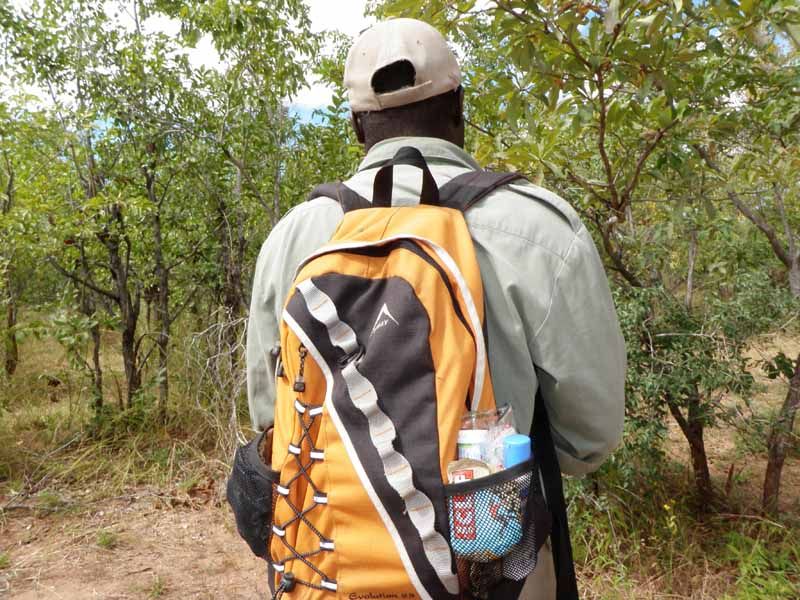 NUUN Hydration Tablets at REI: http://www.rei.com/product/791943 Neutrogena Sensitive Skin SPF 30 Sunblock - Available at CVS or online One last general thought regarding “walking” on safari – don’t let the PH kill you on the return trip to the truck! Time is important of course and one cannot mope along and expect to be successful, but 5-10 additional minutes here and there is not going to make or break a safari. Many times I have raced back to the truck, literally at a jog in order to keep up with the fast-walking trackers, only to arrive exhausted requiring 15 minutes of sitting in the truck to recover. The tracker will lead the way once the stalk/walk is called off, and at a pace that is often too fast for most hunters. Adjust the tips as necessary! After another bush lunch (sausage and peanut butter sandwiches, plus some sadza with the guys who invited us to join them), we walked a very picturesque stream bed hoping to jump something as we wound our way along the mostly dry river bed. I struggled a bit in the wet sand with the additional push-off required aggravating my gimpy right hip. Lunchtime for the guys, sadza and meat with sauce 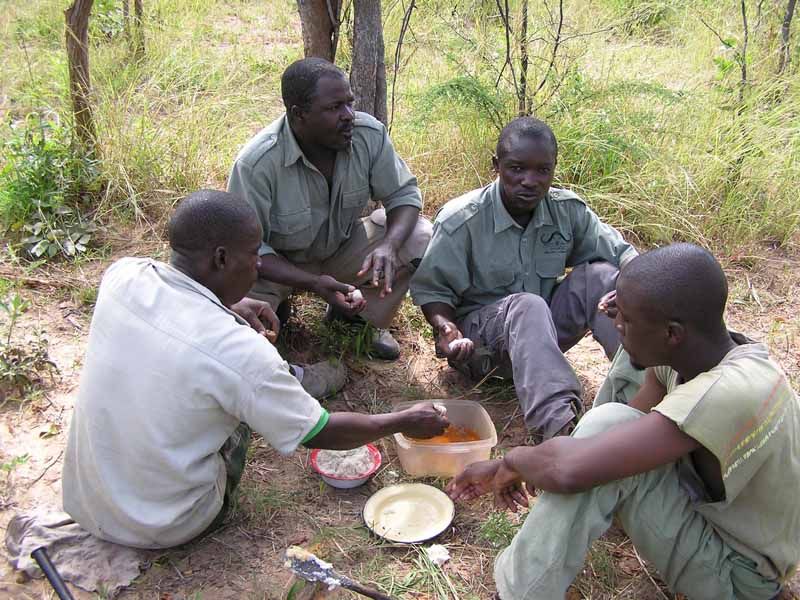 Streambed still with water walked in the last afternoon  Camp was relatively quite as most of the guys had departed for the other camp, and we enjoyed a nice T-bone steak. That night, despite some wonderful time in the field, I began to question the wisdom of not shooting that tuskless on Day-1. I reconciled that we had lots of time, and eventually good things would happen, and even if I went home empty-handed as I had done before, that would be okay. Who can argue with days spent in the field with your son, and a group of great guys who too are all enjoying themselves on a slightly more physical hunt than the norm (afterwards, Roy was very pleased with his new “slim figure”, and I too lost about 8 pounds from the mid-section). MONDAY - DAY-4 HUNTING – ELEPHANT COW CHARGE With my body systems getting in sync with the new time zone and schedule, I slept pretty well. Brett had no problems adjusting, oh to be 19 again. This morning we added a few fried eggs to our standard breakfast, and Mart commented how funny it is to watch the hunters as the days go on. The first few days, breakfasts are light, but by half-way thru the hunt they are pounding down huge volumes of cereal, toast, eggs, bacon, etc. The plan for the day was to continue our quest for croc bait, specifically tuskless elephant. We drove to Masampa area, checking the dirt track for fresh elephant sign as we drove. Mood on the truck was good; our group too was now in sync. The guys checked several groups of tracks, but all had signs of animal/insect activity over top of the tracks, and given our knowledge of the elephant movement, they were too old to follow. Finally we found fresh spoor, and after confirming the direction they were heading, we “kitted up” and began following. The herd was estimated at 8-10 elephant, and based on the tracks did not contain any young calves. It was a nice tracking pace thru the mopane scrub, with the air crisp and temperatures pleasurable. After an hour or so, Mart and Stephen spoke and it was relayed that they were headed for a block of thick bush, known as the Masampa Jesse. I thought “Here we go again, they will get there before we catch them and it will be game over”. After another 30-minutes of walking we reached the jesse, and the tracking pace slowed. It was not long until we heard sounds of the group feeding; snapping branches and stomach grumblings. Our movement slowed to a crawl, and Steven lit a cigarette, to keep track of the wind as well as to calm his nerves. Everyone else switched gears too, senses heightened. Move, check wind, freeze, listen...over and over again. The challenge becomes staying focused, and this includes the guys in the back of the line as they need to watch for elephant coming from the sides that we might have walked right by. The elephant crossed paths with a herd of buffalo, and for a period of time we followed their sounds until we realized that we were on the wrong animals. With tensions high, Steven joked that the elephant and buffalo had become friends. Not terribly funny now as I write this, but we found it hilarious at the time. There was little crunch to the ground, and given the size of our group, what would have sounded like a freight train was virtually silent. My Lowa’s proved to be the quietest boots that I have ever worn, and by placing each step outside foot first, I was able to avoid too many rearward glares from Mart. Finally we got a glimpse of the rear of the herd, which had stopped to feed and mull about. We saw only one elephant, a large tusked cow, but could hear more off to our right. Although the bush was not terribly thick when looking at distances of 10-20 feet, when trying to see further it all blended into a sea of green, and somehow the elephant’s large olive outline disappeared perfectly. The only way to evaluate the herd is to get low and look under the bush. For me, my hearing proved to be excellent and often I heard and pinpointed the exact location of an animal before even Stephen. However, I struggled to see the elephants until they moved. I tail flutter or a trunk movement was all it took, but otherwise and even with prompting I often was unable to see a particular animal a mere 30-40 yards away. Unable to see the other elephants, but pinned in place by the cow at the rear, we waited at a reasonable distance for a few minutes. As the cow was at ease, Mart coaxed Steven out of the way and he and I moved up a few feet, in the hopes of getting a clear view of the rest of the herd. Mart squatted, gun resting on the ground in front of him and the barrel pointed in the air lying on his shoulder. Not having binoculars, I hunched and tried to minimize my profile as much as possible (I was later told by Roy that this was impossible!). Roy was behind us a few feet, filming as is his job, while the rest of the group including Brett and Dalton waited behind yet further. The cow was calmly feeding, and this was no different than dozens of other approaches that I had done before on previous tuskless elephant hunts with Mart and in Chewore North, Deka Tail and Makuti with Buzz Charlton. Mart continued to check the wind and glass, and we eased up another 5 yards, to the point where he could begin to make out feet and knees. As it was pointless for me to try to see these other elephant, I focused my attentions on the cow feeding some 20-25 yards in front of us, head and trunk to our left, tail to our right, body just about parallel. What happened next was fast, and surreal. The cow, without warning or hesitation - not even a flick of the tail or a curling of the trunk or a shift of the ears - exploded from behind the bush and came straight towards us. I had a solid hold on my rifle, and recall thumbing the safety from the second position two clicks as I brought the rifle up. Things began to slow, and somewhat in disbelief my first thought was “Is this a real charge?” It was immediately apparent that it was indeed, she was coming straight and determined. The next thought was, “I am going to shoot if Martin does not”. With this, Mart’s gun fired and as she continued to lower her head I saw the top of her forehead, and knowing the brain was right underneath, shot. According to the guys it was literally “boom-boom”, it is amazing how the mind slows and the thoughts flow clear. This all happened in seconds, counting it back, before I can get to a third “Mississippi”. Entrance hole of my .450gr handloaded Barned flat point solid 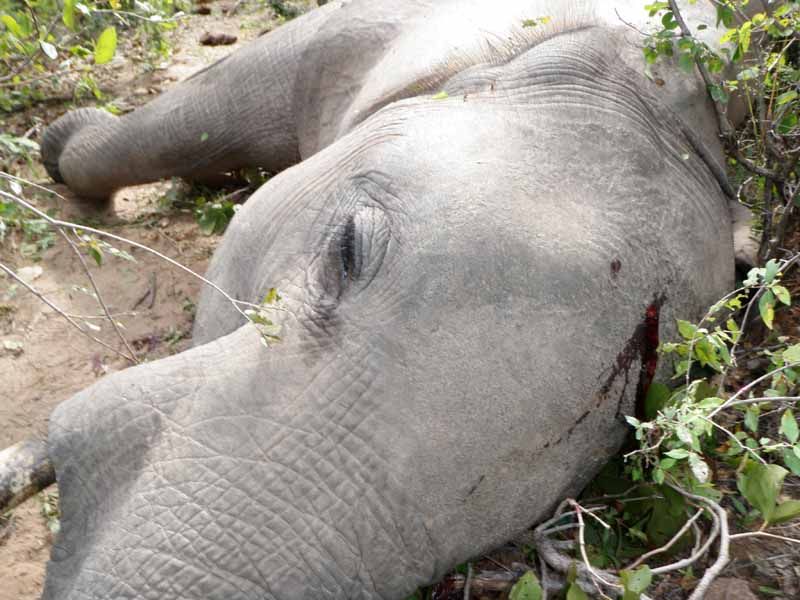 Out of the corner of my eye I saw Martin to my left go backwards and down. The cows eyes were fixed on mine, I can still see her right eye clearly, as she fell, momentum carrying her to within 5-6 feet of our position. With Mart down, and without thinking, I cycled another round and moved forward several steps, parallel to the downed cow’s head, muzzle pointed at where I expected her brain to be. Sensing movement and approaching elephant in the bush in front of us at about two o’clock, I stepped forward another right then left foot, and aimed the rifle at the head of a closing gray mass. Mart had regained his feet, and was to my right rear. He poked the cow in the open eye with the end of his double to confirm she was dead. There was no reaction, just more movement in front and to our right. “BACK BACK BACK!” We retreated several steps, first backpedaling then turning and running a few steps. I can actually recall thinking to make sure my rifle stayed skyward, finger on the trigger guard. I had no fear until I turned my back, and as I found before, I would much prefer to stand and face whatever than turn and run, as this is truly terrifying…especially if you are a slow runner like me! After retreating a modest distance we turned and faced forward again, exchanging “What the shit” glances in the process. I did not see it, but Brett and Dalton both watched as a cow, probably the matriarch, rammed into the rear end of the fallen elephant in an attempt to left her off the ground, which as Mart later said to have meant “Get up, didn’t you hear those shots, we must go!”. Our group assembled but the elephant were now getting angry, screaming and busting brush, perhaps deciding whether or not to come for us. We moved back again to the far edge of a clearing, and took up a line with 4 guns (458 Lott, .470NE.458 Winchester, .375 H&H – oh yea - and one HD camera!) ready for whatever came. Fortunately nothing did, and after 10 minutes Brett fired a .375 round into the air and the remaining elephant departed. Shortly after the shooting, trying to put the pieces together 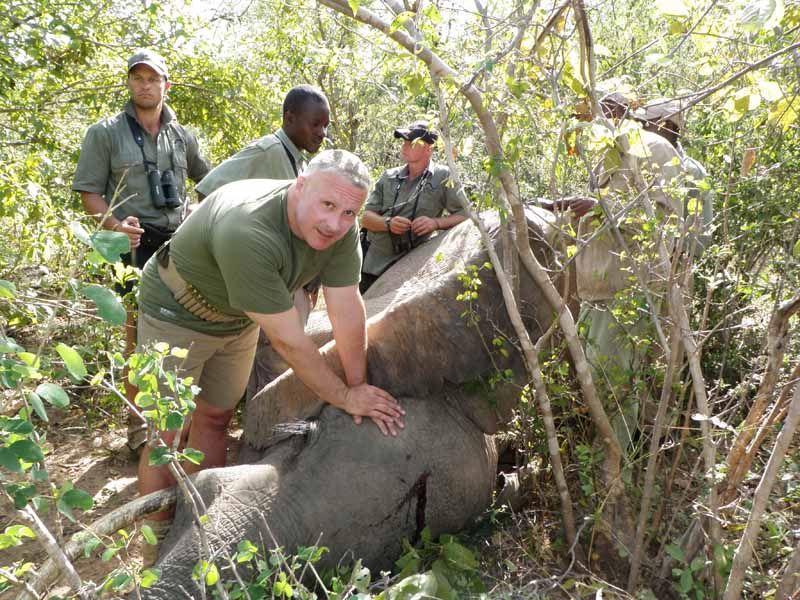 The reason for the charge is perplexing, and the suddenness of it astounding. There have been times in the past when I was expecting, or at least ready for a charge, where I had an opportunity to gather my wits and think thru what my plan will be. Numerous times my PH and I have flicked off our safeties and shouldered our guns, in the end not having to fire. What was impressive about this charge was that she went from totally at ease to an all out charge in one fluid, seamless movement. Obviously after detecting our presence, she instantly decided that we were too close for comfort, and who knows perhaps having a bad day or with the memory of an encounter with a poacher or previous hunter still haunting her, she came. I do not resent her or her decision, in fact, in some strange way I admire them. The cow charged from behind the bush in the center of the picture, standing with her rear to the right of the last/largest dung pile, head/trunk on the left. The picture was taken from where I was standing when I shot. 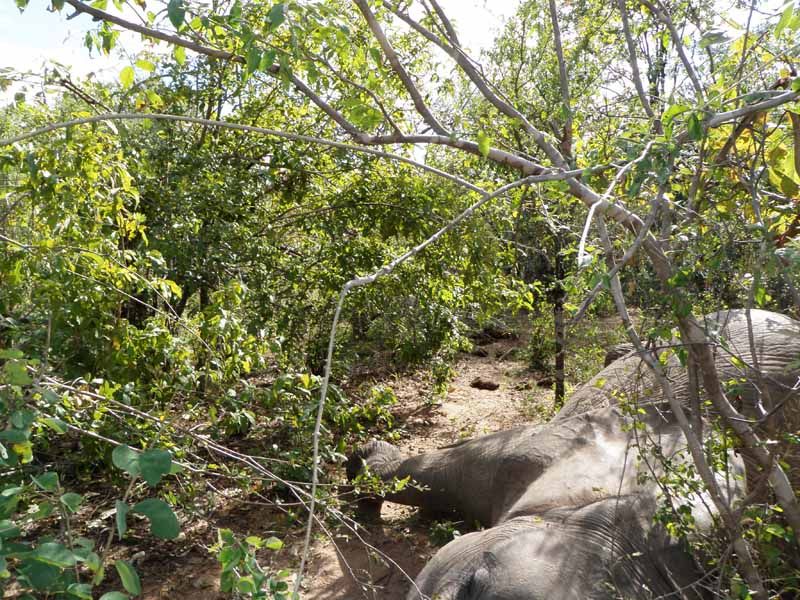 With no time for “shouting down” the cow, Mart did a great job getting one shot off from his squatting position. Shooting up, and hoping to at the very least just turn the charge, his shot entered low and broke her neck at the base of the skull. Her head was coming down as she approached, but what I last saw when I shot was probably the rapid drop resulting from the impact of Mart’s bullet. In the end, we both did our jobs, and although unfortunate for the elephant, nobody was hurt (well except for the cuts on the back of Mart’s legs from the scrub he landed in), and having witnessed it from a distance, the Game Scout agreed completely that the shooting was unavoidable. Looking at the bruise on my upper inside bicep, I never did get the rifle shouldered. A few other interesting notes beyond the obvious that we can take away from this: (a) it is not always possible to get two shots off even with a double; (b) one needs to be very familiar with ones rifle, be it bolt action or a double, as muscle-memory may be all that one has to rely on, noting that had I bought that beautiful 450NE VC double that I had been jonesing for in January and given my hectic work schedule, I don’t know that I’d be here writing this story; and (c) a .~500gr + bullet, preferably carried in two guns (PH and hunter), is a very good idea if one is going to be hunting elephant in anything but open country. Unfortunately, we were unable to capture this on film. Although ready and filming for the majority of time, given the delay in time, the disposition of the elephant, and assuming that we would be dictating the next move, Roy had turned around to film the guys to our rear. He said he heard a commotion, but by the time he swung around the elephant was already going down. No worries, as the scene is forever burned into my mind, and I do have witnesses! Having read Ian Nyschens “Months in The Sun” more times than I care to admit, and fantasized about what I would do if such a situation were to occur, I was shocked that afterwards it was pretty much business as usual. No trembling hands, no shakes, no flashbacks...nothing. Weird. Hey, we’re still here!!! (either that or Roy cut another joke!)  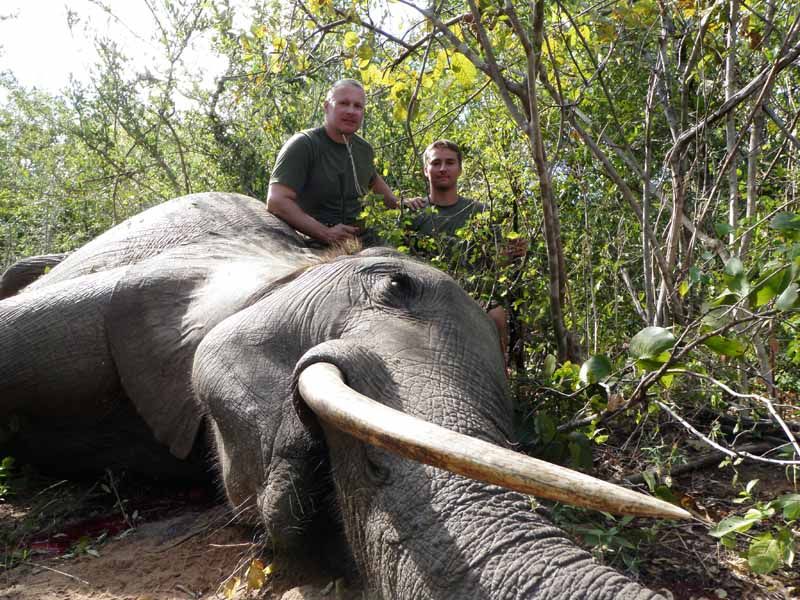 We retrieved the Cruiser and ate our packed lunch and sadza, sharing some with an old man who happened to be walking by. Whenever I see somebody of his age, I wonder about all the changes and amazing things they must have seen and experienced in their lifetime. 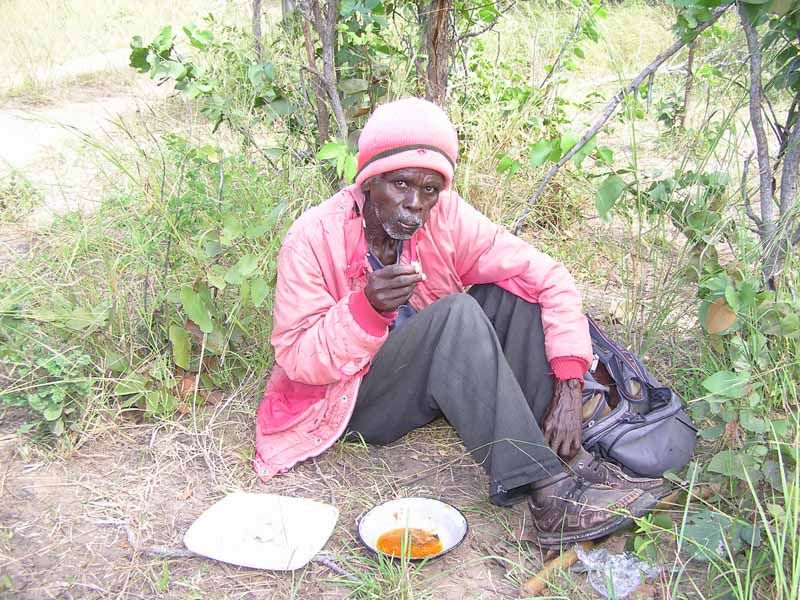 With enough excitement for one day, instead of letting the appy’s perform the recovery we decided to do it ourselves. Too, I thought this would be a great experience for Brett who has never seen an elephant processed by the villagers. We drove to the nearby villages to pick up some “strong oaks” for the skinning and quartering, putting word out along the way. In one of the villages, the men were away, but the women were present, one taking quite a liking to Brett which we all found very, very amusing.  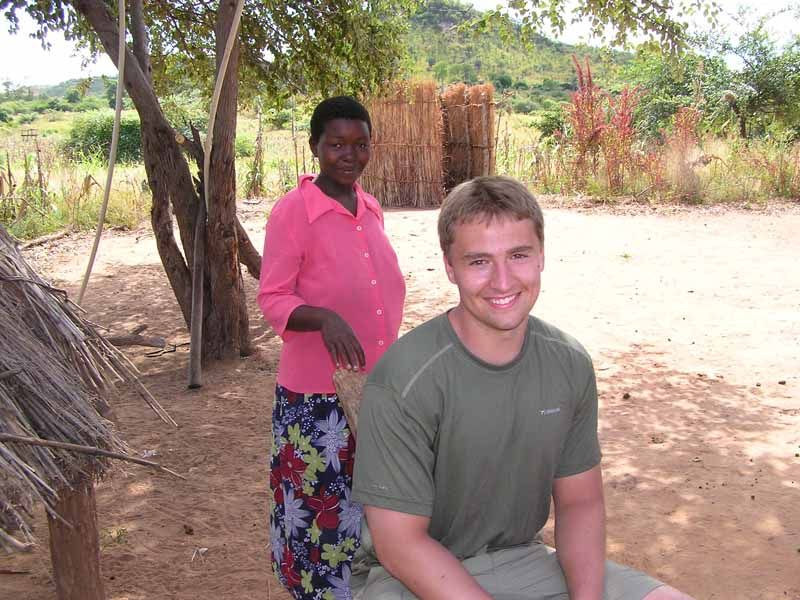 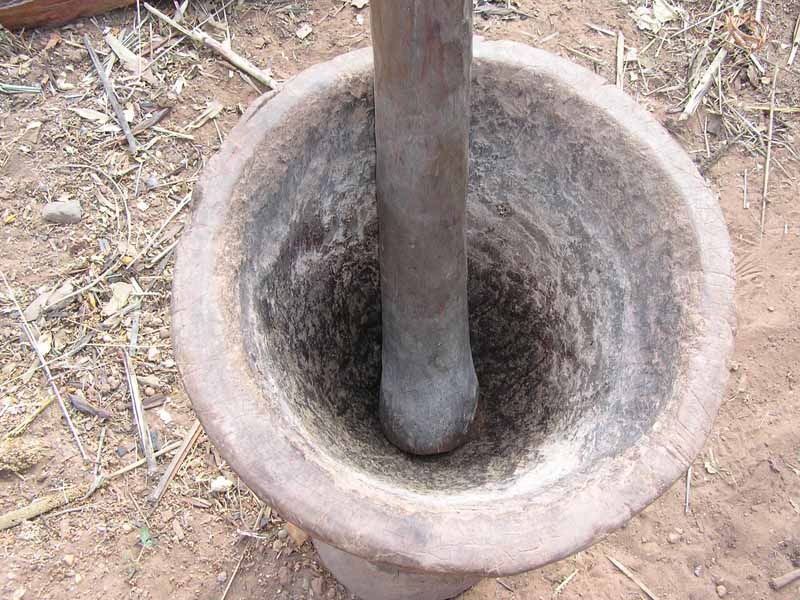 With the help of a dozen or so men from the village, we (and when I say “we”, I mean “Dalt”) cut a road from the main dirt track to the kill site. The recovery was somewhat chaotic, and in the darkening late afternoon sky, a bit eerie. Dalt takes control of the process, making sure it is done in as orderly a fashion as possible, at least until the masses are allowed in to begin hacking at the carcass. At this point, we departed, best to not be present, as all too often somebody loses a finger (for any of you hunting with or in camp with Mart, ask him about the time he sort of “sewed” the thumb back on a guy in Botswana). Brett, who desperately wants to become a doctor and has a real caring for others especially those less fortunate, remarked afterwards that after seeing the impact the meat had on the people, he had virtually no remaining remorse regarding the death of the elephant, and that if people could only experience what we had just witnessed and participated in, they would understand. Yes, indeed. 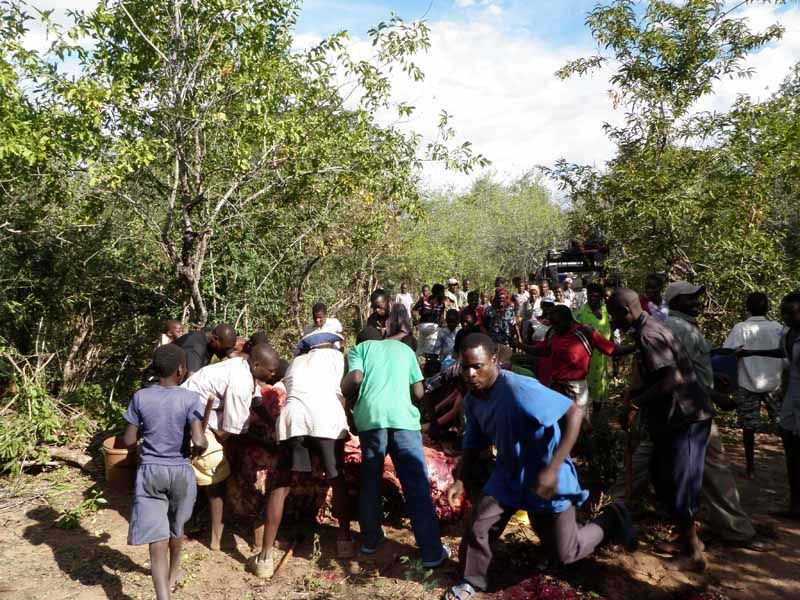 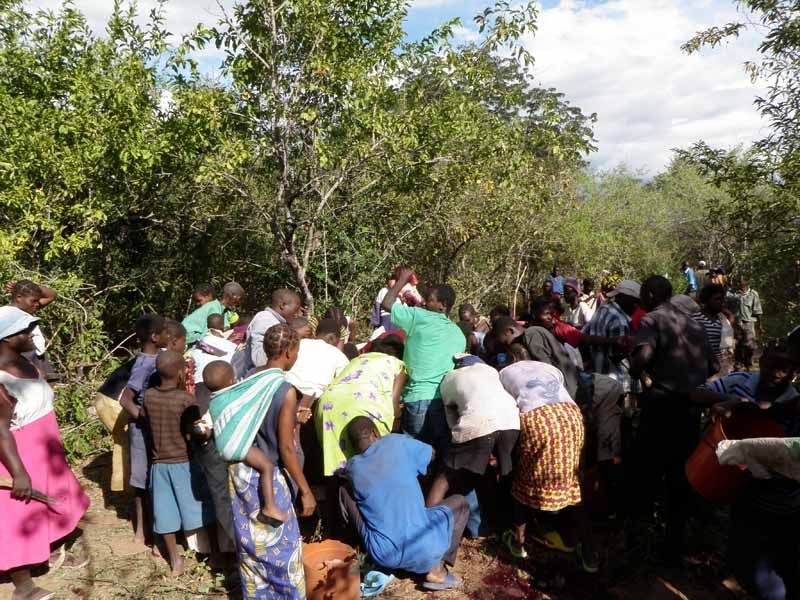 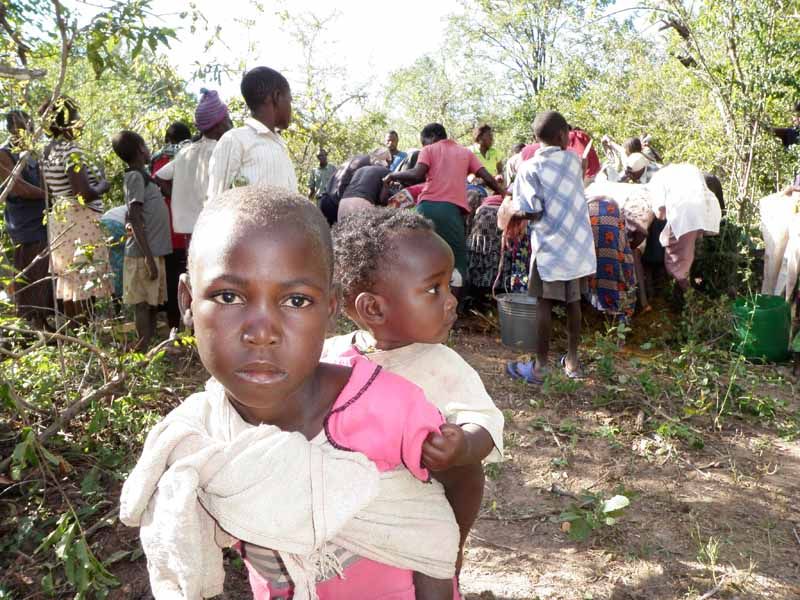 That evening we took a boat ride, telling ourselves that it was to look for sand banks for croc baiting, but in reality I think it was necessary to unwind from the day’s events. Roy was a sport, and agreed to have a few beers on my behalf! The sunset was glorious. 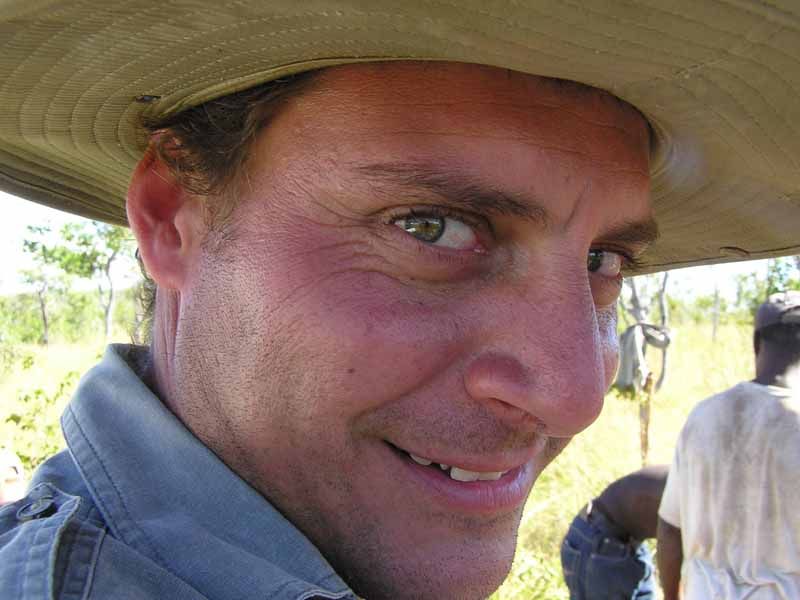 DAY-5 HUNTING – HIPPO AMBUSH Shrugging off the excitement of yesterday, our plan for the morning was to walk a valley, starting at the Ume River and ending at an area referred to as Eddy’s Spring, which would be about 6k’s. On our way, we encountered a small group of feeding elephant, all tusked. I guess looking to stretch the legs and/or take a nature break, Mart stopped the truck and he and Roy (who was the copilot this trip as I preferred to stay on the back w/Brett, Dalt and the gang) got out. The rest of us stayed on the truck as they walked towards the feeding elephant, not getting any closer than perhaps 75-yards. I was standing on the back, casually observing, not paying them or the elephant any particular attention, when I heard “WHAT!?!?” and looked up to see Mart and Roy running towards the truck with an angry cow elephant in hot pursuit. I wished I would have looked at Roy’s expression, as I am sure it was priceless. Instead, I fumbled with the zipper on the case containing my Lott (which from here on remained slightly open). Dalt took over, and handed me the rifle. I cycled a round and thought “Oh crap, here we go again”. The guys had fortunately left their doors open, and they jumped inside slamming them shut. The cow was still coming fast, almost at us, and I mentally drew a line in the air which if she crossed, I was going to shoot, as given her lowering head it sure looked as though she had every intention of ramming the side of the Cruiser where I stood. Just then Mart started the truck and she locked them up, literally skidding to within feet of us. She threw up her head and ran off, yelling as she departed. Now fully awake, we continued to the Ume River and the starting point for our walk. The area had gotten rain overnight, which is very unusual for the end of May, and the grass was soaking wet. The hiking was brisk and enjoyable, as we worked our way up and down and around the valley floor. Some fresh tracks of kudu, sable and buffalo, but no game was seen. After about two hours, we stopped in a clearing to take a break. 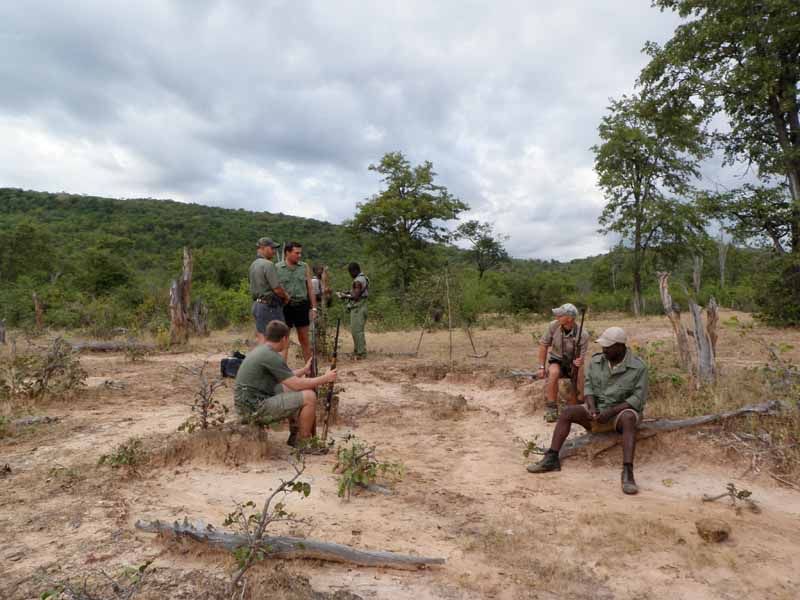 I didn’t ask, but could tell from experience that given the relaxed atmosphere, we were nearing the end of the walk and that the likelihood of encountering game was low. I had thrown in the backpack before we started walking a Ziploc bag of Jolly Ranchers, and this was the perfect time to hand some out. Actually, over the course of the safari, I found that there is never a bad time to hand out Jolly Ranchers and the guys came to look forward to the daily treats. Dalt had lost a screw in his Model 70 the day before, and was carrying Roy’s latest acquisition, a “FAB NAT D’ARMES…” in .458 Winchester. In light of recent events, we studied the safety mechanism, looking for a way to replace the factory system with a more familiar unit that Roy could operate using his right hand. Any information on this rifle, and specifically available modifications to the safety, would be appreciated and passed along to Roy.  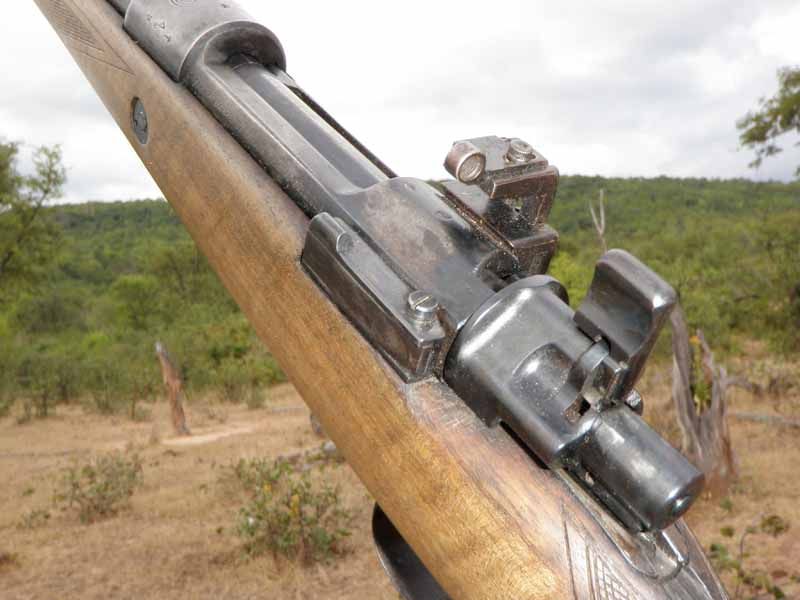 A few yards from the area where we were relaxing was a small mud wallow, with porcupine quills scattered all over. Still in a relaxed mood, we began collecting them to take back to town for Mart’s kids. Interspersed among the thick stout black and white quills were long thin ones, a foot to a foot and a half long, which I had never seen before. The trail of quills led away from the mud wallow, along a path, and naturally we followed, Mart and Roy in the lead. (We later surmised that a croc had taken the porcupine, and dragged it off to deeper water.) I lost interest in the quills, and focused my attention on the steep drop-off created by running water during the wet season, which with my tight hip, caused me to fall slightly behind the guys. Successfully navigating my way down the drop, as I rounded a corner in the trail, I heard a commotion ahead and something to the effect of “RUN”. Mart, Roy, Dalt and Steven came racing toward me, so I thought it best to join them, not sure at this point what we were running from. One of them yelled “Hippo”, which was apparently all the incentive I needed to somehow jump back up the drop-off. At the top, we turned around facing the direction that we expected the hippo to come from, and my thought was “What the Hell are we running for, we have the guns”. With this, there was a crashing in the bush to our left at about 10-o’clock, and everybody took off again. So bringing up the rear, I followed down the trail. As with the elephant, I thought to myself how much I hate turning my back, and recall thinking that at any moment I could be chomped from behind, but humorously what a great decoy I was making. We ended up back at the clearing where we had been relaxing and regrouped. Brett said he heard the action ahead, and he actually passed the trackers. Good boy! The bull hippo launched his first attack from the pool of water  We caught our breath, and laughed about what had just happened, which seems to be a universal, naturally hard-wired reaction, probably the same way our ancestors calmed their nerves after a close encounter with a saber toothed tiger! I am not sure if I even saw the hippo, but having come across the one days earlier in the jesse, I had no problem imaging exactly what the guys had encountered. After about 5 minutes, Dalt tip-toed into the grass to the left of the trail, trying to get a different angle just in case the hippo was hiding where we last left him. Of course, this was the perfect opportunity for Roy to launch an elephant dung ball his way, and we busted out laughing at Dalt’s reaction, hands and rifle in the air covering his face, just like the zombie move in the Michael Jackson Thriller video, certain that he was about to be eaten. Another 5 minutes tick by, everything is quiet, so Mart says “Ok, lets go”. The assumption was that the hippo had moved back into the water, or most probably buggered out of there. We were going to follow the trail and retrieve all the stuff that the guys had dropped when the charge came (Roy lost a hat, Dalt his Leatherman, and Steven his radio), and if possible cut a path to the right before the water thereby avoiding another confrontation. Stephen and Mart went first, followed by Roy who was eager to film whatever might happen. I followed, but something was just not right. I cannot explain it, but as I walked I kept the rifle at the ready in front of me, scanning the bush. Brett said that I looked back at he and Dalt, motioning with my head and eyes to the scrub and grass to our left. Dalt, who was in front of Brett at this point, slowed his pace. As I turned around and took another couple of steps, the hippo busted from behind a thick patch of green brush, not more than 25-feet away. He came boiling straight for me, and my only thought this time was to “SHOOT”, saving valuable milliseconds. Once again, time slowed. I recall bringing up the gun and clicking off the safety, watching him approach with amazing speed and agility. I saw his forehead, and thought “Right there, easy shot”. By the time I pulled the trigger, he was at about an arm’s length from the end of my barrel, and I could see his eyes looking directly at mine. From a ready position, gun held in both hands in front of you, swing the rifle up but don’t shoulder it, clicking off the safety, and pull the trigger – all as fast as you can. This is how long it took. Mart said later that in his 17 years, he has never been involved in or witnessed a faster, more determined charge. He slid towards me, just as I expected him to, and I remember thinking how graceful it all was. Unconsciously I jumped out of the way, allowing him to slide past where I was standing, his neck ending up about where I would have been. I cycled another round and pointed the muzzle of the rifle at his ear, but he was dead. As he was charging centered on me, and being right-handed, the .450gr Barnes FPS entered slightly to the right but angled left, going straight thru his brain. His legs were tucked backwards, having gone limp while the momentum kept him going after the lights went out. Mart was there in seconds, with a panicked look on his face that broke into a huge smile of relief as he realized that I was in one piece and the hippo was dead. The boys came from the other direction, and it took a few seconds for them to comprehend what had happened, and that the hippo had charged and that it was me that had shot it. Everybody was braced for action, eyes wide, guns at the ready. Thankfully it was over, as a lot can go wrong when the lead starts flying. I do not know what the bulls plans were, if he intended to bowl me over, or open his mouth and chomp at the last moment, or both. He was coming dead-square on me, and behind me was a wall of green riverine bush, so I am 100% certain that had very bad intentions on his mind. I am also under the belief that it was a pre-meditated ambush, as he seemingly allowed the first wave to pass by before launching his attack. He was standing behind the bush, obviously well concealed, facing the direction from which we were coming. I am just thankful that he came at me, and not the boys. Bull hippo that ambush charged from 25-feet  Shot thru the brain, fired arms length from the end of the barrel 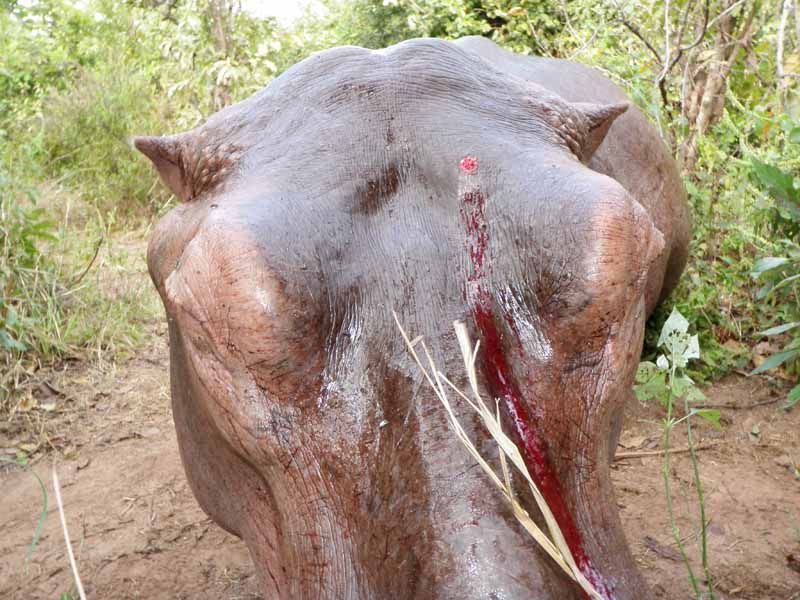 Note his neck is middle of the trail where I was standing when I shot 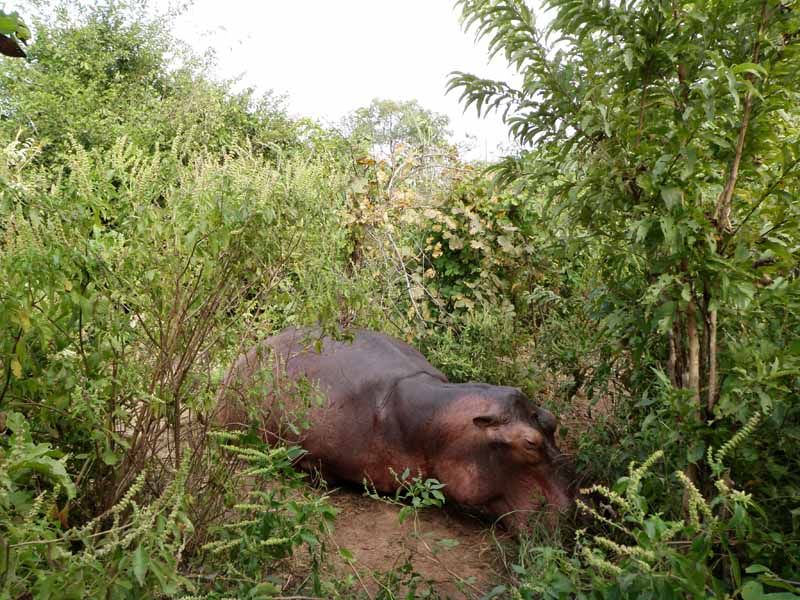 The thick bush behind me would have prevented retreat, not that this was an option 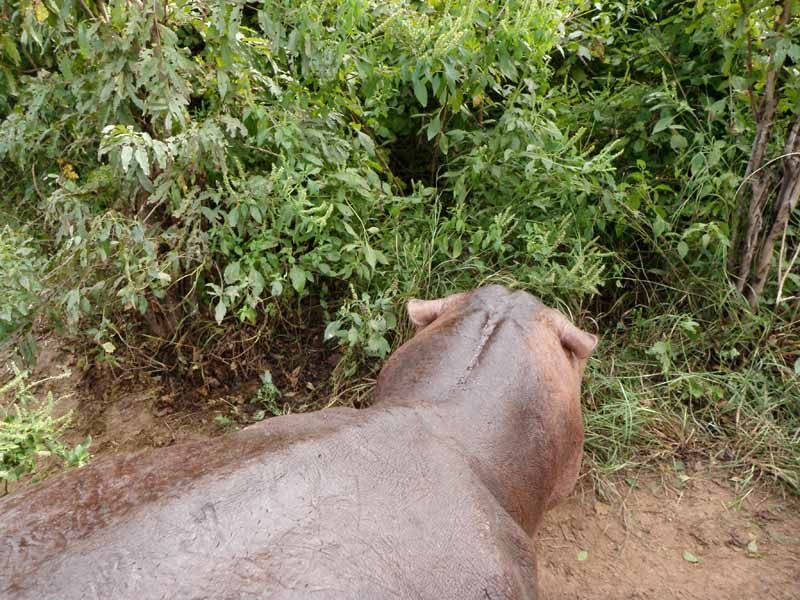 Note how his legs are tucked behind him, and the slide marks on the ground from his head 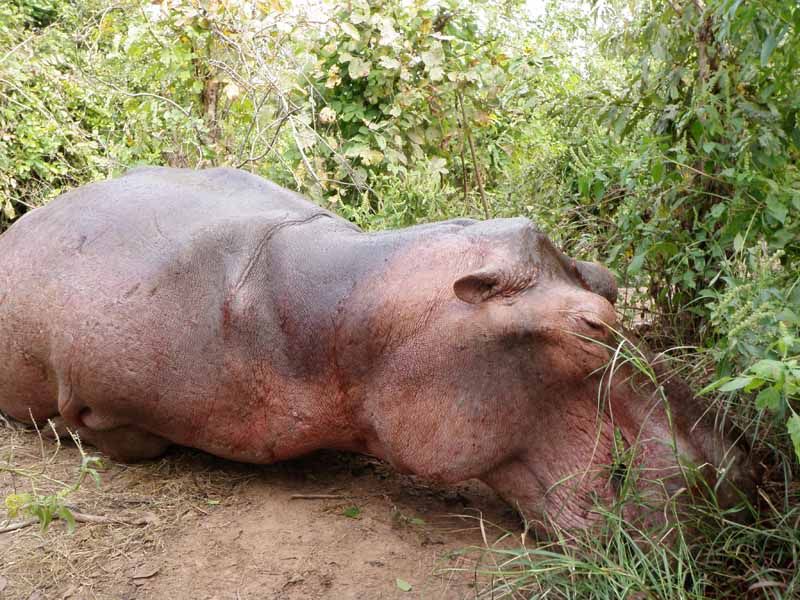 The gang, still in disbelief…the looks say it all 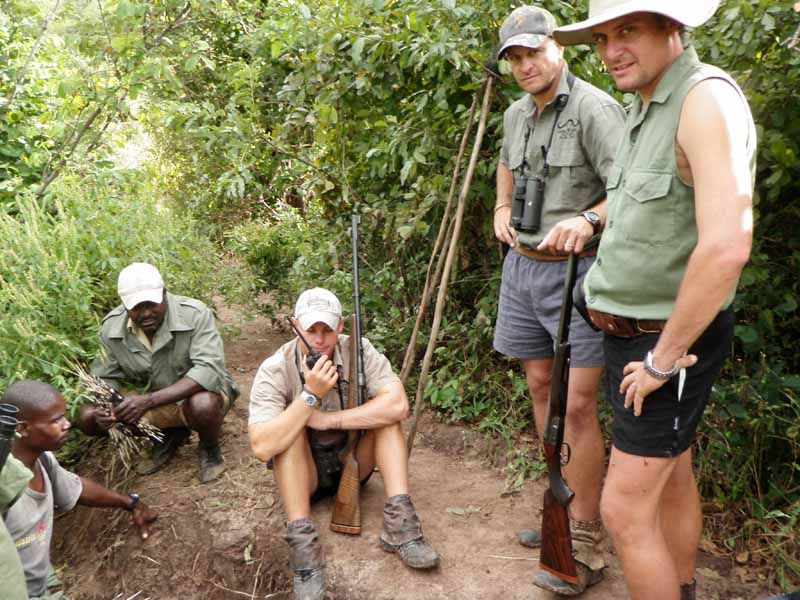 My Ruger Lott on the bottom, notice the “hippo snot” which covered both me and rifle 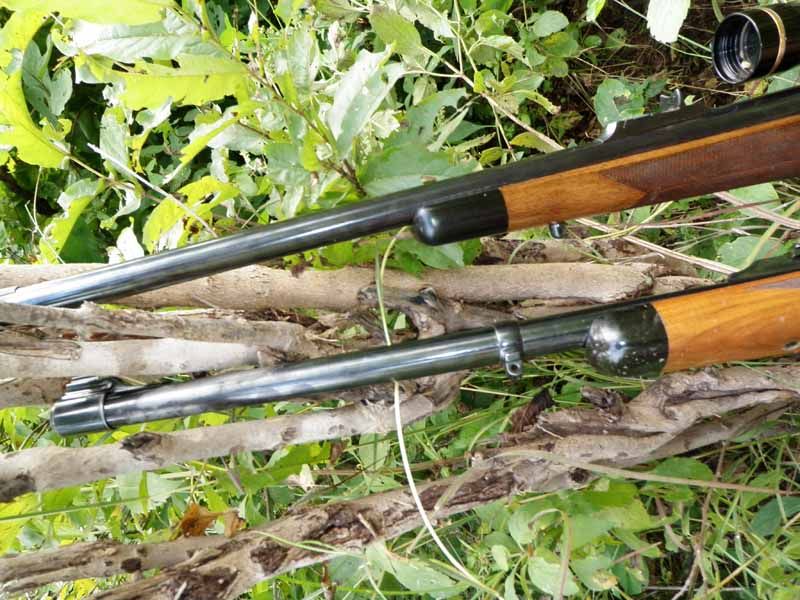 Why this hippo bull attacked we will never know. Piecing it together, it is easy to come up with a likely scenario. He was mature and full-sized but not an old bull, probably pushed out of the pod by the dominant male. Until he was able to challenge a herd bull and take over the females, he found refuge in the deep pool of water, some 5k’s from the Ume River. Three weeks earlier, while working on the roads, Dalton and Reward followed human footprints from the dirt track down the stream, figuring they were fish poachers. In a deep pool of water farther upstream from our encounter, they saw bubbles, and thinking is was a croc got closer to inspect. A hippo exploded from the water and gave chase. Unarmed, Dalt said he never ran so fast in his life. Without question this was the same hippo, and eventually he would have caught somebody. Most likely he had been harassed by the local fisherman, who throw stones and run, trying to get them out of the pool of water where they want to fish or net. If I were a lonely and celibate hippo getting pelted with rocks, I think I would be aggressive too. What is impressive was his cleverness, he did not just want to chase us away, he wanted to make somebody pay. Dalt radioed camp, and Reward was dispatched with some guys to perform the recovery. Although the majority of meat had to go to the villagers, we were able to retain the innards and feet to use for croc bait, plus a few chunks of meat that we would make into biltong (I have to admit, I really enjoyed eating him). This, plus some of the guts from the cow elephant, gave us enough scraps to bait one area, now it was just a matter of letting it ferment a few days so as to be irresistible to the crocs! Camp guys on their way to recover the hippo (note the shirt on the guy in the back) 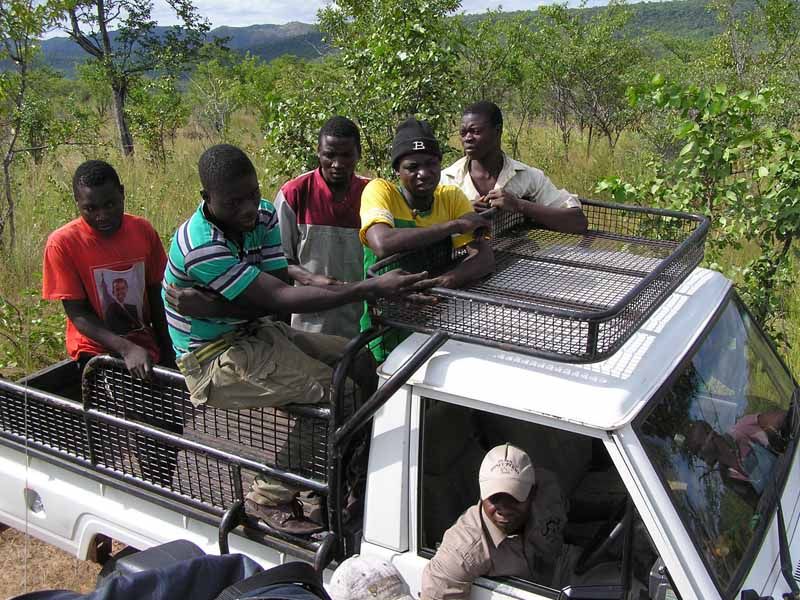 On the way back to camp, we passed Gerhard, camp manger and head of anti-poaching for Martin (per my report from last year, Martin reinvests considerable money back into anti-poaching). In his vehicle were several well-armed and ready for action National Parks Scouts. Having worked in the SAVE Conservancy for the past 6-years doing anti-poaching, Gerhard brings a lot of experience to the table. And while he is new to camp management, his main focus is in organizing and refining the anti-poaching activities of Martin’s 25 men, as well as coordinating efforts and sharing intel with the National Parks Scouts, who are armed and with a “shoot onsite” policy should be considered “dangerous” by any poacher found carrying a firearm. They were happy to pose for pictures, and as we parted, I wished them “good hunting”. National Parks Scouts - armed and ready for action 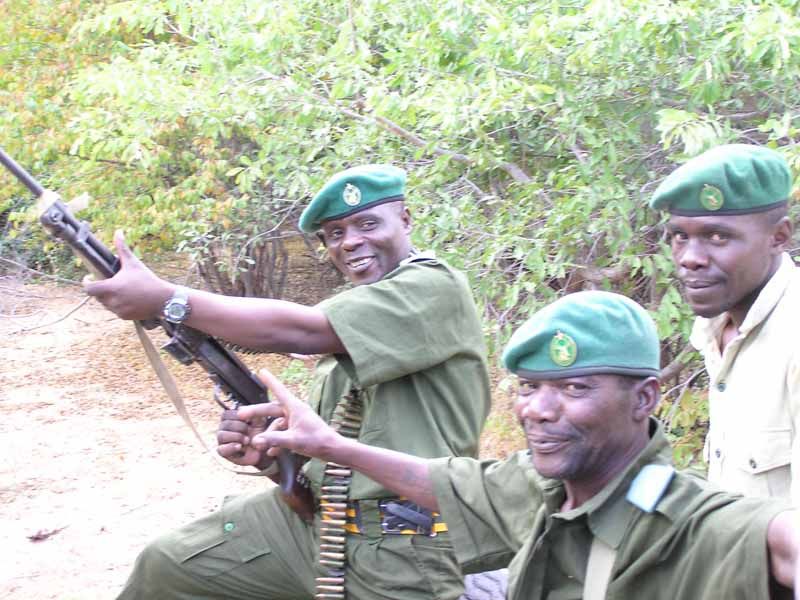  Later that afternoon, we went to see the local “Prophet”. I don’t have the full story on this man, but from what Dalton said, people come from all over Zimbabwe and as far as Botswana to see him and ask for his help and guidance. He is not a “witchdoctor”, but Christian or at least some derivative thereof (he wore a cross), and capable of removing spells, dispelling evil spirits, and all sorts of other amazing feats including using magic to determine who is lying (useful when stuff gets stolen and the thief, rather than bursting into flames breaks and confesses). It was not important if we believed, what mattered was that the trackers do, and they were quite shaken by the events of the last two days. They needed to see the Prophet so that whatever was plaguing our group could be removed, and we needed to get Steven and Witness back into the game. Anyone familiar with the beliefs of the rural Africans knows how engrained into their culture “black magic” is, and it was important for us as outsiders to not disrespect it. We may have been the only Americans to ever visit this Prophet, I don’t know. But our ability to jip in front of a long line of believers says that he was eager to have us as his guests, errr, patients. We all crammed into a small mud hut, and as the “old man” (hey, it’s a sign of respect in Africa!) I was given the only stool. In the other half of the rectangular hut was chickens. The Prophet was not dressed as I would have expected, instead of a traditional robe or other African garb, he wore a faded Champion shirt and a pair of Adidas shorts. Well at least he didn’t bring his cell phone with him. Picture from inside the Prophet’s lair  I won’t detail every aspect of the session, but suffice to say that it involved water, fire, smoke, and chants in a foreign (as in from another planet) dialect that included an elephant “bbbrrrurrrr”. Martin and Roy (with his wild eyes and sh*t-eating grin) were no help in maintaining composure when things got whacky, but the Prophet seemed to have a good sense of humor and none of us caught fire so it must have been ok. However, watching Steven and Witness (who was literally trembling, look at his expression in the picture above) made me appreciate how real it was to them. The Prophet told us that two curses had been placed on MP Safaris, one by a staff member who “wanted to ride on the truck with us”, and another by an man who was angry that Martin would not hire him (weird thing was that the previous day, Mart “filed” a hand-written résumé from somebody looking for employment). He said, “Someone was meant to die!” The Prophet could temporarily remove these curses, but Martin would need to return to have them permanently dealt with. We needed to supply him with the tip of the elephant’s trunk, which we had with us to deliver to Chief Mola, and Martin needed to gather and bring back several additional things including lion dung. Our assumption was that although not necessary to remove our spells, down the road they would be just the ticket to help some poor sole solve their problem. The Prophet had me state my wishes for the hunt, and gave me a small plastic wrapped bag of something fibrous (goat crap, hashish, I don’t know) that I was to carry in my pocket for the duration of the hunt. This would keep us safe, although it could not guarantee success on the hunt. Sounded fair enough to me, and each day I dutifully carried the “good mojo”, showing it to Steven before heading into the jesse or anything remotely dangerous. At the end of the hunt, Roy returned the bag of mojo, as instructed by the Prophet, with another 50lb bag of salt that his village uses to dry fish. The strange thing is that after three charges in ~ 24 hours, it all stopped. Hummm. As all watched, we got back in the truck and drove down the dirt path leading away from the Prophet's village, and stopped to get a drink and gather our thoughts. Looking back, Mart commented that "the hills have eyes". We dropped off the ele trunk, throwing candy (including a couple of Fire Balls) to the kids as we went by. Delivering the elephant’s trunk to Chief Mola who was the Mola Primary School 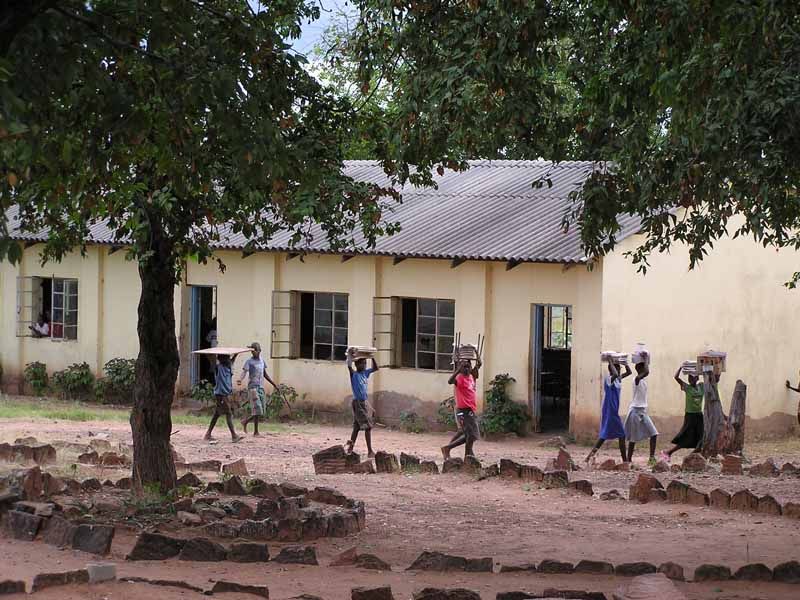  Not yet done with the day, we drove and then walked to an area along the Ume River where there was known to be a lot of crocs, as well as some exposed sand banks. A few weeks prior, Pierre had taken a 14.5 foot croc with a client from this area, which was considered to be the dominant croc at the time. It was possible that another big croc moved in, or #2 would be good enough. I was not after length as much as age, and made it clear that an old croc missing an end of his tail would be a fine trophy for me. There were croc’s everywhere in the water. We spread some gore on the sand bank and threw chunks into the river (when I say “we”, I mean “Dalt”), and built a basic blind. It did not take more than 20-minutes for the first crocs to begin slithering up on the bank. There are so many that they compete aggressively for food, and after shooting one it is not uncommon for the others to return within minutes of the Cruiser departing. We saw one 13.5 footer, which while being long, looked young with a narrow head. There was another older croc, with a fatter head, pronounced horns, and funky teeth. He was also missing a good bit of tail. We would be back. | |||
|
| one of us |
DAY-6 HUNTING – SPIKE CAMP/EXPLORING We (and when I saw “we”, I mean “Dalt”) worked several hours last night organizing everything that we would need to setup a spike camp. A location was identified along Lake Kariba, halfway between the Ume and Mackenzies. We would ride in Mart’s speedboat, exploring along the way, meeting up with the Cruiser late afternoon to setup camp. I didn’t think too deeply about this at the time and took it all for granted, but as I write this, I am impressed at what Mart was able to organize seemingly without much effort. The boat ride was fun, and once we arrived to our final destination, we walked the banks and scouted for fresh croc or elephant sign. Some of the rivers were previously inaccessible, except during the rainy months, and we motored past villages and fields much to the astonishment of children who might not have ever seen a motorized boat before. Fisherman out on the lake, noting I don’t think the boat is “hippo/croc proof” 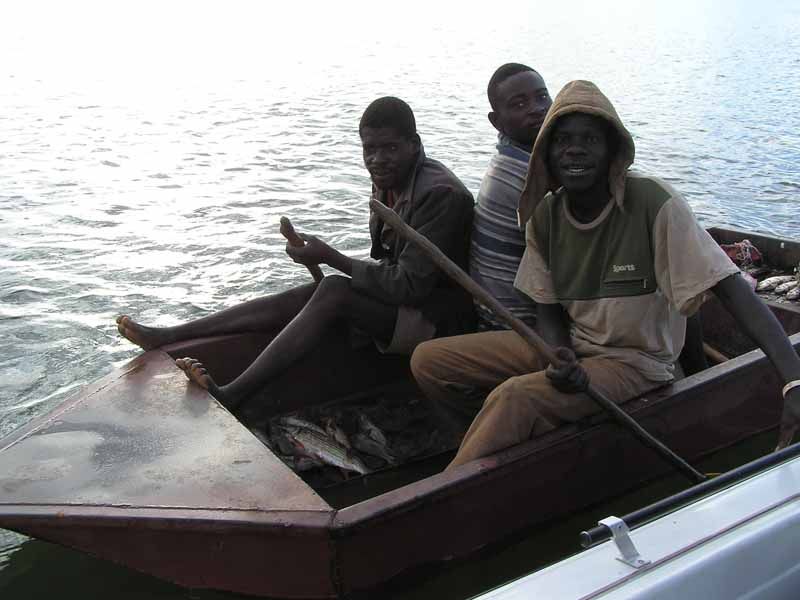 Exploring rivers and inlets via boat, which I referred to as The African Queen 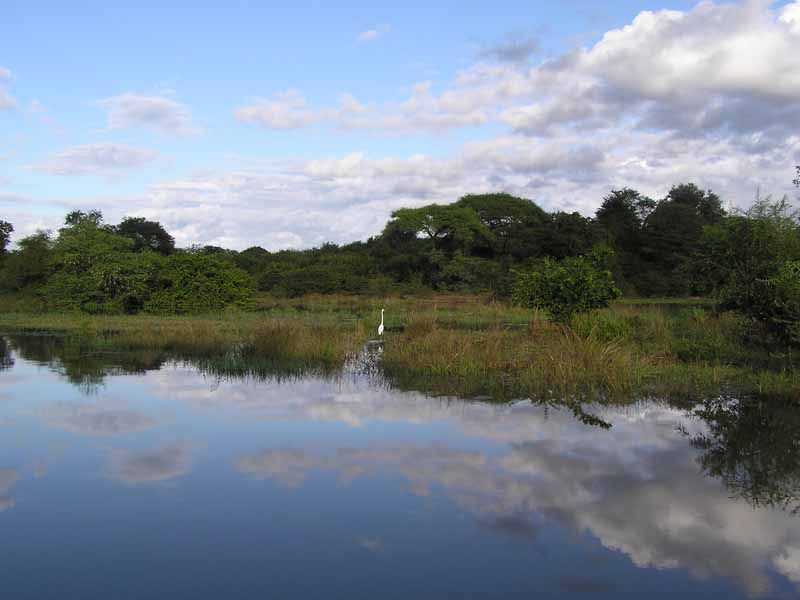 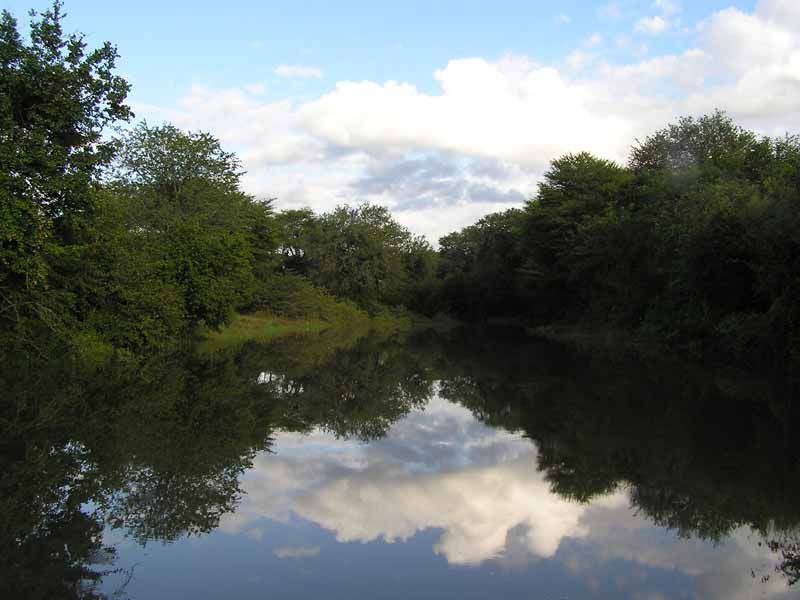 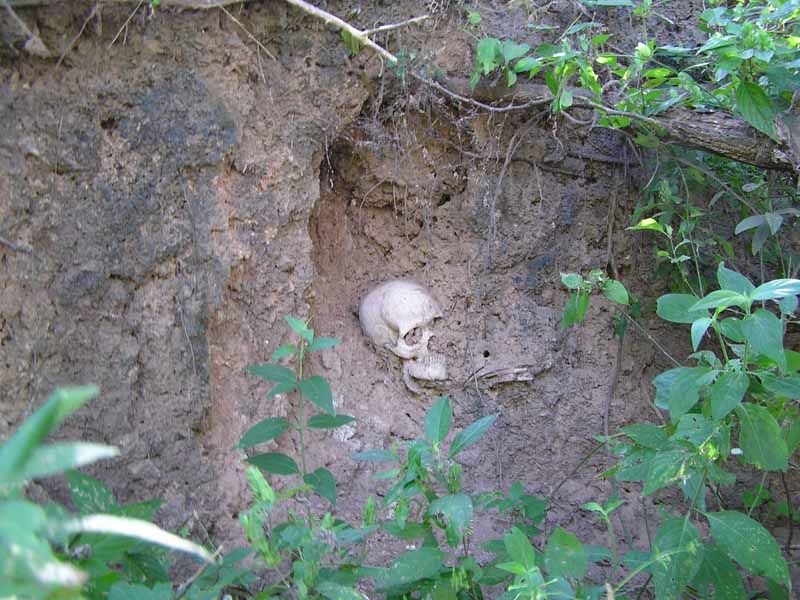 Later that morning we parked the boat, and took a 4+ hour walk up and along a range of hills, overlooking a huge valley. Initially we followed some elephant, but they were walking fast and blended into several groups of buffalo. From atop the hill we were able to glass, and confirm that there was no tuskless in the group, nor any “scrum cap” buffalo. We radioed Dalt who stayed with the boat, and he met us for a much appreciated pickup. I felt great on our climb up the hill, but the decent was tough on my nagging hip, and by the time I reached the boat I was a bit angry at the world. But nothing a cold Coke Light, and a couple of peanut butter sandwiches could not resolve! My Gore-Tex lined Lowa Zephyr GTX’s with SPENCO Hiker (Green) inserts and Smartwool Light Hiker socks tucked under my Gators worked perfectly here, and in all situations encountered during the hunt, and I am thrilled to report zero blisters. They were of course broken in, but nevertheless considering that we encountered everything from soft sand to hard-pack ground to boulder-hopping, I am quite pleased. Brett, who at 19 can wear just about anything without problem, did well with a $75 pair of Merrill Moab Ventilators, and low-cut Smartwool socks. 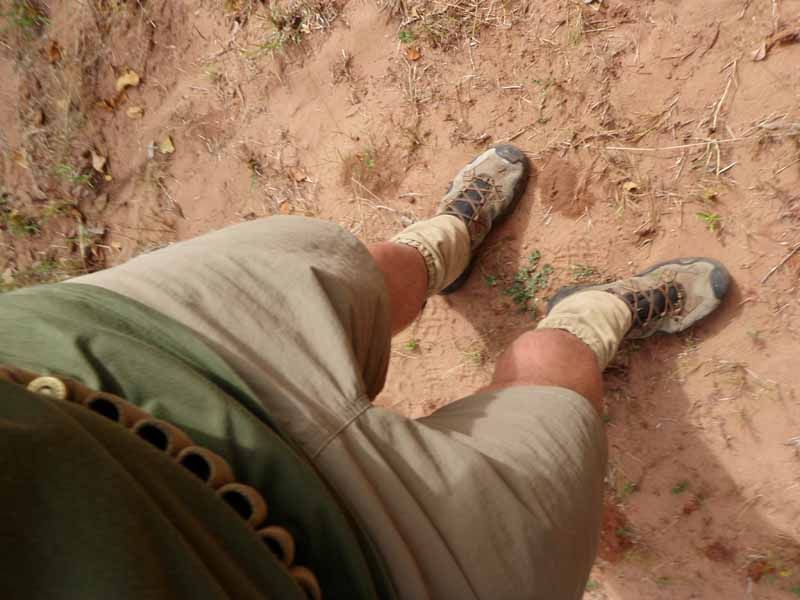 We continued exploring and marveling at what we were discovering, as if for the first time. A late day walk proved pointless, as the area which Steven had contained a lot of game, was totally poached out. Our group collected 24 snares, and Mart made a note to have his scouts plus a few Parks Rangers visit the surrounding villages for a little chat. Poachers snares, which decimated a once game-rich area 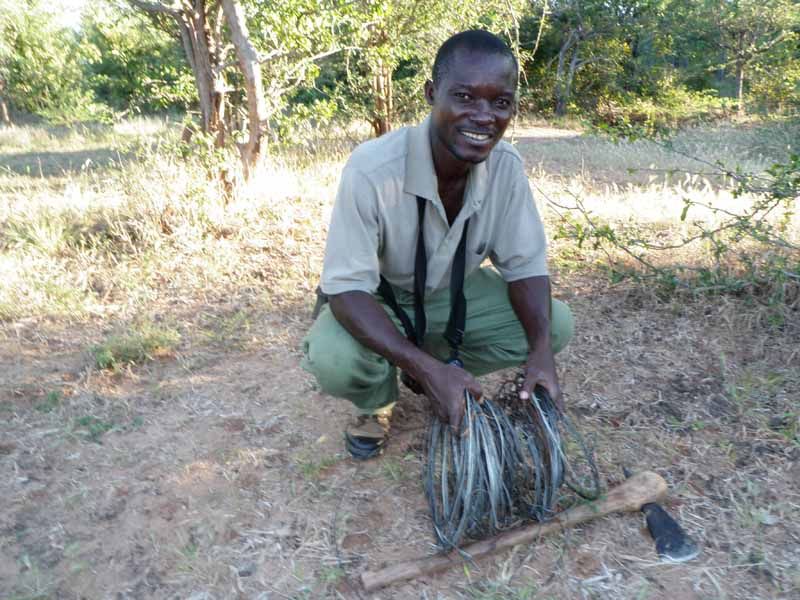 We motored into what was to be our camp for the night, a great location on a piece of land jutting out into the lake, with water (and hippos!) on either side. The guys had already begun the setup of the camp, which we completed. Then there was a bit of a scare. After some quiet confabbing, Roy and Mart hopped into the cruiser with the stated objective of “collecting firewood”. This was totally out of character, and they were grinning funny. So I pressed Dalt who folded and said that they were panicked as the cook forgot to pack beer, and one must have beer when sleeping under a mosquito net. So their plan was to drive to Bumi Hills and try to buy some. Fortunately, after about 5 minutes of driving, Roy employed his keen senses to smell around the truck, and low and behold in the bottom of the day cooler there were six Zambezi’s – Happy Days! 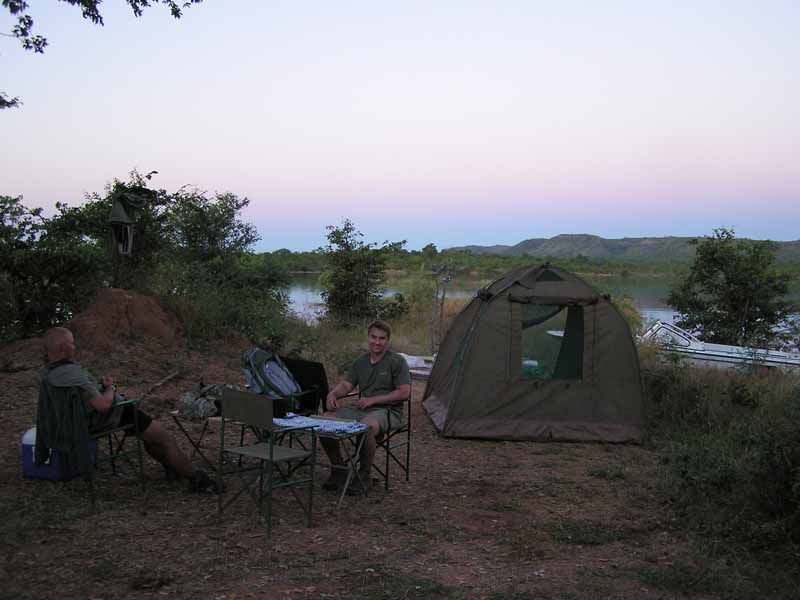 Dinner under the starts was awesome, and I think the meat in gravy over top of sadza – a specialty of Chef Steven, aka lead tracker - was the best meal of the trip! 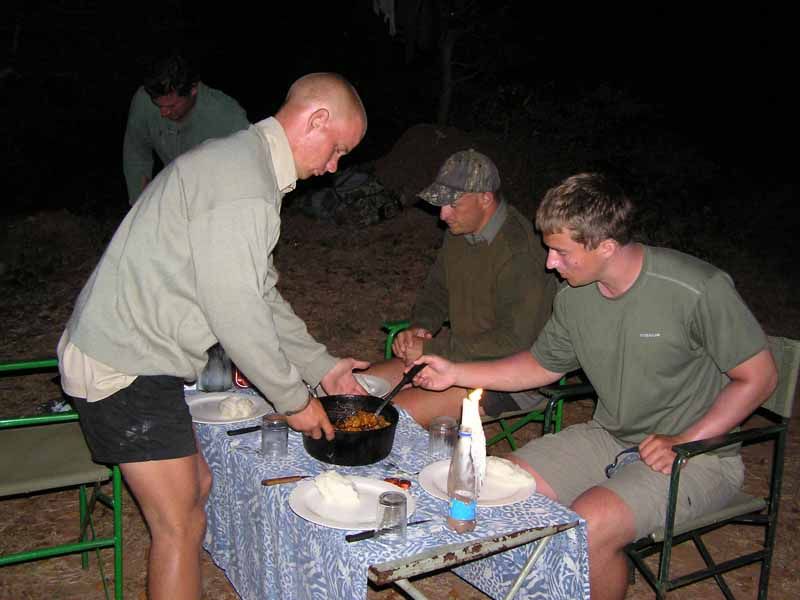 Our security system (he slept like that all night, from 8pm to 5am)  Setup of the mosquito nets was absolutely hilarious, as Mart and Roy and Dalt discovered and came to terms with what awaited them. The mattresses were about an inch thick, we were short one pillow, the mosquito netting full of holes, and just like boarding school the last one to get started (Mart) got stuck with the scraps. During dinner, dew had soaked everything to the point that we thought it had rained and we somehow missed it. Everything was wet and soggy, so they built a fire, then another, and then a third until smoke was blowing in every direction. 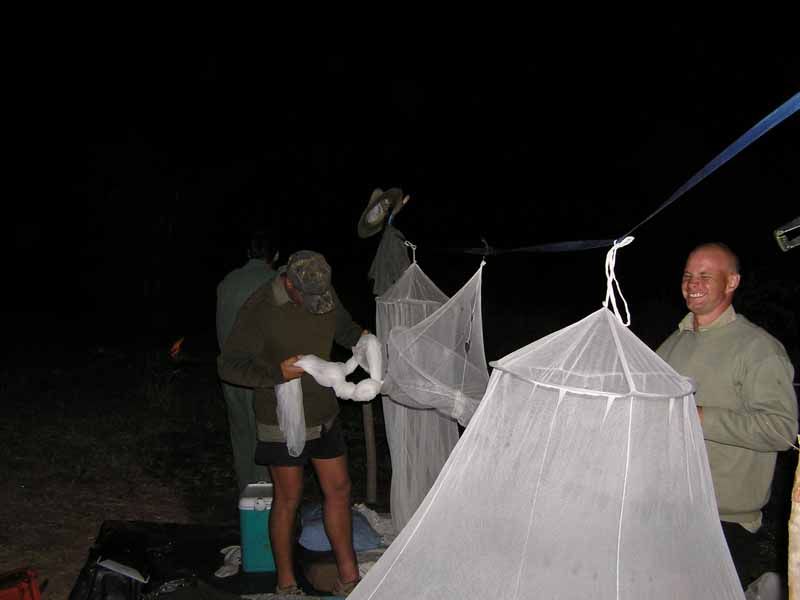 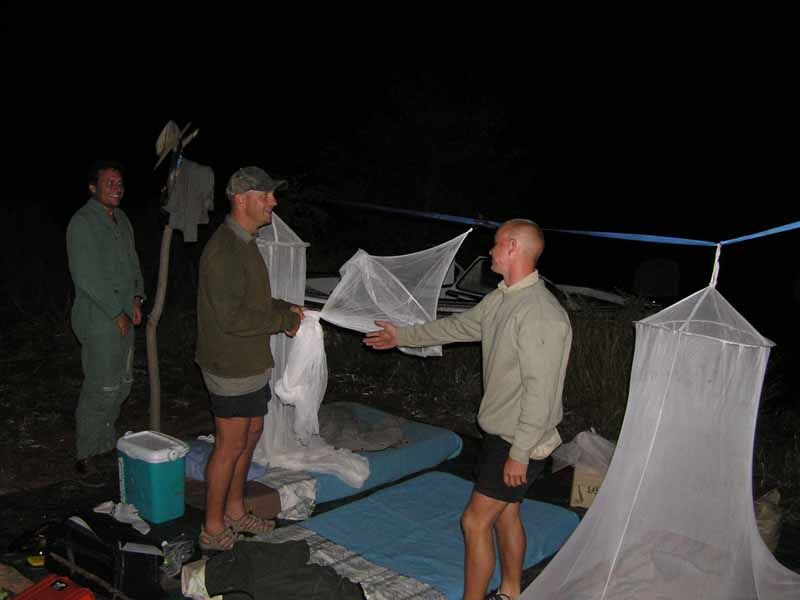 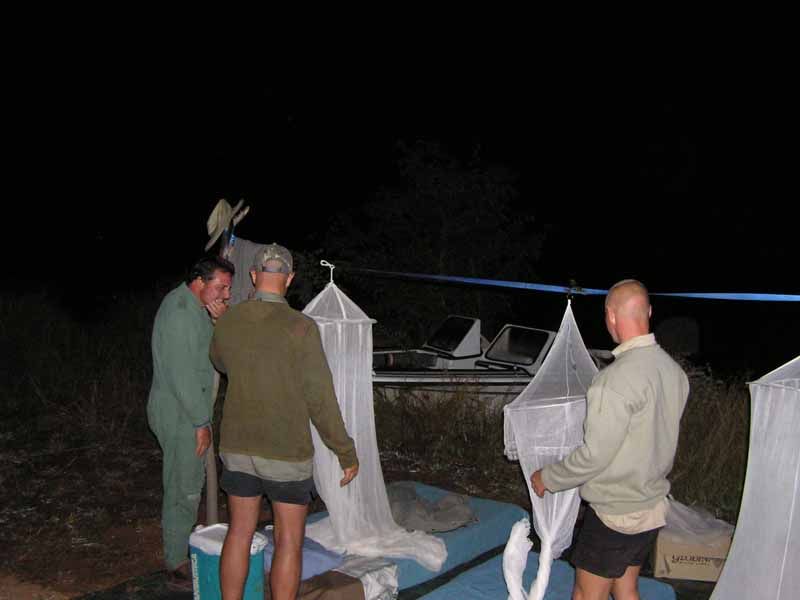 I laughed until my stomach hurt. Then zipped up my tent, pulled up the covers, and went to sleep. DAY-7 HUNTING – SPIKE CAMP/EXPLORING We awoke with the sun, and a beautiful sunrise it was. Breakfast was delicious - oats, toast and fried eggs, cooked over an open fire. 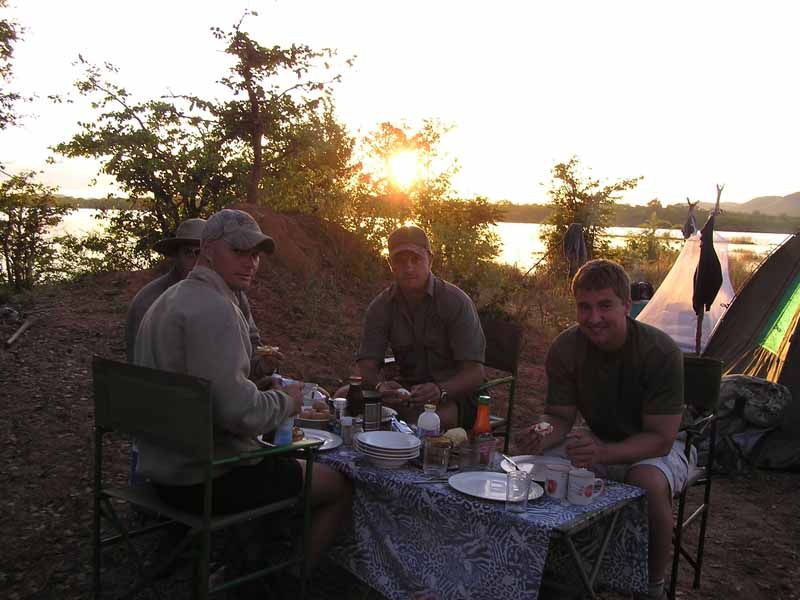 The guys started the break-down of camp, and we got back in the boat for another day of river exploration and hiking. Another secluded and somewhat spooky stream…wait, did you hear a banjo? 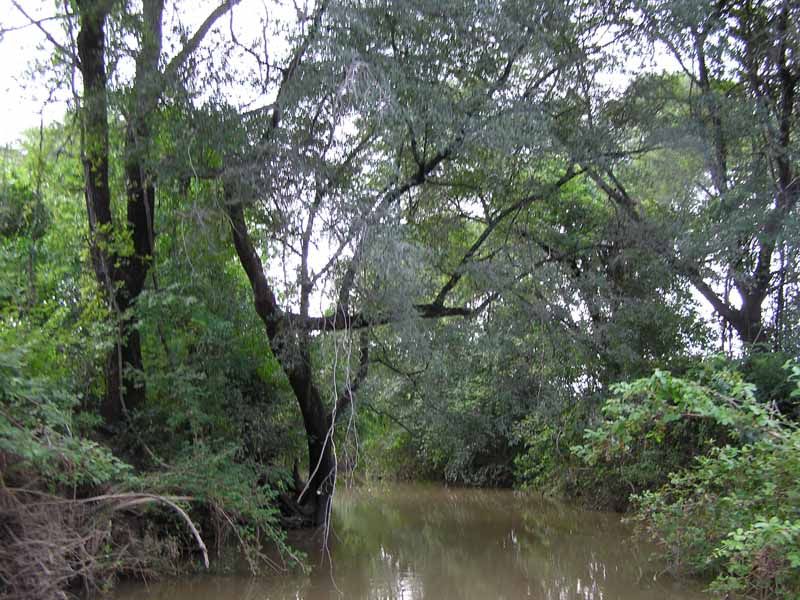 Steven checked with a few of the people tending their fields, but none reported any recent elephant activity. Except one, where an old man, and I mean a really old man, said that the elephant had been in one of the villages “not far” from the river last night. I was highly skeptical, but with not too many other options, the decision was made to follow the old man for a while and see if we could verify his story. Field where the old man told us of recent elephant activity  The old man’s hut 50-feet from the river 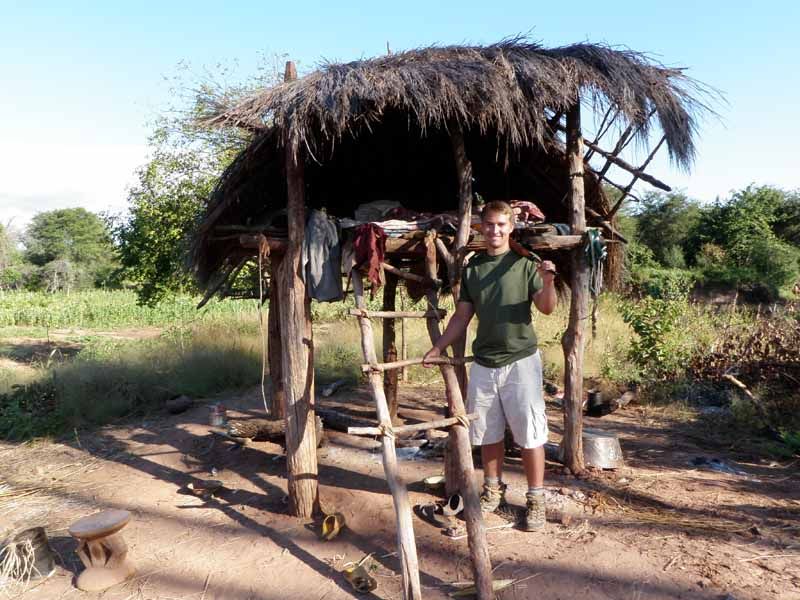 After about what seemed like an hour but was probably less, Steven confirmed that there was fairly recent elephant sign, however, it appeared to be older than last night. My inclination was to turn back, as although this was classic “PAC Hunting” which Brett had yet to experience, the odds of the herd containing a tuskless was maybe 1 in 10, assuming we ever got on them, and assuming she didn’t have a dependent calf. So, I placed the probably at about 3%, which made marching in the humid heat a struggle. I began referring to the old man as “our PH”, and Roy caught some flak from Mart as a result of a few well-placed clever remarks, being told he was “girlie”. Did I mention that it was hot and humid? And that Dalt was snoozing again in the boat? Village passed thru while following the ghosts of marauding elephant 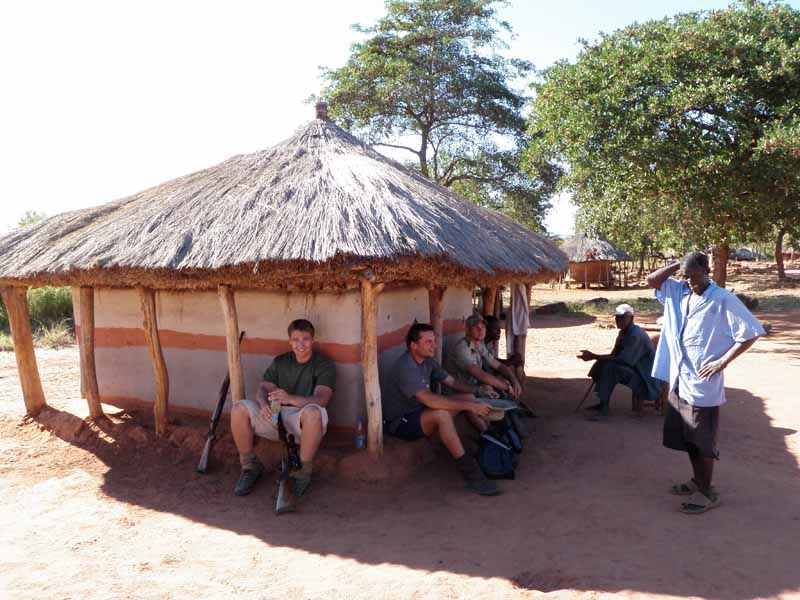 The old man and our new appy PH 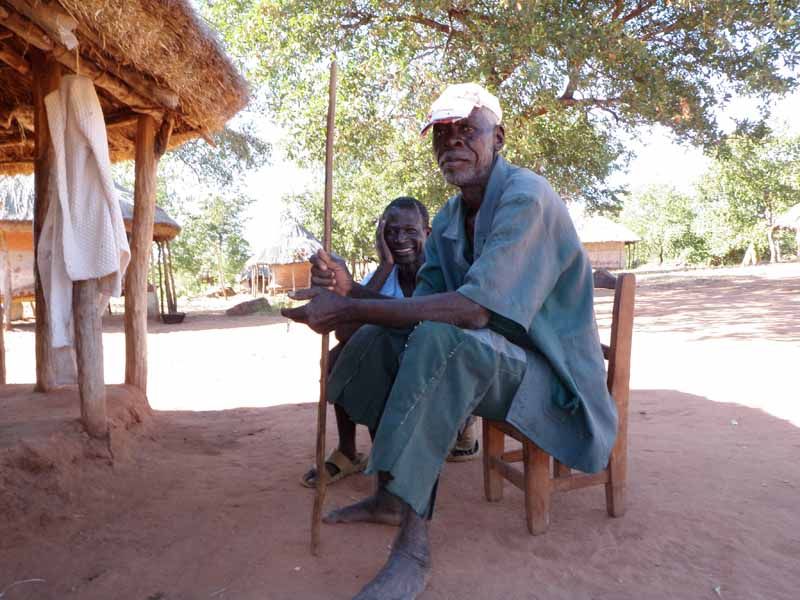 We continued our pursuit another hour or so, following paths thru fields and villages. Eventually we picked up another “PH”, who collaborated the story of marauding elephants, and offered to help guide us to the area where they hold up during the day. He was certain of this as he has seen them there many times, it was very thick and secluded, and they spend their days there. Another couple of villages, and I was still dwelling on the exact location of this elephant haven, so masking my true intentions I halted the parade for a water break, and asked. Mart asked Steven, who asked the old man, who answered Steven, who relayed it to Mart, who by this time looked rather sheepish, wearing the same sort of face he had on when he gave me the “We are going to go collect firewood” story. The conversation went something like this: “He said over that mountain.” “Over THAT mountain?” “Yes that one.” “The one way over there, off in the horizon, that you can barely see?” “Yea, that’s where they are.” We kept walking, and the blue mountain off in the distance was getting closer, but it was taking a toll. We did, however, get to meet more of the neighbors.  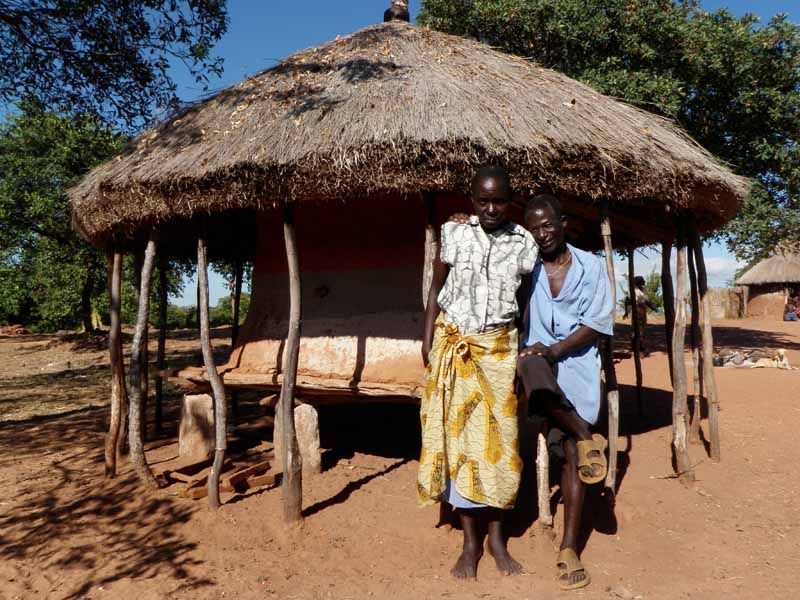 Eventually, we stopped, as at this point we were getting farther and farther away from the boat, and we were not able to reach the camp to have a truck sent to a rendezvous location ahead. This is when our new appy PH impressed me the most, and pulled a doozie out of his bag of tricks. He disappeared into a thick ravine for a few minutes, and then sprung back up with a wet and nicely molded elephant dung ball. He said with all the enthusiasm that he could muster, that "it was fresh, still moist from this morning", and that we were "getting very close!” I could see that Mart was very impressed, and made a mental note to incorporate this one into the training material for this year’s batch of new apprentice hunters. The walk back to the boat sucked. When we passed the well where the children were getting water, I winged my plastic bottle at them. I missed, and regretted not filling it with sand first. They thought I was giving it to them to use, and thanked me, so it worked out okay. Feeling guilty, I promised to come back next year with “rock candy and pencils”. 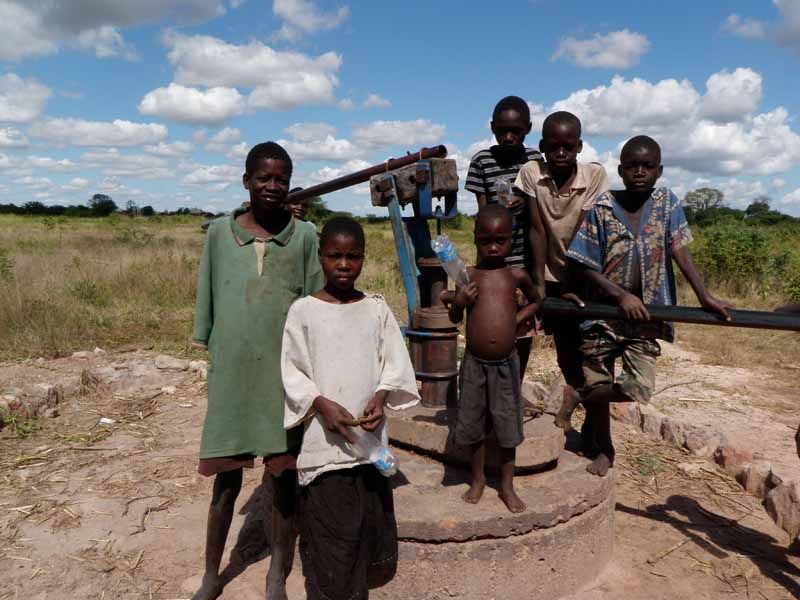 The above recollection of the day’s events is meant to be tongue-in-cheek. However, in all seriousness, the old man was freaking amazing. He walked at a brisk pace for hours, over terrain that gave me problems, in bare feet. He told Steven that years ago, when he was young, he would meet hunters in Chitekete, and porter them into the area to hunt for months at a time. The stories this man must have boggles the mind, what a shame for it to be lost with time. On the way back to our main Ume River camp, with the guns cased, we photographed herds of elephant coming to the river to drink. But without a floodplain, there was far less game on the banks than even what I had seen last year in March (check out the report from last year). This was a strange year, and I would not expect to encounter these conditions again. One herd contained two bulls, one of which was a large bodied bull with thick tusks. While not as visually impressive as the usual smaller-bodied, thin-tusked Omay bulls, he was probably carrying 30-35lbs of ivory thanks to thick bases. [Later in the evening while talking to the other camp, the sighting was relayed as one of the guys was hunting elephant. They shot the bull the following day, after picking up tracks and following for hours.] Cow with long ivory (left) & trophy bull (right) 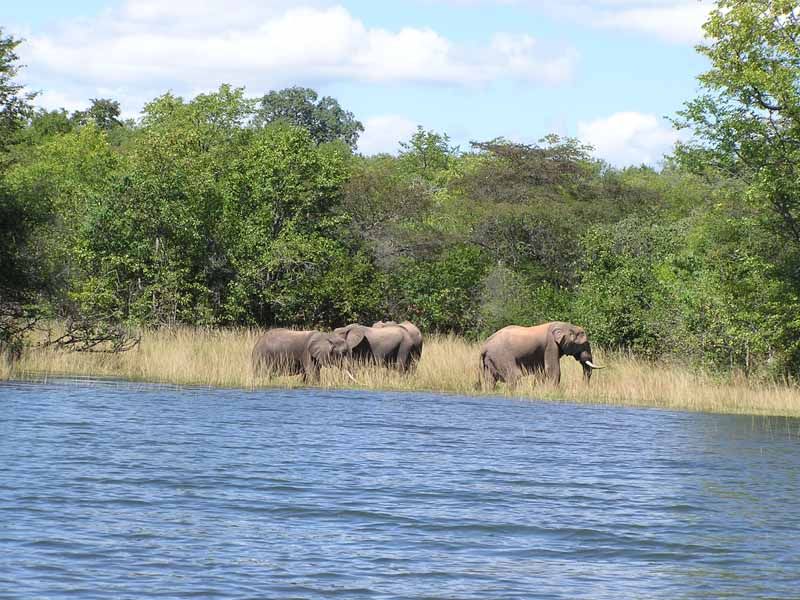 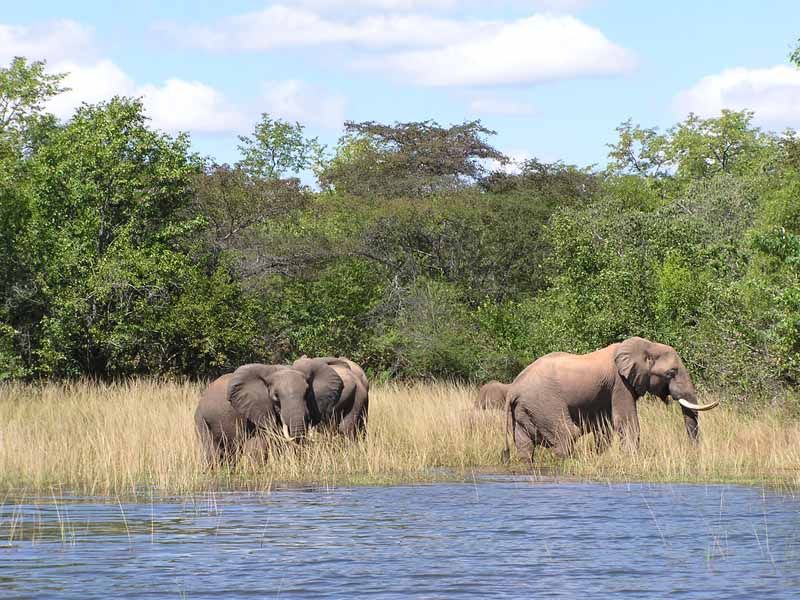 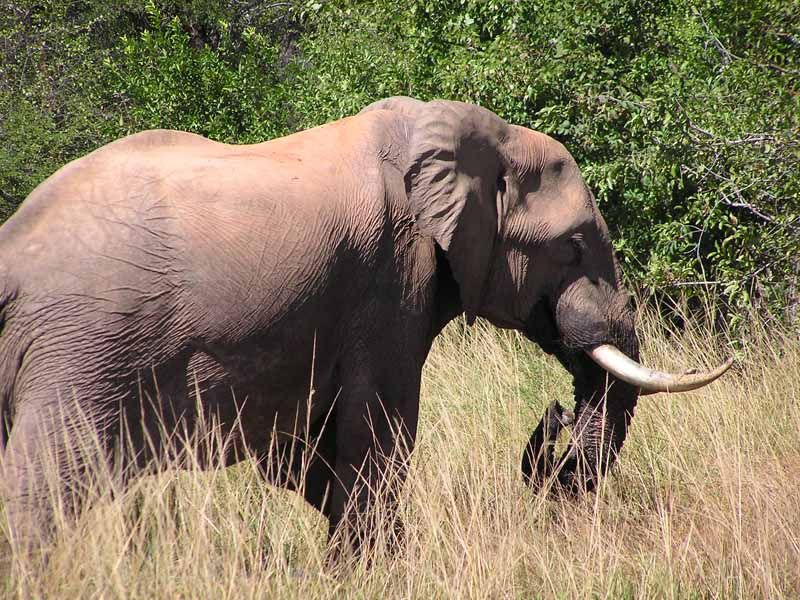 Lake Kariba speedbumps (I’m joking!) 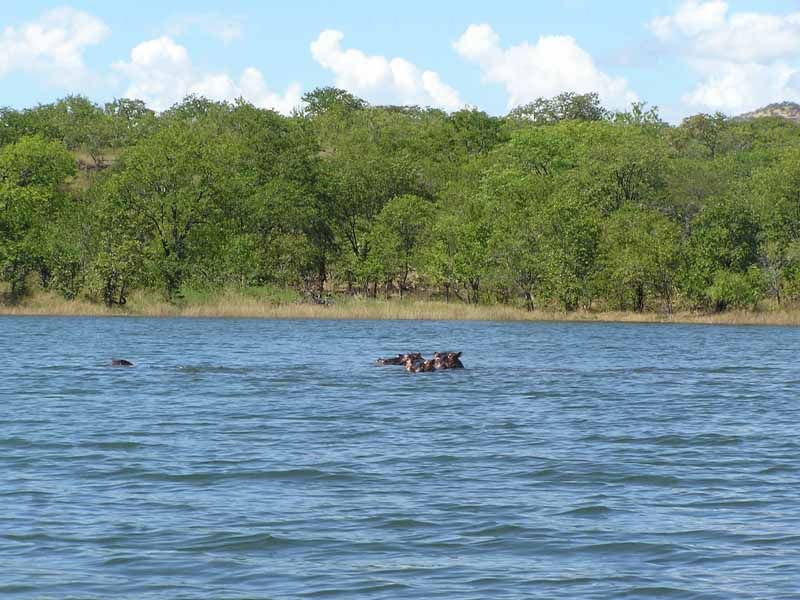 Later that afternoon, we went back into the jesse following a herd of elephant. It was more of the usual, swirling winds and switched on elephant, plus a satellite bull that we kept bumping. With light fading and the elephant booking, we called off the stalk. We were all tired and a bit edgy, but overall in fine spirits, which made for some good humor. On the way out, Roy runs by me, busting thru the entanglement of bush, mumbling something about “going crazy in this bleeping stupid bleeping jesse”. DAY-8 HUNTING – CROCODILE The following morning we were at it again, everybody somewhat groggy from the previous seven days. Perhaps out of force of habit, we drove Tiger Bay way, looking for tracks, hoping to get on the elephant before they entered the jesse. We found footprints, mounted up, and began walking. Initially it appeared as though we were gaining on them, but as the morning wore on it was clear that they had indeed been feeding where we found their spoor, but around sunrise of shortly thereafter they must have hit the trail as their tracks indicated that they were walking without stopping. Based on their movement, Steven thought this to be the same herd that we tracked days earlier to the Red Cliffs, where we were picked up by the guys in the boat. These elephant were good. After 4-4.5hrs of walking, we ended up in the same general area as before, by the big baobabs. Dalt made a bee-line back to the truck, while we did pushups and sit-ups in the shady, cool, soft, sandy soil. Well, I did have to sit-up once or twice. With no other viable options, and not enough meat to bait randomly, we decided to go back to the location along the Ume where we had been before, to see if we couldn’t put a croc in the salt. Brett and I knocked around camp for a few hours, while Dalt and a few of the guys worked on the blind and scoped out the crocs. At around 3pm, we drove to the spot, not far from camp. The blind was nice, lots of room and with two chairs in the front, one for me and the other for Brett so he could watch the action. I adjusted the gun rest, made out of branches, and draped my outer shirt over the top branch to provide a more secure base and protect the wood on the .375. In hindsight, I should have cut a notch in the branch, as it was still a bit wobbly. I fiddled with the scope, adjusting the setting from 4x to 8x and then back down to 6x. Putting the finishing touches on the blind  Chumming the water with scraps 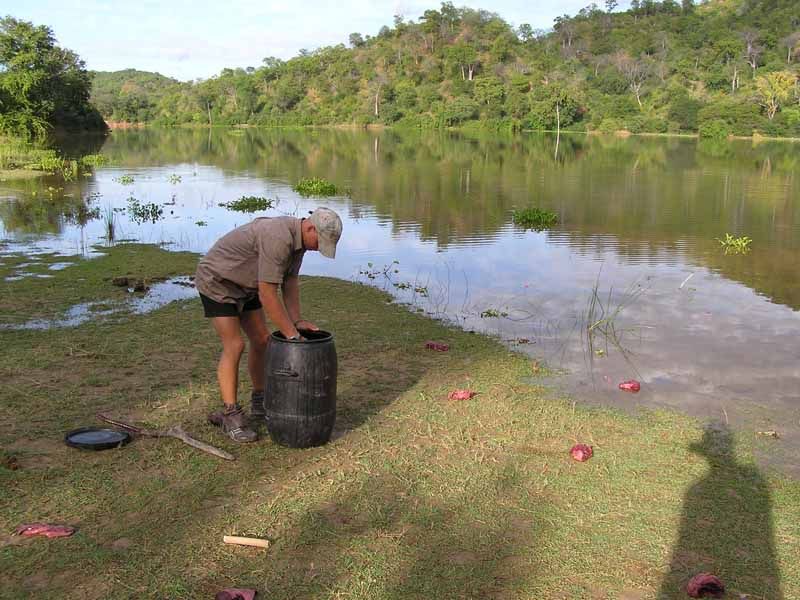 Sorry….this is just sick 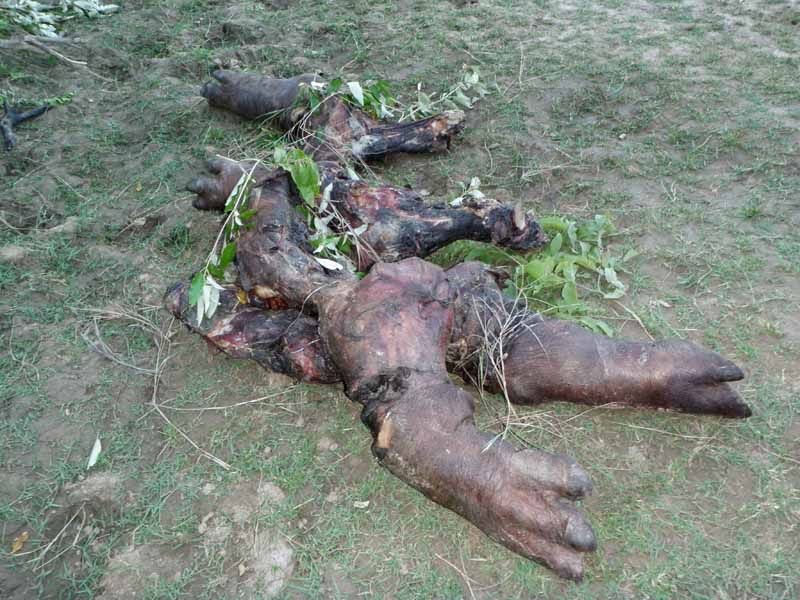 It didn’t take long for things to start happening. First the vultures came in , then a few of the smaller crocs, followed by the big boys. We had the same cast of characters as last time, including Needle Head and Toothy. They were a bit more spooky, and one would get a smell or just freak himself out, and flip back into the water, taking the others with him. Five minutes later, and they slithered back on shore. Toothy was coming far up the bank, and we watched him closely. As I am sure Mart was hoping, I wanted him. But the problem was he was at an odd angle to us, perfect for a head-on or angled brain attempt, but no good for a spine shot. So, patiently, we waited and watched the show. Into the water, wait, back out again. Finally, Toothy gave me a good angle, and as soon as a smaller croc behind him cleared, a squeezed off the shot. Toothy flinched, and much to surprise, remained motionless. I cycled the bolt, and Mart said to do what I was planning on anyway, and I put another one into his neck, this time farther back. Still nothing. Martin said “Lets go”, and we raced out of the blind and down to the croc. He was immobilized, but his eyes were still open and blinking. I was juiced and seriously over-reacting at this point, and I am glad that I didn’t jump on his back. Another shot into the heart/lung area turned out the lights for good. While not a huge croc, he was old and quite emaciated, with excess skin hanging on his shoulders and legs. Counting the remaining “fins” and comparing it to those we had seen at the Croc Farm, we estimated that he would have been perhaps 14-foot had another croc not chowed down on his tail. The shot had been almost perfect, I should have shot an inch or so higher to compensate for the difference in elevation, but obviously it was good enough as it took out his spine. And…he didn’t charge!  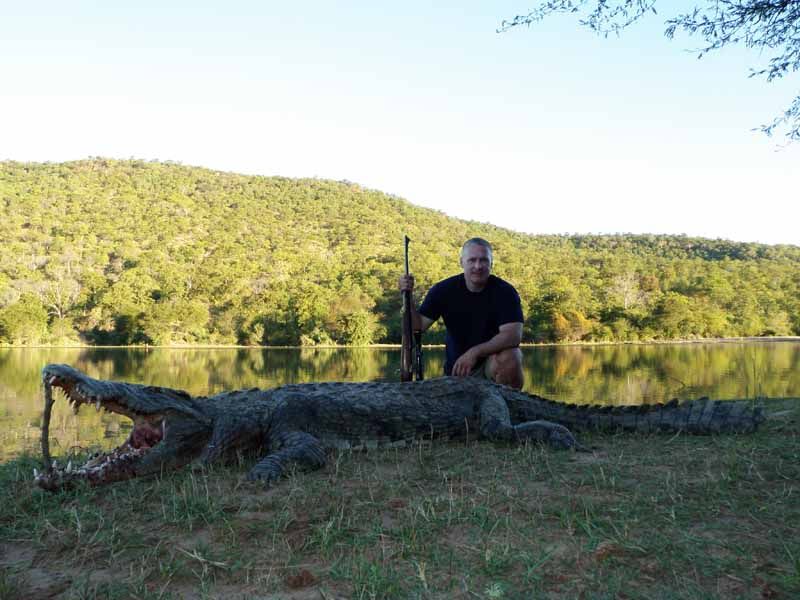  DAY-9 HUNTING – ELEPHANT BULL Still in search of a tuskless elephant, we drove to Steve’s village in the Kauzhina Hills region, where Steve said there is usually elephant, especially later in the year. As it was early in the season, nobody from Martin’s camp had yet hunted this particular area. The hopes were that we would be able to find tracks and get on the elephants before they disappeared into the thick stuff. We found tracks from the previous night, and followed. The terrain was somewhat challenging, with the tall brown grass hiding the devilish round rocks hidden underneath. Given the difficult terrain (hard, rocky, grass), after about an hour we lost the tracks, and began walking one of the game paths heading towards the water, hoping to pick them up again. After another hour so of walking and glassing, we found the tracks, but they were headed the wrong direction. We had obviously cut their path, and perhaps missed the herd amongst the bush canopy, or this was from a different cow herd. We stopped for a water break, and as the morning was ticking away, decided to keep walking with the wind to our advantage in the hopes of picking up another group. We had not gone more than a quarter mile when one of the trackers at the back of the line excitedly began pointing thru the bush at a grey figure standing perhaps a hundred yards to our right. Without using the binoculars, it was evident that this was a magnificent bull elephant with long ivory extending almost down to ground level. Our immediate thought was that he had probably come out of the Park miles away, and having gotten this big and old by NOT being stupid - would most certainly flee at the first sign of trouble. We moved fast, Martin and I approaching as rapidly yet as silently as possible. The elephant was feeding away from us, moving from one patchy area of green bush to another, and all that I could see from in front of his round mid-section was the two long protruding tusks. It all happened fast, and without the benefit of prior discussion regarding the approach, ivory or finances. Mart said right afterwards, when you see an elephant like this, you act quickly and decisively, otherwise it can disappear forever from wherever it came. The elephant became aware of our presence, and like bulls do, swung around head high. The elephant was shot and died quickly with a bullet to the brain. When we approached the downed elephant, it became clear that he was rather small-bodied, and although the tusks were long and beautiful, they were thin and likely once weighed will not be the “70 pounder” that one might think, noting that weight is just one criteria to consider when judging the quality of ivory. Also, the elephant was wearing an electronic tracking device (a "collar"). I was quite concerned, but after further discussion, Martin and the gang were CERTAIN that it was an old collar from the mid to late 1990’s, when there had been an active and sanctioned program tracking elephant movement in the Matusadona and other National Parks. We were even a bit angry that whoever collared this elephant didn’t remove the collar after the imagined “scientific study” was completed but figured that at such time Parks had no money as this was when the upheaval started in Zimbabwe. Remember, Zim has been cash-poor for a decade, and it was all Parks could do to survive - saved largely by the monies brought in by the hunting community. No other possibility entered our minds, and Martin assured me and was certain that there was no active local program going on as given his involvement in the hunting community and organizations, certainly he would have known. The muddy leather collar was cut off and examined, and we were surprised to find a very heavy lead weight at the bottom, required to keep the tracking device centered a top the elephant. Under this tracking device, the skin was rubbed raw and looked infected, and it was without doubt uncomfortable for the elephant at the very least. It was days later that I learned the actual story behind the collar. Information that I have read states that this elephant was collared by private individuals using private funding obtained from two reputable conservation organizations, the primary one being mostly active in Botswana. The elephant was reportedly darted on an island off the coast in a Parks area that is leased and operated as a photographic camp by an ex-Parks employee, now Guide. The bull had apparently swum there last August or so, when it was seen and collared. I get this. Obviously if I were a photo-camp operator I would have been thrilled by this, just as the guys in Mana Pools are in regards to the elephants and lion prides that have taken up residence there (although they do wonder out of Mana and get shot). But - THIS ELEPHANT was NOT collared for scientific research. I read where the reason for the collaring was that they “felt the elephant was in danger due to his proximity to a hunting area.” Collaring an animal to prevent it from being legally hunted and shot is not a legitimate justification (and may in fact have been illegal!!!), not in Zimbabwe at least, especially given the fact that there is no law preventing the shooting of a collared animal as confirmed by National Parks, SOAZ, ZPHGA and personally to me by Don Heath. It was also written that by collaring this elephant, he was less likely to be poached, as the poachers would fear the attention brought on by the tracking device. While this is a noble effort, I am not sure that it acts as a real deterrent, given the hammering that even monitored white and black rhino are taking across Zim. As an animal lover (some will find this very hard to believe), I understand their motivations, including the emotional as well as the financial, in wanting to protect this elephant from harm of any kind. The location of the shooting was well within the hunting area, some 3 kilometers from the Lake, which is considered a Parks Estate, and 11 kilometers from the Matusadona boundary. In fact, it is only a few clicks from where my friend Russell Marshall shot his elephant bull last year. The collar, which turned out to be a GPS unit, does not appear to have been used to collect any actual "data". The elephant was hunted 100% legally per a valid TR2 in a hunting concession, with a licensed PH and Game Scout present, hunting on foot in a ethical manner. There was nothing unnatural about this elephant, he was a wild animal, and there is no reason to think that he would not have been in the same exact location had a tracking collar not been placed around his neck. As a visiting sports hunter and huge proponent of Zimbabwe as a hunting destination over the years, on my sixth trip to the country including multiple during the “dark days” when few people (especially ecotourists) ventured to the country, I relied upon the professionalism of my guide and followed his instructions while balancing it with my own impression of the situation. As far as maturity goes, the bull was a perfect selection as he was perhaps 45-55 years old, and on his 6th and final set of molars. The local community will benefit as it does from every elephant legally hunted. He died quickly, and afterwards we showed him the utmost respect and admiration. All this being said, I am conflicted. In every African country that permits hunting, and even elsewhere in the world including in North America, one hunts the prime areas/concessions along a Park boundary as the Park replenishes the hunting area as excess animals filter out, and seasonal migrations and movement can offer excellent hunting for buffalo, elephant and plainsgame. As the hunting area acts as a buffer to the Park, and vice-verse, the entire “block” is better protected against poaching (assuming the operator spends money on anti-poaching, as Martin does) and habitat destruction. Although we were not hunting the boundary, an elephant can easily walk 40-50k’s in a single night. Which brings me to my most disturbing realization that this situation could have been avoided had there been BETTER COMMUNICATIONS between the non-consumptive and consumptive factions that are essentially competing for the same resources. Hindsight is 20-20 and we cannot undo what has been done, but had the hunting community been approached, and something said to the effect of “Hey, there is this magnificent bull elephant that will be great for our business and tourism to the area, currently staying in a small protected island. As most certainly he will at some point wonder back out of this protected area and likely into the local hunting concessions, here’s what we want to do and why, here’s what we are prepared to do, and we ask for your cooperation...”, I am hopeful Martin, Joe Wright, the Omay Council, SOAZ, ZPHGA and everybody else would have agreed, and upon seeing this bull we would have quickly put two and two together and taken pictures instead. I would have been happy with this, just as I am with other “off limits” game such as cheetah, painted dogs and rhino which are a privilege and thrill to see in the wild. And for the record, I would absolutely not have shot this elephant had it not been for the guidance and strong encouragement of my professional hunter, and had I known it was wearing an active collar (for real scientific purposes, or not), I would have absolutely declined. I trusted my professional hunter, and the possibility of encountering a collared elephant while hunting had never entered my mind. I had heard of collared lion, but never an elephant. It is clear to me that the reason nobody was advised of this elephant, was that it had been darted and collared "improperly" and that the people responsible were purposely trying to fly below the radar. Nothing else makes sense. I hope that with time, the reasonable photographic operators and conservation groups will ultimately come to understand that we are all on the SAME TEAM and this is a much bigger issue than that of a single animal, and in the end by saving habitat by limiting human encroachment, controlling poaching and illegal trade, and adding value to the animals thru both consumptive and non-consumptive use, we will save for our grandchildren the remaining pockets of animals that we all cherish. The first recipients of the meat were the women who assisted with the cutting of the recovery road, and the wives of the men that were selected to skin and butcher the carcass. These women were among the first ones to the scene, but not the last, as there was at least 100 people present and more coming from miles away as we departed some 6 hours after the kill took place. 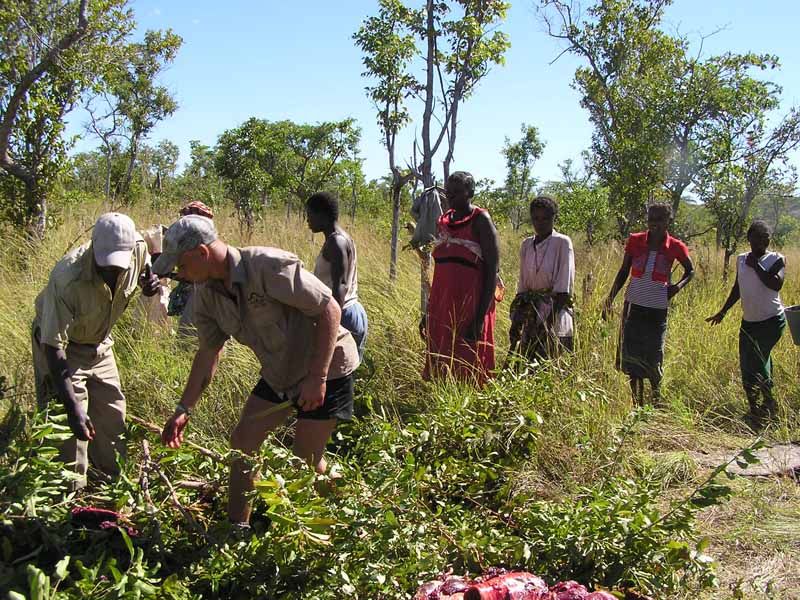 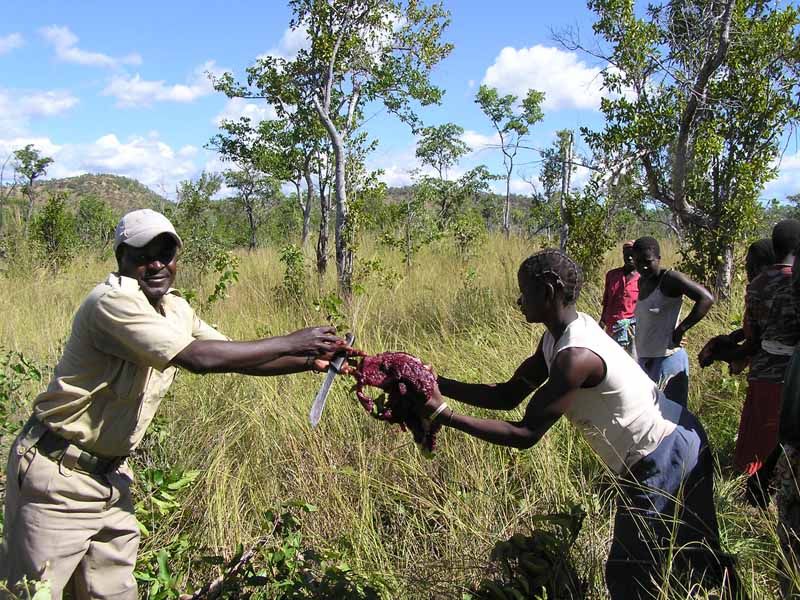 A rear leg and shoulder was given to the old women, so that she and her daughters would not need to compete in the fray that was soon to ensue. Needless to say, everybody was very happy and appreciative.  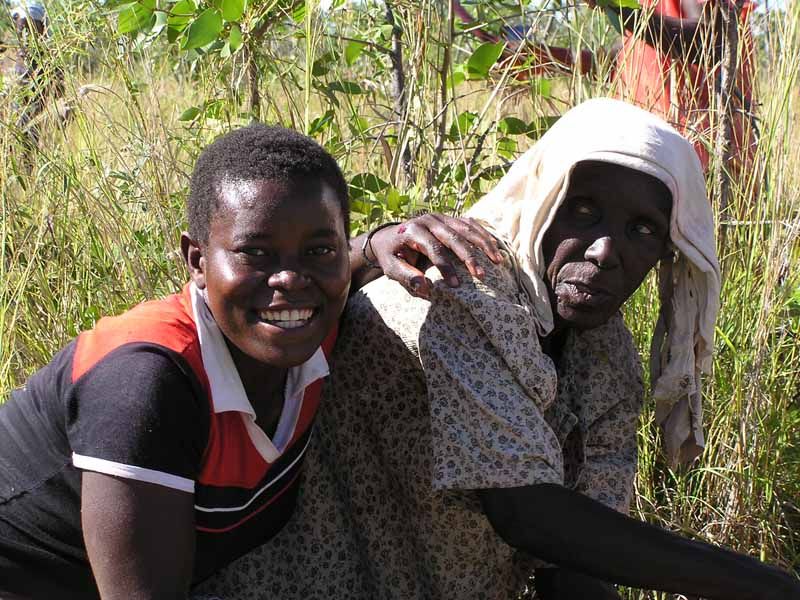 Once the elephant had been skinned, our team backed off, and allowed the men to begin carving off pieces of meat. While somewhat more controlled than the recovery of the cow elephant, it was still a madhouse of stabbing knives and flying meat. The plan is to as quickly as possible, hack off chunks of meat and throw them backwards to your friend or family member waiting with a bucket or basket in which to carry the meat back home. 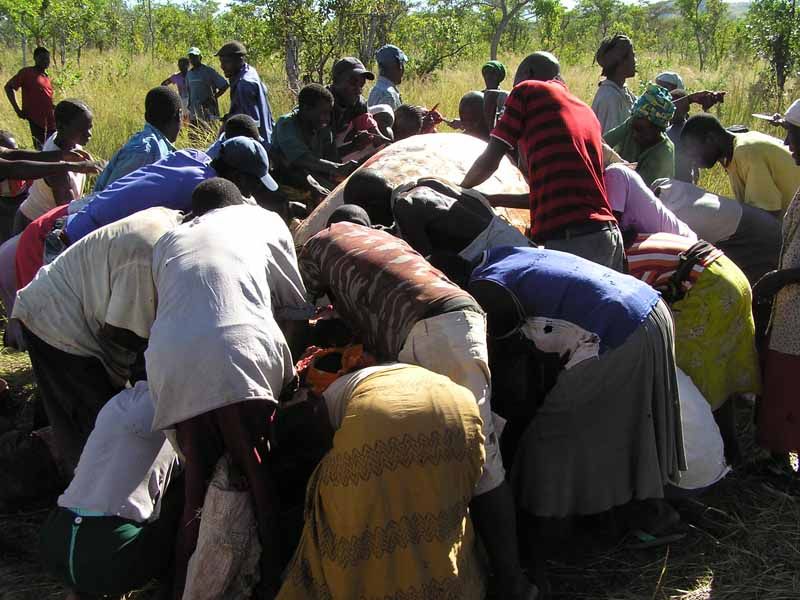 When we left, the group stopped cutting for a brief moment, and gave us a big cheer and “thank you”, something that I have never experienced before. On the way out, we stopped by Steve’s village, and gave a few buckets of meat to his wife. Below is a picture of his wife and child. All the meat was utilized by the local people, the trunk delivered to Chief Mola, and the ~$10,000 trophy fee paid to Council, to be split between the Omay Council and Ward/Village where it was shot. 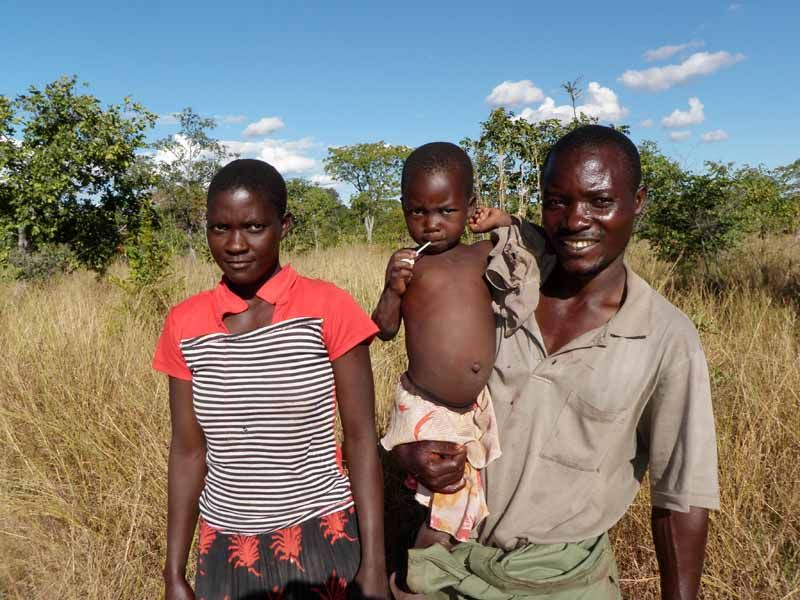 DAY-10 - CHILL DAY Given the whirlwind of activity the previous days, and the related impact on my budget (!), today was spent mostly relaxing and kicking around camp...fishing from the shoreline, catching football, talking with the other hunters in camp, catching up on my journal, checking out the trophies in the skinning shed, eating vast quantities of biltong, etc. Also in camp with us was Scout, Gerhard’s tracking dog and companion. Scout is a great camp dog, and over the course of our stay quickly learned the do’s and don’ts of camp life (such as, don’t jump, stay out of the cabins, don’t beg, and most importantly – do not steal the biltong!). Brett and I enjoyed his company and eagerness to participate in whatever was going on at the time, whether it was a walk to the water or a game of catch. He would patiently lay, watching your eyes closely for any indication of action or a command, and once given was 100% dedicated to the task at hand. Owning a lovable but sometimes frustrating Husky, I found Scout to be one cool dog! Brett & Scout fishing along the shore by camp 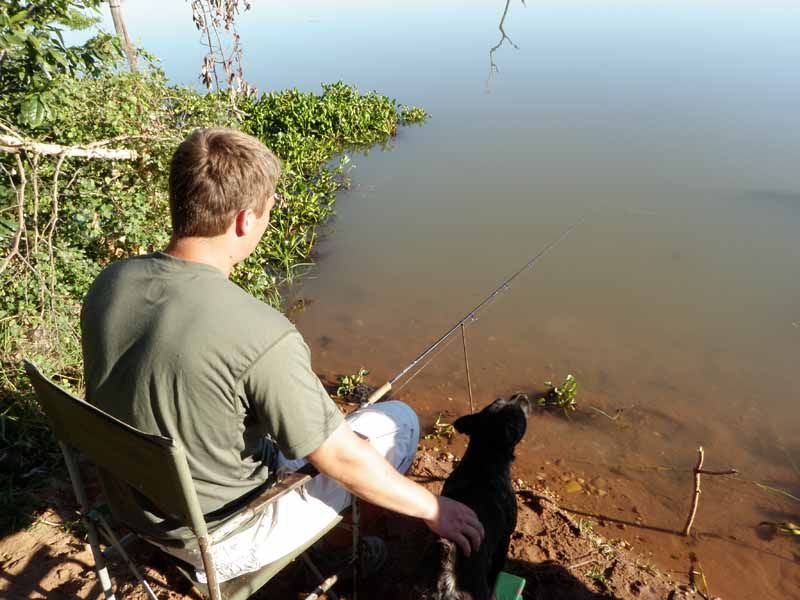 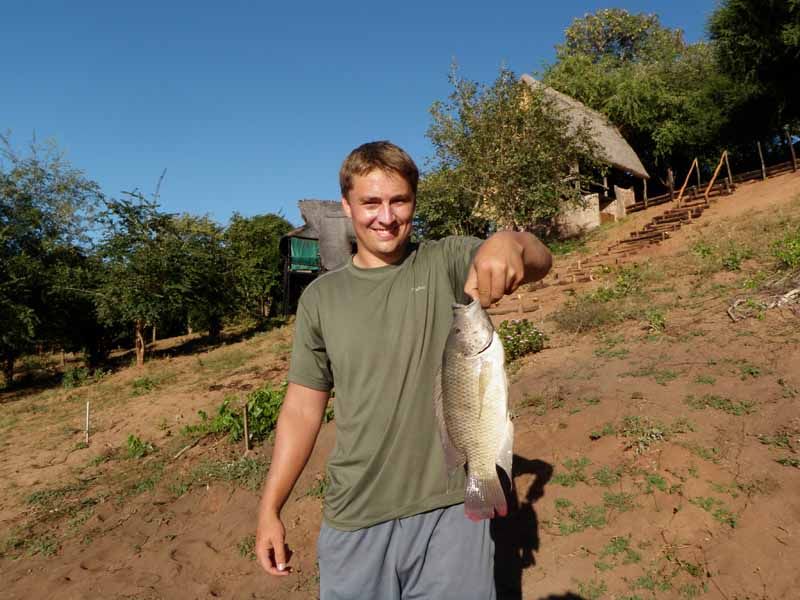 Late afternoon we walked a beautiful stream bed and worked up quite a sweat. We saw tons of spoor, including that of a couple of dagga boy buffalo bulls which were traversing the same path along and parallel to the river that we were. 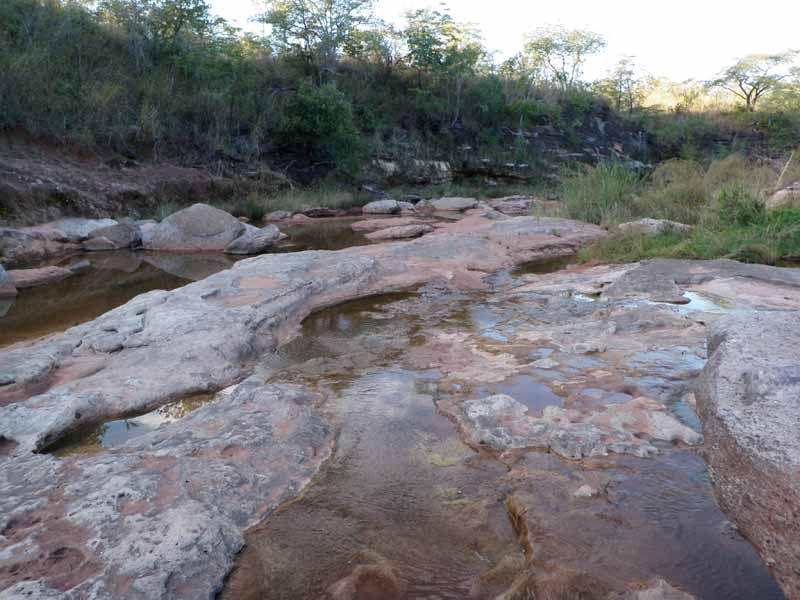 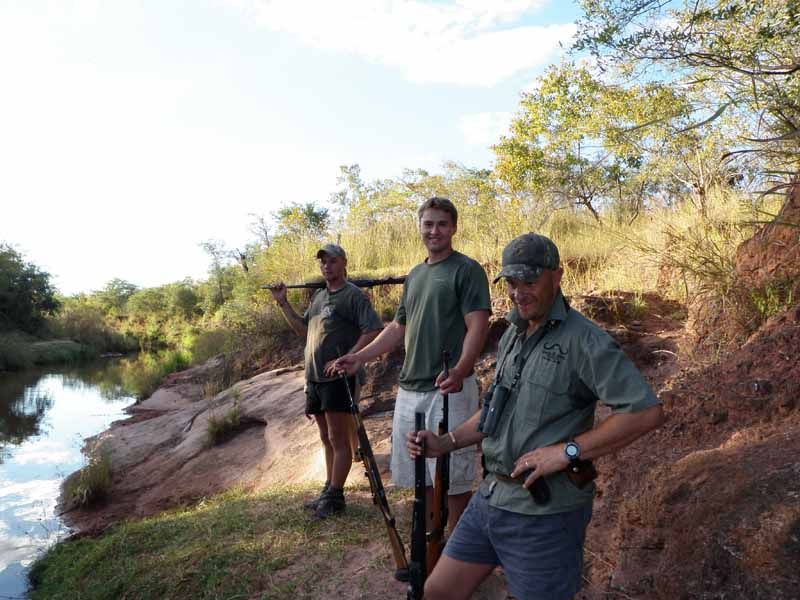 That evening we made our plans for the remaining days. Tomorrow (Wednesday) we would remain in camp and do some proper fishing, but instead of driving Friday we made arrangements to head back a day early and use the available day to site see around Bulawayo. Dinner was fresh bream (also referred to in Africa as “tilapia”, both of which are common names for nearly a hundred different species of fish), which everybody enjoyed including the two father/son teams of buffalo hunters who were now working up quite an appetite, spending their days in the field. Roy’s father, Richard Aylward was in camp, having driven one of the other groups in from Bulawayo a few days prior. Now retired, Richard spend most of his life out of doors, having worked for National Parks and various safari operators (tourist and hunting) over the years. He knew seemingly everybody. A quiet man and not one to talk to hear his own voice, whenever a topic came up and he was asked for his opinion, a wealth of information and perspectives poured out. There seemed to be no subject related to hunting, the bush, conservation, game ranching, or field mechanics that was outside his scope of knowledge, gained from years of hands-on experience. We enjoyed his company in camp very much. I lost my father at 18, and kept thinking what a lucky man Roy is to still have his father and be able to spend time with him. From watching them interact, it was obvious that he realizes this too. DAY-11 - FISHING With our guns packed away, the highlight of the day was a boat ride to a fishing “hot spot” where we caught an assortment of fish, including bream, squeakers, silver barbel, and a few small tigers. We were not terribly serious, and I find that while I love the idea of a relaxing day spent on the water fishing, the actual practice of passive fishing bores me. But the conversation was spirited, the sun hot, the sights wonderful, and the ice box cold.  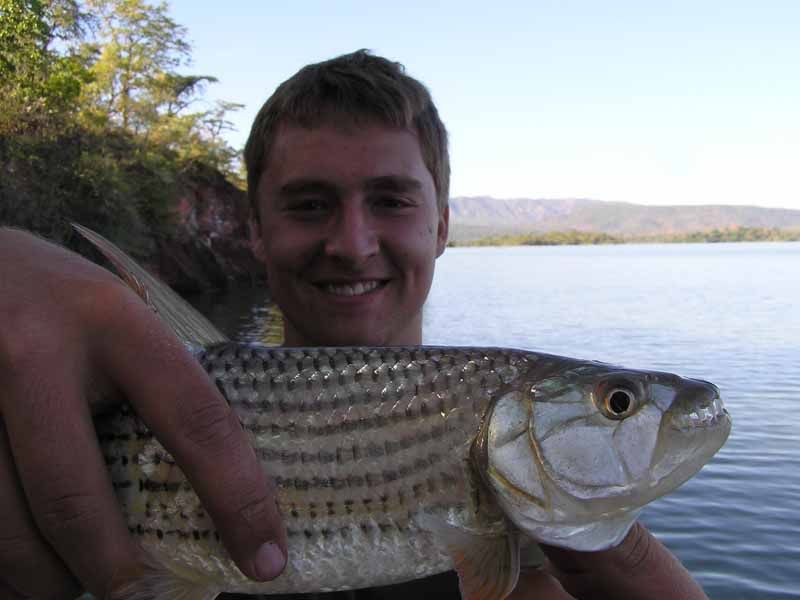 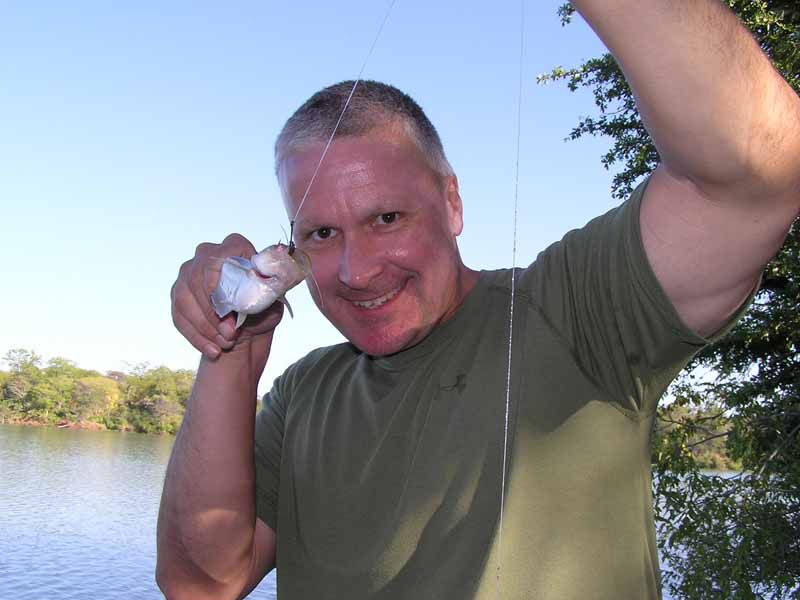 A “for profit” poacher apprehended and being taken to the National Parks camp, where he gave up the names of several others  We took a ride around the inlet, venturing into the various bays and streams, still marveling at how high the water was and how far we were able to penetrate into the bush by boat.  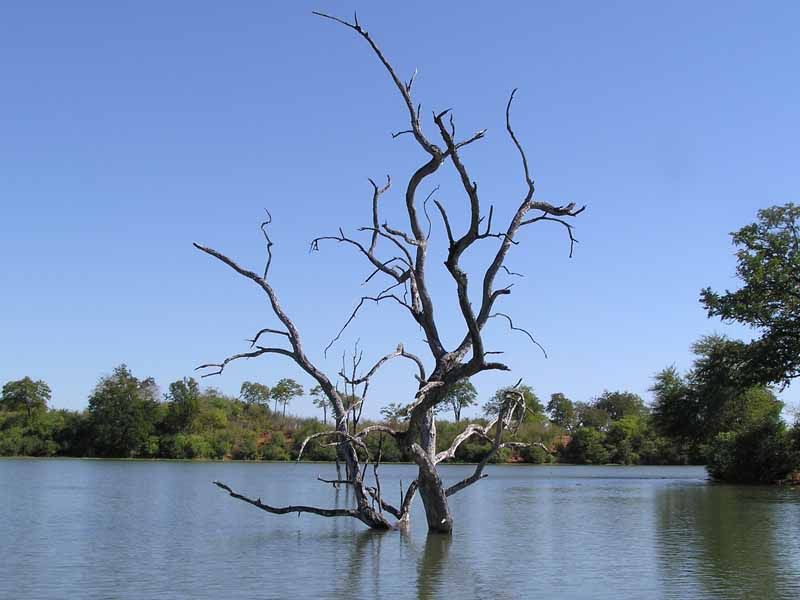 While Mart and the guys did a reverse beer run to the Tiger Bay Lodge (there was a large group of sailboats there, and they ran out of petrol and beer, so Mart unselfishly delivered five cases of Zambezi and some gasoline…although I suspect that one of the cases was a little short by the time they arrived), Brett and I fished along the bank, watching the sun set (picture at the end of the report), before the mosquitoes came out to dine. We caught quite a few bream (and when I say “we”, I mean Brett). | |||
|
| one of us |
DAY-12 – TRAVEL DAY Most of the day was spent retracing our steps of what seemed just a few days ago. I could not believe that the time had already come to begin the journey home. This is always a sad time, as none of us really ever knows if we will have the opportunity to return again. I hope and plan to soon, but one day, the farewell I bid to Africa will indeed be my last. Delivering the tusks from the elephant cow that charged to the Council office 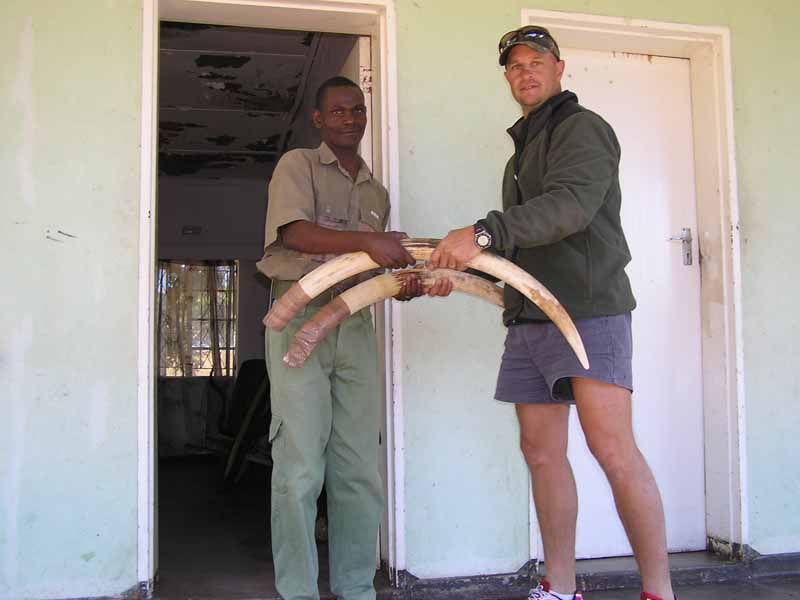 Sometimes a picture just speaks for itself! 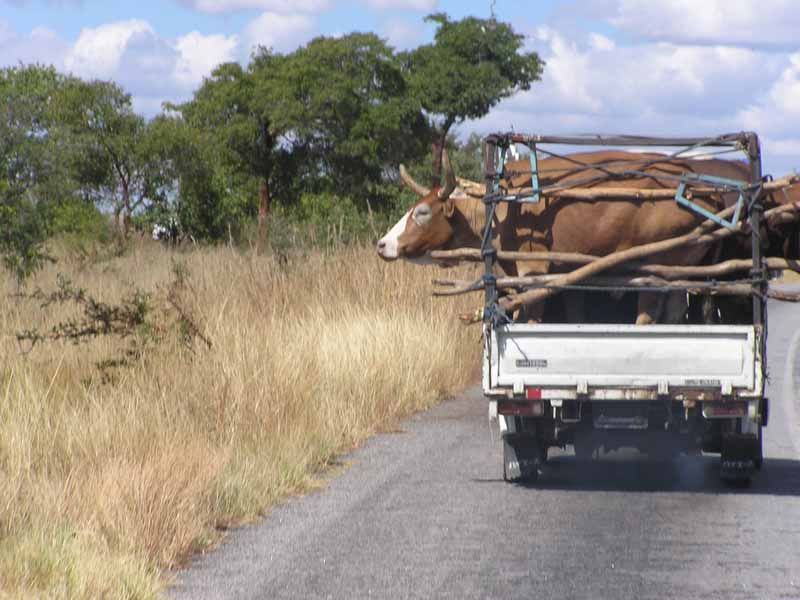 Mart’s wife Candy had made arrangements for Brett, Dalt and myself to stay at Camp Amalinda, an upscale safari lodge nestled in the granite Motobo Hills, about 40 minutes outside of Bulawayo. Below is a link to the website for the lodge, and I would recommend that anybody looking to add a few days to a safari considering spending some time here. Owned by Sharon and Phil Stead, Amalinda has affiliations with the Bulawayo Club as well as a safari lodge in Hwange. The accommodations are fabulous, the food excellent, and the staff amazingly accommodating. Camp Amalinda: http://www.campamalinda.com Pictures of Amalinda 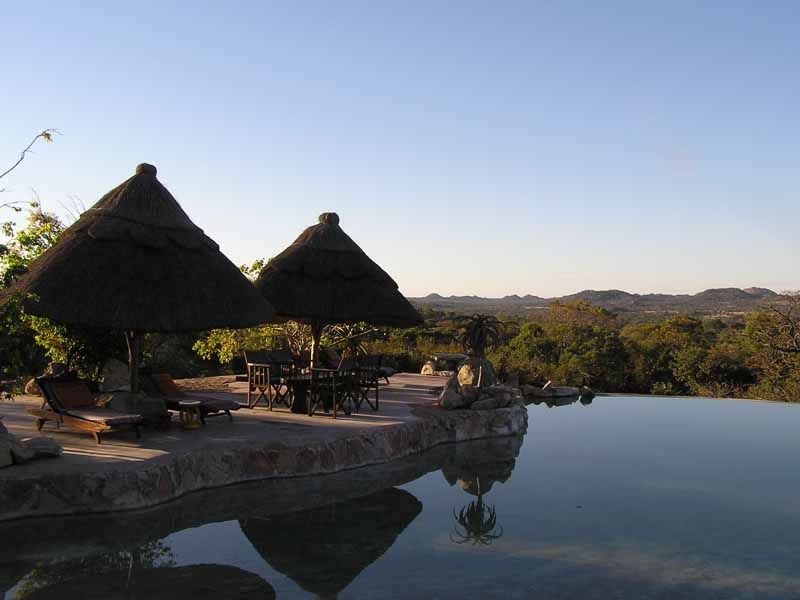  DAY-13 – MATOBO HILLS I was able to check off an item on my Bucket List today - Visit a Bushman Cave. Check! Dalt made arrangements for a Game Drive with Guide Paul, who stayed with us most of the day, and worked hard to show us around the Park. We arrived at the Park gates at 6am, having to fetch the Park Ranger to let us in. The granite rock formations throughout the Park are amazing, and it is truly something that one needs to experience to appreciate. Matoba National Park: http://en.wikipedia.org/wiki/Matobo_National_Park 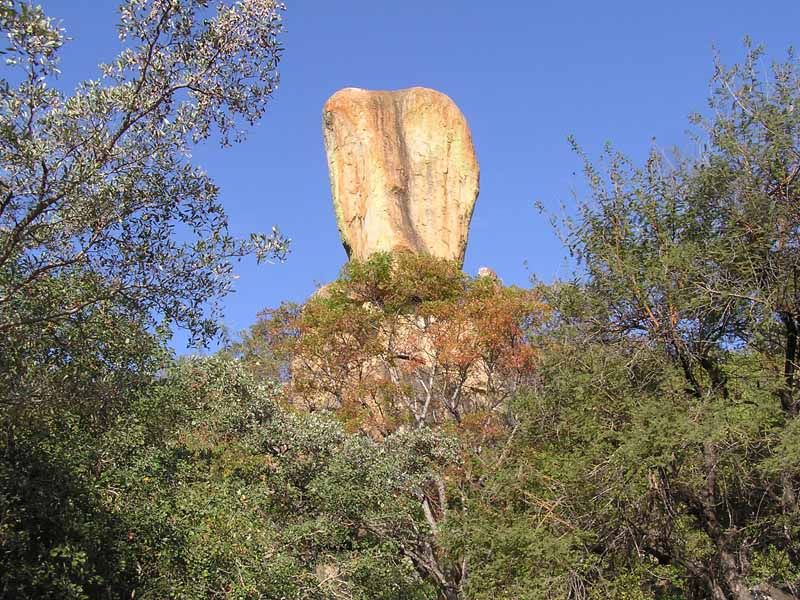 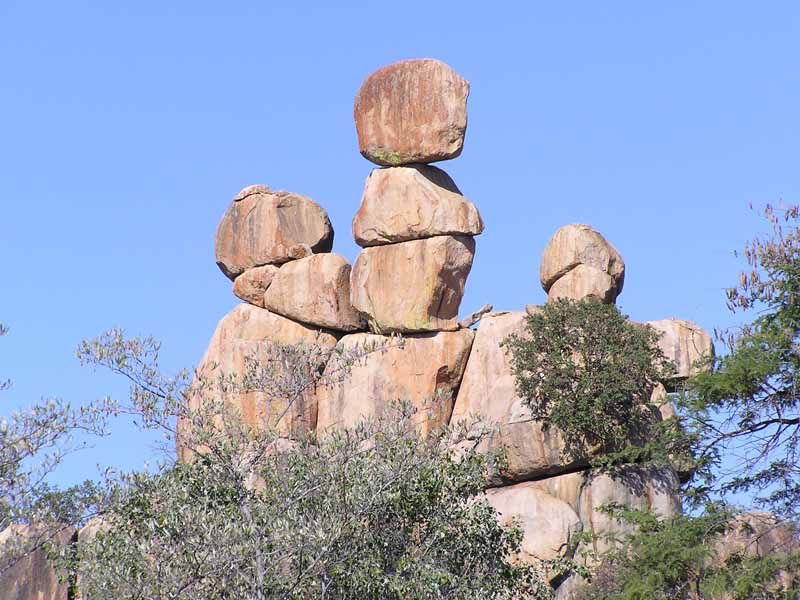 During the course of the cool morning, we saw a total of (9) white rhino, including the oldest bull in the Park. Paul said that there is officially estimated to be (40) white and (30) black rhino in the Park, but he thinks these numbers are high. As elsewhere in Zimbabwe, poaching is a problem and they have lost some rhino to poacher’s bullets. This being said, there appears to be adequate funding for Matoba, as we saw multiple groups of armed Rangers who walk patrol in the Park, and everything in the Park had a crisp, and dare I say “first World” feeling to it. Perhaps they were geared up for an anticipated surge in tourism due to the World Cup. We walked up on most of the rhino, including the first family (cow, calf, area bull) we encountered which was neat as we did not spot them from the truck but hiked into an area where Paul thought they would be. We did not see much else, however, as like in the Omay the bush was thick and plainsgame not overly abundant. Being a weekday, we pretty much have the Park to ourselves. 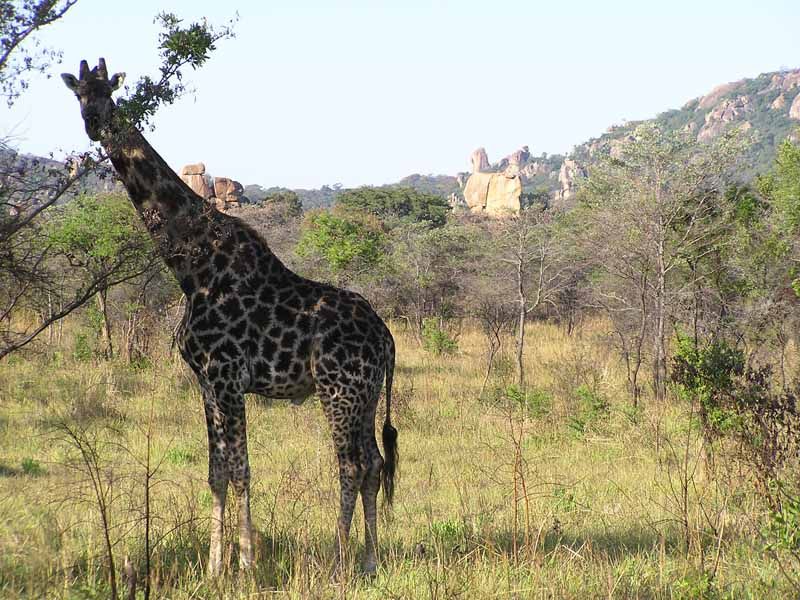 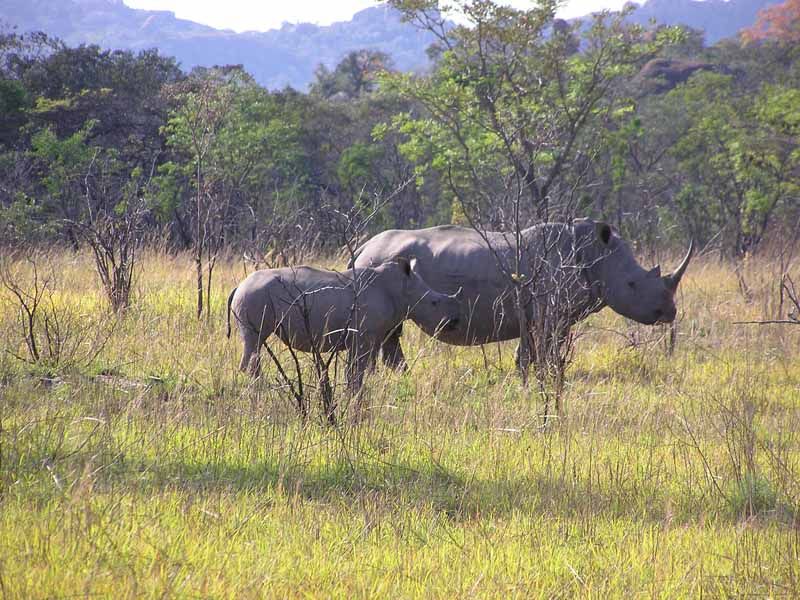 We went back to Amalinda for a huge breakfast, and relaxed until around 1pm when we hopped back on the Cruiser for a drive to the other two main attractions in the Park. The first was the Nswatugi Cave, which we opted to hike to versus driving. Brett and I found this fascinating, reluctant to leave. Sadly the bottom part of the cave drawings have been erased, Paul said a result of locals hiding their cattle during the war. What a shame that they survived thousands perhaps tens of thousands of years, only to be destroyed a few decades ago. Paul said that there are some areas that contain magnificent and unmolested cave paintings, and that if we return we should dedicate a few days as getting to them is part of the adventure. Sounds like fun! Amalinda’s open-air Cruiser, Paul at the wheel 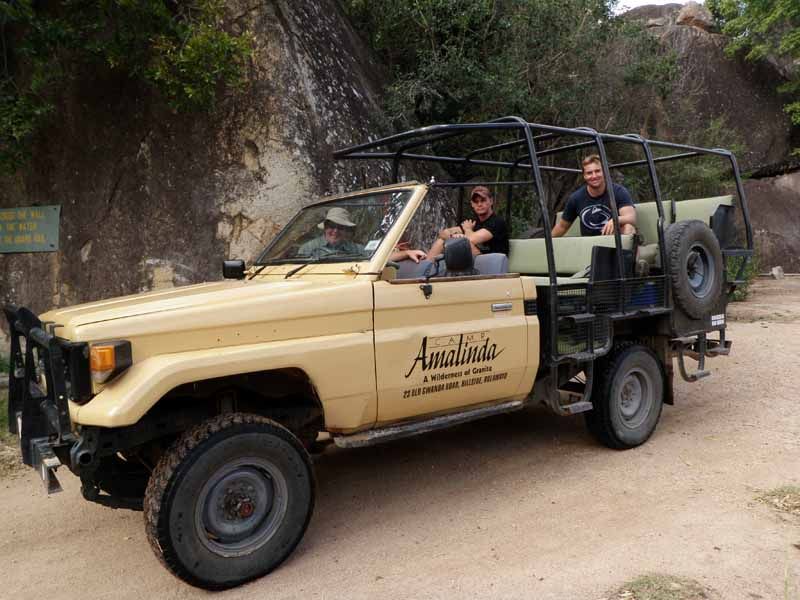 Stone age Bushman paintings in the Nswatugi Cave 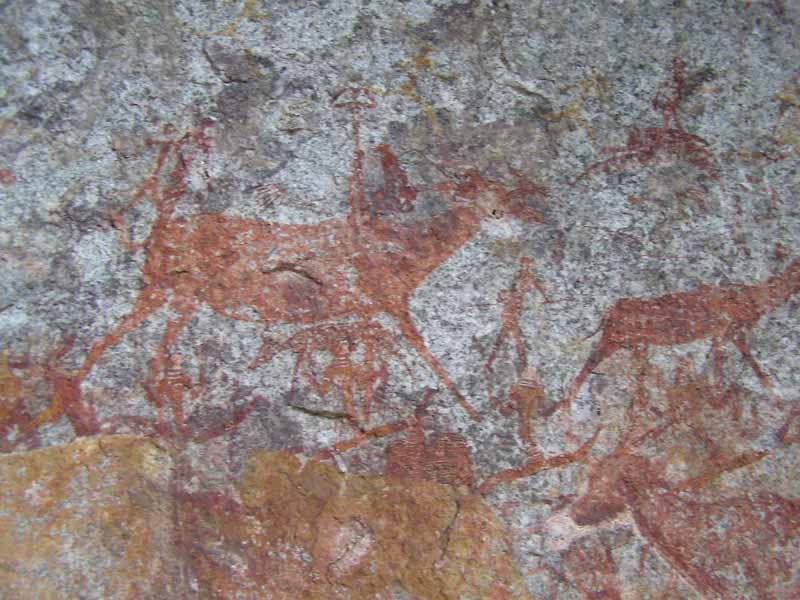  Our final stop was to Malindidzimu, also known as “View of the World” where the tombs of Cecil Rhodes, Leander Starr Jameson and Sir James Coghlan can be found, as well as the Allan Wilson Memorial commemorating the “Shangani Patrol” which stuck me as Zimbabwe’s “Little Bighorn”. Paul was proud of his country’s history, full of facts and interesting tidbits of information, and we all enjoyed being a tourist for the day. Shangani Patrol: http://en.wikipedia.org/wiki/Shangani_Patrol 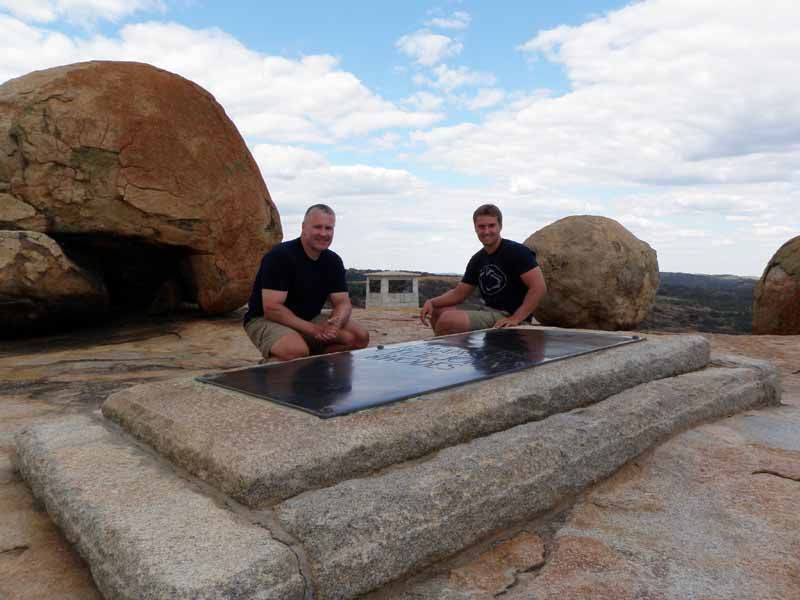 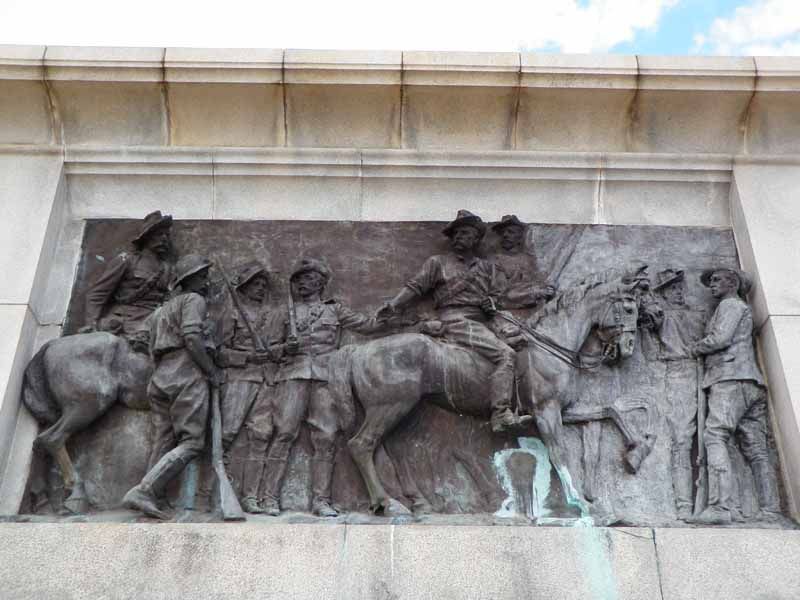 Amalinda was booked, hosting a teacher ("Head") conference, so Dalt dropped us off at the Bulawayo Club for the evening. Mart and Candy had us over for dinner, and our final goodbyes. Mart’s brother-in law, Ross, also a PH was there with his wife and we enjoyed their company, although with our minds on the journey that lay ahead and the realization that our time in Africa was over, I believe that Brett and I were a bit somber. TRAVEL HOME In the morning before Mart picked us up to take us to the airport, we had a chance to explore the Club a bit more. There was an art show scheduled featuring local artists scheduled for later in the day, and we could not resist taking a peek. I could not believe my eyes at the scenes depicted and the messages being sent. I will allow you to discover the paintings for yourself, but suffice to say that we may indeed be looking at a “New Zimbabwe".    Our journey back home, albeit long, was fairly uneventful. We experienced no problems departing Bulawayo with the firearms and remaining ammunition. However, the SAA flight to Johannesburg was about 1hr 45 minutes delayed, which caused us some stress in Johannesburg. The flight crew knew of our connecting flight, and said that a SAA representative would be there to meet us. This did not happen, so we scurried with two missionaries that befriended us in Bulawayo to the connecting flights desk for ticketing. Although our bags were checked all the way thru, we still need to get our boarding passes and seat assignments. I became a bit unglued at the person responsible for assisting connecting passengers with their flights, as he was useless and unwilling to bump us up in the long, slow-moving queue. Eventually, with the help from a mother/daughter from Zambia, we jipped the line and proceeded to the departure gate. The security checkpoints are extensive and exhausting, apparently a requirement of flights coming into the US. We managed to trade seats so that Brett and I could sit together (again, the seats that we had reserved months ago were lost when SAA downsized the plane). I slept quite a bit, and we arrived on-time in Dulles Sunday morning at around 6:00am. Customs ran smoothly, as did the firearms check-in thanks to a very polite and professional Customs agent. The only hiccup was a missing bag, which I fondly call Big Bertha. Bertha is a green Cabela’s duffle that has accompanied me on every one of my trips to Africa plus a number of other hunts and family vacations. Although heavy when filled, Bertha has never left me down, and in fact despite being a cloth duffle with no lock (and perhaps because of this!) I have never had anything stolen from Bertha. The United agents who filed my missing baggage claim were helpful, but I was not given a "File Reference Number" that could be used to track the case via the SAA website (http://www.worldtracer.aero/filedsp/sa.htm). I did have the original baggage claim number, but not the ticket which the agent kept. I forwarded the number to Kathi Klimes to help me track down Bertha. Wednesday afternoon, Bertha arrived on our front porch, delivered by Fed-Ex, no worse for the wear and with nothing missing. A very nice ending to an amazing adventure! CLOSING I would like to thank Martin, Candy, Dalton, Muffy and the entire crew at MP Safaris for doing their absolute best to insure that Brett and I had a great time, returning home safely with amazing memories and experiences that we will cherish for a lifetime. For anybody looking to have their hunt filmed, I cannot recommend Roy Aylward enough. He is as knowledgeable as many PH’s, an excellent cameraman and by all accounts editor, very clever with anything mechanical, and just a lot of fun to have around. And to Saeed and my friends on AR, thank you for allowing me to continue sharing my hunts and adventures with you, including the up, downs and in-betweens. I hope we all have many more years around the virtual campfire! I look forward to your replies and questions. Please feel free to PM or email me. Thank you. 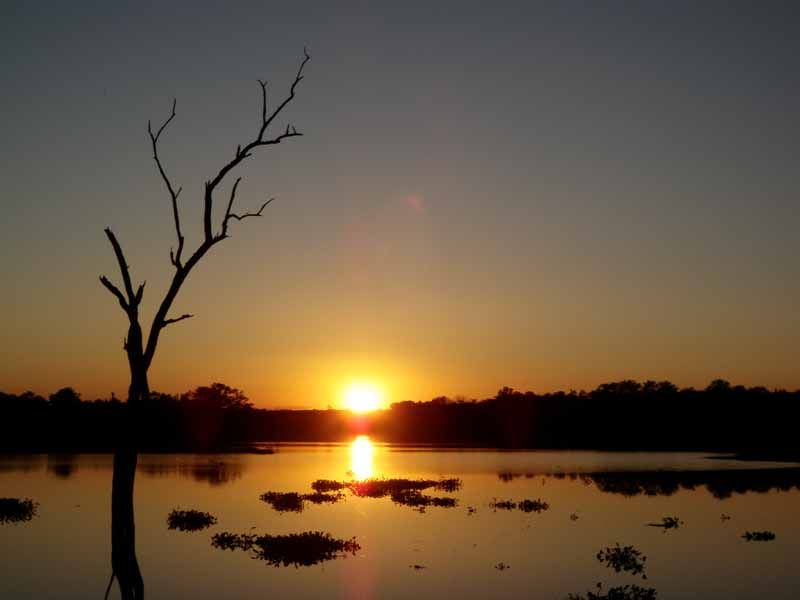 | |||
|
| one of us |
Splendid | |||
|
| one of us |
Thanks for the great report Bill. A little more detail would have been nice. J/K Two charges in one hunt! Frank "I don't know what there is about buffalo that frightens me so.....He looks like he hates you personally. He looks like you owe him money." - Robert Ruark, Horn of the Hunter, 1953 NRA Life, SAF Life, CRPA Life, DRSS lite | |||
|
| One of Us |
Wow! Many men wonder if they have what it takes to stand a charge, and do the right thing. Now you KNOW you can do it. And an extra atta boy for taking your son. Does not get any better than that. Thanks for the post, "You only gotta do one thing well to make it in this world" - J Joplin | |||
|
| One of Us |
Bill, many thanks for another excellent and well-written report, and congratulations on a great safari! Talk about excitement! Needless to say, to put down a charging elephant and hippo both, your shooting had to be fast and accurate! I'm sure happy that it was! And unprovoked charges at that! Too many people think that because an unprovoked charge is rare or unusual, it can't or won't happen to them. I would have visited the prophet, too (or whatever he was), after those kinds of close calls. Gotta shake that bad juju any way you can! Question: I'm pretty sure that I saw a human skull in one of your photos? What's the story there? And as far as the elephant collar is concerned, I say that your bull was cleanly and ethically taken, so there should be NO issues. Just a great read. Thanks, again. Mike Wilderness is my cathedral, and hunting is my prayer. | |||
|
| One of Us |
Excellent! Gray Ghost Hunting Safaris http://grayghostsafaris.com Phone: 615-860-4333 Email: hunts@grayghostsafaris.com NRA Benefactor DSC Professional Member SCI Member RMEF Life Member NWTF Guardian Life Sponsor NAHC Life Member Rowland Ward - SCI Scorer Took the wife the Eastern Cape for her first hunt: http://forums.accuratereloadin...6321043/m/6881000262 Hunting in the Stormberg, Winterberg and Hankey Mountains of the Eastern Cape 2018 http://forums.accuratereloadin...6321043/m/4801073142 Hunting the Eastern Cape, RSA May 22nd - June 15th 2007 http://forums.accuratereloadin...=810104007#810104007 16 Days in Zimbabwe: Leopard, plains game, fowl and more: http://forums.accuratereloadin...=212108409#212108409 Natal: Rhino, Croc, Nyala, Bushbuck and more http://forums.accuratereloadin...6321043/m/6341092311 Recent hunt in the Eastern Cape, August 2010: Pics added http://forums.accuratereloadin...261039941#9261039941 10 days in the Stormberg Mountains http://forums.accuratereloadin...6321043/m/7781081322 Back in the Stormberg Mountains with friends: May-June 2017 http://forums.accuratereloadin...6321043/m/6001078232 "Peace is that brief glorious moment in history when everybody stands around reloading" - Thomas Jefferson Every morning the Zebra wakes up knowing it must outrun the fastest Lion if it wants to stay alive. Every morning the Lion wakes up knowing it must outrun the slowest Zebra or it will starve. It makes no difference if you are a Zebra or a Lion; when the Sun comes up in Africa, you must wake up running...... "If you're being chased by a Lion, you don't have to be faster than the Lion, you just have to be faster than the person next to you." | |||
|
| one of us |
Bill, Great report and great pictures! Thanks for taking the time to post such an excellent report. BigBullet "Half the FUN of the travel is the esthetic of LOSTNESS" Ray Bradbury https://www.facebook.com/Natal...443607135825/?ref=hl | |||
|
| one of us |
Bill, seriously, if or when you write a book I will be the first in line to pick up a copy. Autographed, of course. And with four porters to help me carry it from the bookstore to my humble abode. Extremely well-written and honest hunt report, my friend. I wouldn't let the issue with the elephant detract from the trophy. I know you, I know Martin and I know both of you have high standards of integrity. Fairly chased, fairly taken. And I am sure your son had more of an adventure than he bargained for! I know his "ol man" did! Two charges in the jess in lifetime is rare, two charges in two days is hard to fathom... Well done. On the plains of hesitation lie the bleached bones of ten thousand, who on the dawn of victory lay down their weary heads resting, and there resting, died. If you can talk with crowds and keep your virtue, Or walk with Kings - nor lose the common touch... Yours is the Earth and everything that's in it, And - which is more - you'll be a Man, my son! - Rudyard Kipling Life grows grim without senseless indulgence. | |||
|
One of Us |
Bill, an outstanding piece of documented safari action. One never knows when in heavy cover what may happen. Thank you for a great report. Mike | |||
|
| One of Us |
That is the best hunting report I have read to date. Thank you. Dutch | |||
|
| one of us |
Excellent report- one of the best that I have ever read. Thanks for posting it. | |||
|
One of Us |
| |||
|
| One of Us |
Bill, congratulations on a great trip. Glad everyone came home safe and sound, full of memories. Mike | |||
|
| One of Us |
Good shooting! Great Adventure. Steve "He wins the most, who honour saves. Success is not the test." Ryan "Those who vote decide nothing. Those who count the vote decide everything." Stalin Tanzania 06 Argentina08 Argentina Australia06 Argentina 07 Namibia Arnhemland10 Belize2011 Moz04 Moz 09 | |||
|
| One of Us |
What an exciting hunt! Great shot in the hippo. I love those elephant tusks. Congratulations. | |||
|
| One of Us |
Absolute Stunner Bill !!! Well written and truly respectful of a gentlemen's safari. I am jealous, I am envious and I am extemely happy for you and your son. Cheers "How do we inspire ourselves to greatness when nothing less will do" -- Invictus | |||
|
| One of Us |
+1 | |||
|
| One of Us |
Great report and excellant pictures-thanks for sharing ! SCI DSC NRA NAHC DRSS | |||
|
| one of us |
Excellent hunt report! I'm curious, and maybe I missed this, but did you have a scope on your rifle when the charges occurred or did you use irons? ____________________________ If you died tomorrow, what would you have done today ... 2018 Zimbabwe - Tuskless w/ Nengasha Safaris 2011 Mozambique - Buffalo w/ Mashambanzou Safaris | |||
|
| One of Us |
BILL Your Hunt Reports ar by far the best on the NET. Sure you had a good time with your son again. Nice Croc and Ele. Congrats Nec Timor Nec Temeritas | |||
|
| One of Us |
Wonderful hunt and report, Bill. Thanks for taking the time to sit down and type your hunt reports. They are the best. | |||
|
| One of Us |
Hunting at it's very best. The rifle you speak of is a Fabrique Nationale (spelling?) made in Belgium or known to many simply as FN and built on a mauser action. The safety it typical of the older mausers. ROYAL KAFUE LTD Email - kafueroyal@gmail.com Tel/Whatsapp (00260) 975315144 Instagram - kafueroyal | |||
|
| One of Us |
Well done. You obviously made the most of all your trip and experienced so much. Is Roy Aylward going to 'publish' another video ? His first was so much more enjoyable than the 'Boddington product for the US market' DVD's. I have two of those The FN Mauser's. They take standard replacement Mauser 98 safetys. Strong Oaks is actually, an abbreviation of Strong Blokes, abbreviated to 'okes and pronounced by the locals oaks. | |||
|
One of Us |
Bill congratulations on a super hunt and thanks for the excellent report and pics. I have hunted from Ume river camp when it was operated by HHK, it is indeed a very beautiful place. Your bull ele is also exceptional for the area, well done. Ahmed Sultan | |||
|
One of Us |
Bill you've really raised the bar on AR hunt reports! I'm reading in installments! Outstanding so far! Brett DRSS Life Member SCI Life Member NRA Life Member WSF Rhyme of the Sheep Hunter May fordings never be too deep, And alders not too thick; May rock slides never be too steep And ridges not too slick. And may your bullets shoot as swell As Fred Bear's arrow's flew; And may your nose work just as well As Jack O'Connor's too. May winds be never at your tail When stalking down the steep; May bears be never on your trail When packing out your sheep. May the hundred pounds upon you Not make you break or trip; And may the plane in which you flew Await you at the strip. -Seth Peterson | |||
|
One of Us |
Bill's Ruger 458Lott has irons, Mike | |||
|
| One of Us |
Congrats bill Some of those photos look so familiar. The river you did the "African Queen"tour was most likely the river that the ele would escape across after raiding Villages in Mola. As we could not muster up a boat we had no option than to follow others. | |||
|
| One of Us |
Bill You really are going to have to hunt at a different time of year to me !! I am just about to post the report of my hunt, but your's is so good that nobody will want to read mine. Well done and glad to see you came through safely. Regards Rob | |||
|
| One of Us |
Bill that was the best report i have seen, thanks including all those extra pictures (non trophy pictures) | |||
|
| One of Us |
Excellent report & wonderful photos! JCHB. | |||
|
| One of Us |
Bill: Wow. You've poured heart and soul into this. Quite a report on quite a hunt. I'd not sweat the elephant collar for one more minute. Over here, folks do back flips when they shoot banded ducks and geese. They wear the bands around their necks like a badge of honor. Your ellie is not that much different IMHO. It was a banded elephant of sorts. No foul, period. The game played out fairly and ethically. Celebrate your success. Don't let the bastards get you down, ever. Welcome home and well done. Will J. Parks, III | |||
|
| one of us |
WHAT A FANTASTIC REPORT!!! Thanks for taking the time to make such a detailed hunt report with some really great photos. Elephant Hunter, Double Rifle Shooter Society, NRA Lifetime Member, Ten Safaris, in RSA, Namibia, Zimbabwe | |||
|
| One of Us |
Once again an awesome report, great photos, and well explained. The time and effort you put into the reports is appreciated. Congrats on a great hunt with your son at your side. The danger of civilization, of course, is that you will piss away your life on nonsense | |||
|
| One of Us |
Amazing report! I felt like I was there with you as I read along.. Thank for sharing this with us! | |||
|
| one of us |
Bill; All of us who have tried to keep a detailed journal of our safari, appreciates your effort and knows how time consuming it is. You managed to capture everything of interest. Your shooting wasn't so bad either. Congratulations on your fine trophies. Best regards, D. Nelson | |||
|
| one of us |
Da man, back home safe and planning OUR next adventure. Wonderful experiences you and your sons continue to build on and thanks once again for sharing your times with all of us. | |||
|
| One of Us |
Bill, I can understand your concern about shooting a radio-collared animal. In the west, if the Game dept. puts a radio collar on an animal they are still legal game. In zim I believe that such animals were off limits when parks put them on. As far as a private orginization radio collaring an animal. I doubt that that is legal unles they applied for a permit. If such animals are to be off limits it is up to Parks to notify the hunting community of the restriction. This was apparently not done so you have no responsibility to not shoot such an animal. Relax and enjoy a marvelous animal in th salt. 465H&H | |||
|
| Powered by Social Strata | Page 1 2 3 |
| Please Wait. Your request is being processed... |
|
 The Accurate Reloading Forums
The Accurate Reloading Forums  THE ACCURATE RELOADING.COM FORUMS
THE ACCURATE RELOADING.COM FORUMS  Hunting
Hunting  Hunting Reports - Africa
Hunting Reports - Africa  Zimbabwe 2010 - 2 Charges, Elephant, Croc & LOTS of Pictures
Zimbabwe 2010 - 2 Charges, Elephant, Croc & LOTS of Pictures

Visit our on-line store for AR Memorabilia

